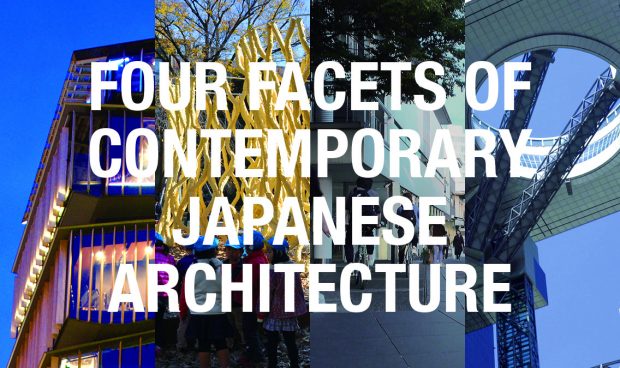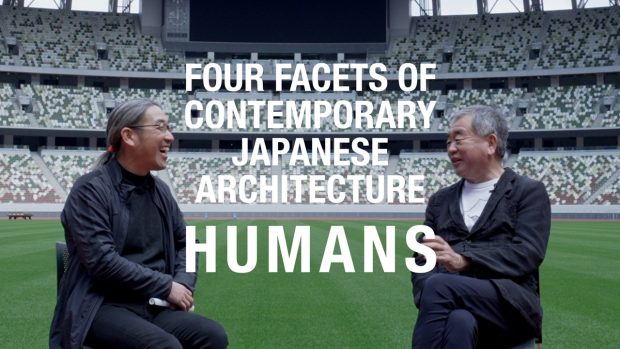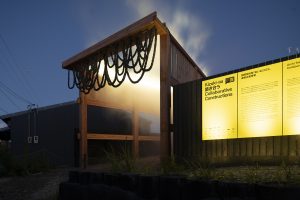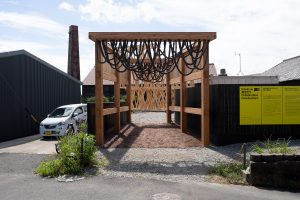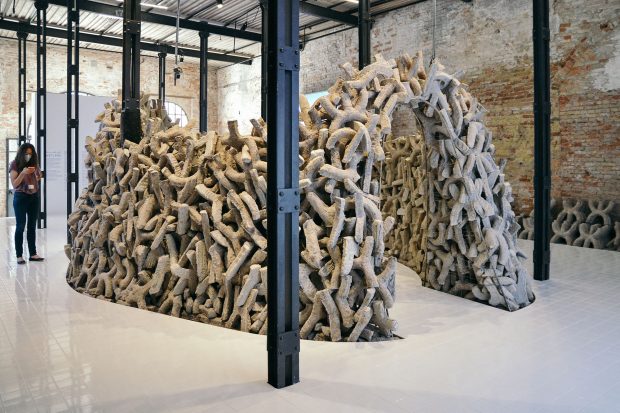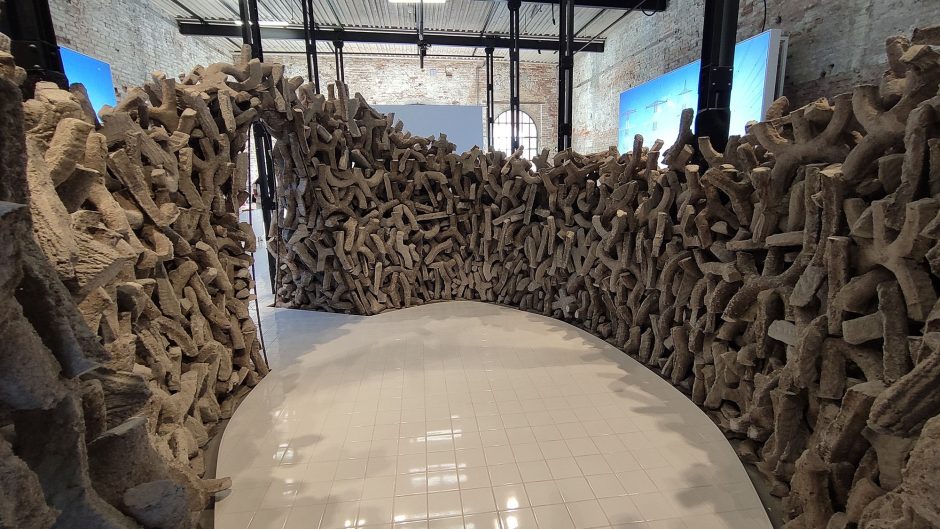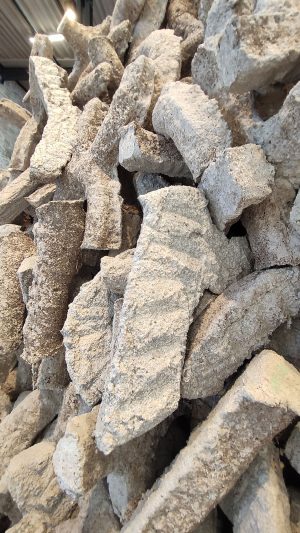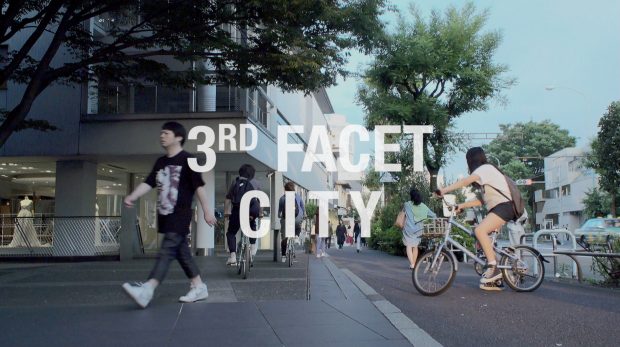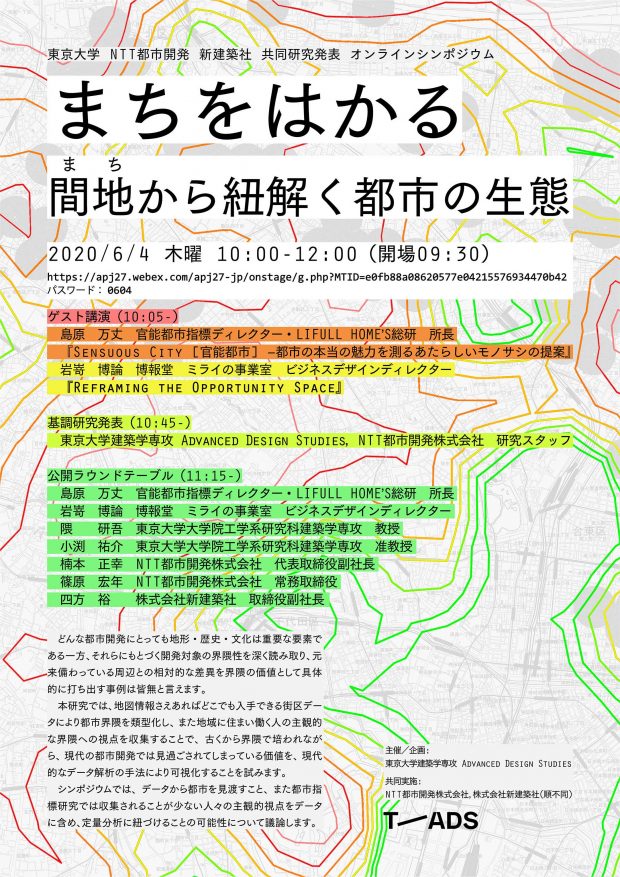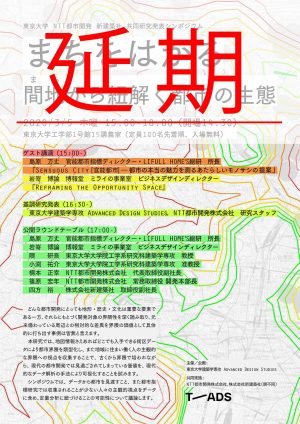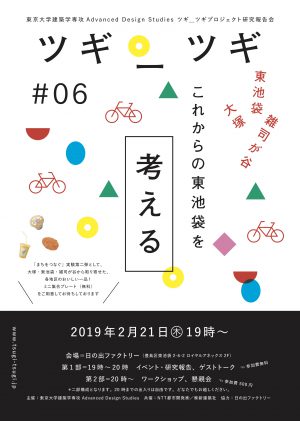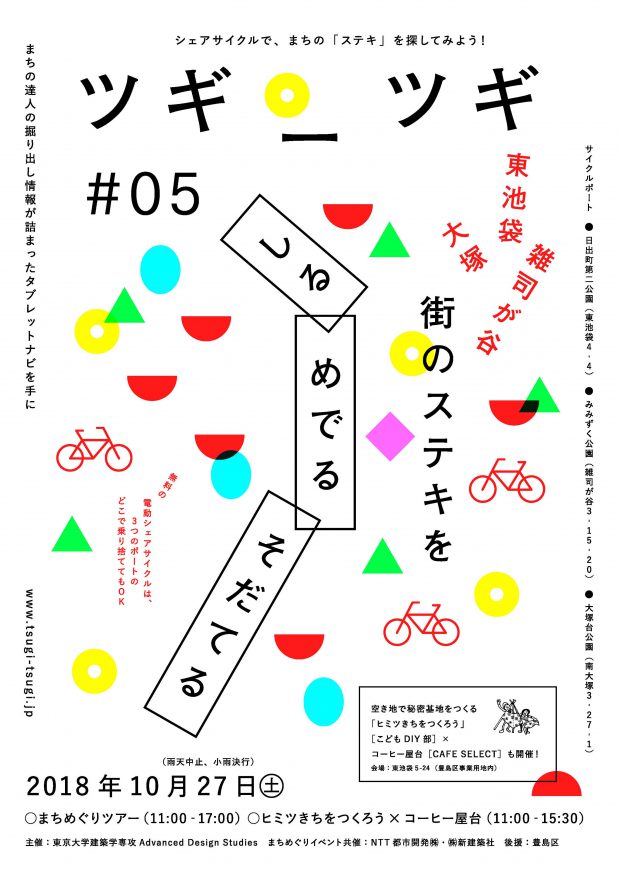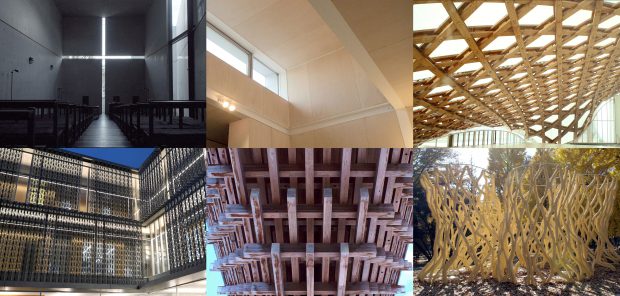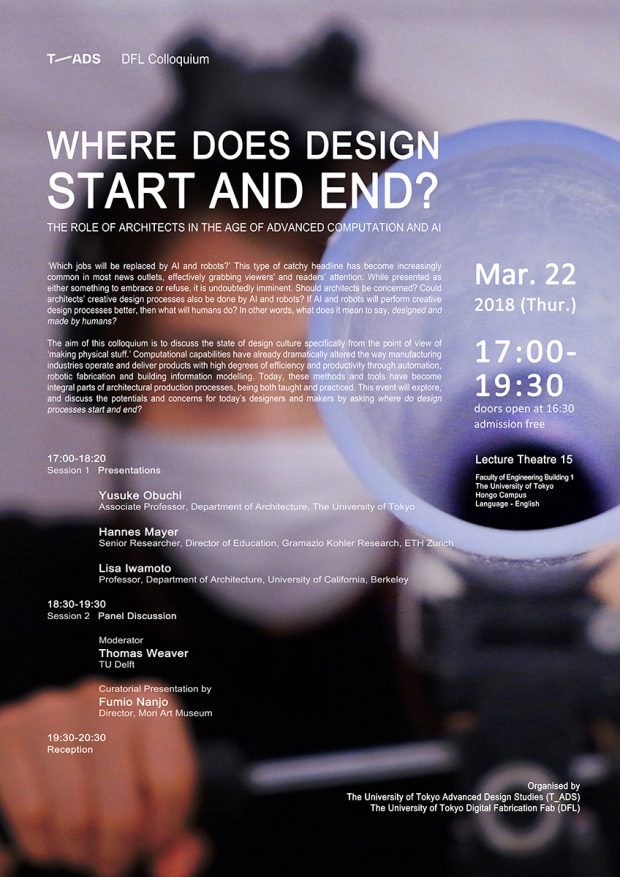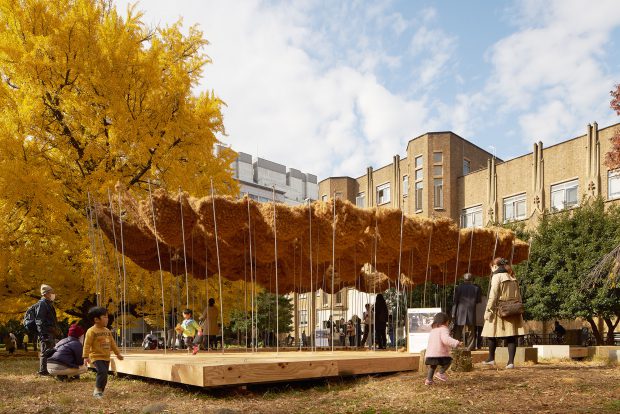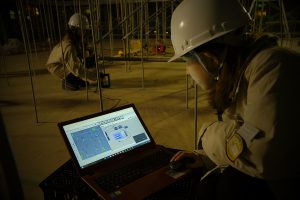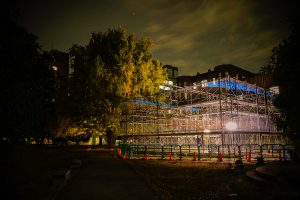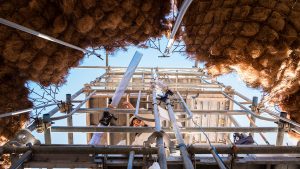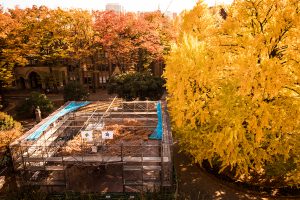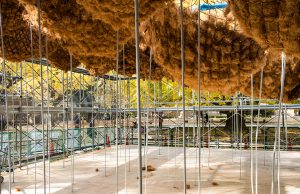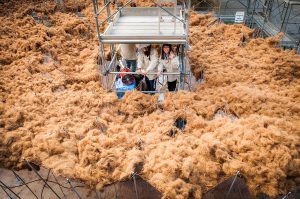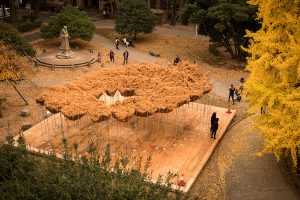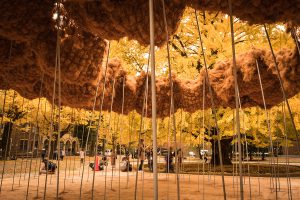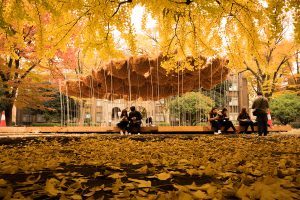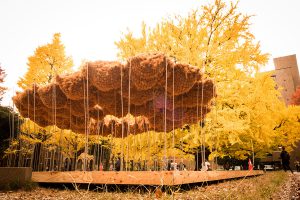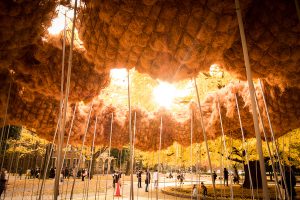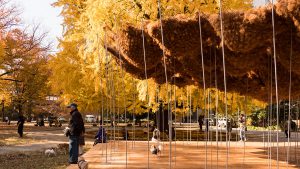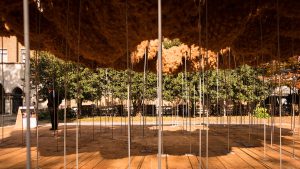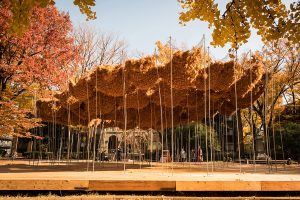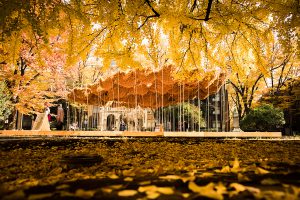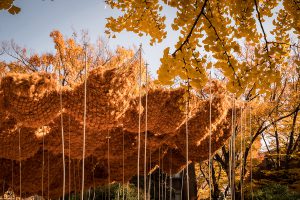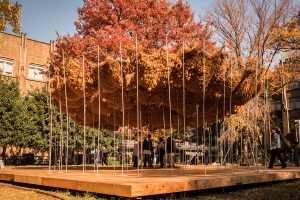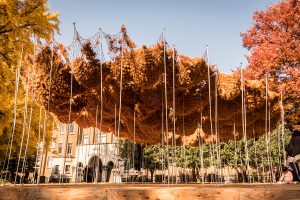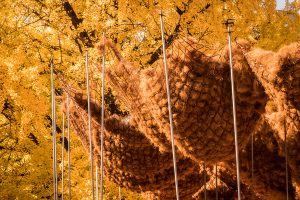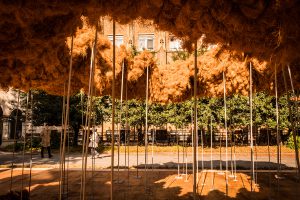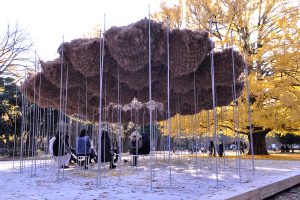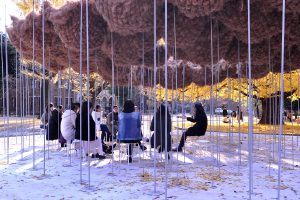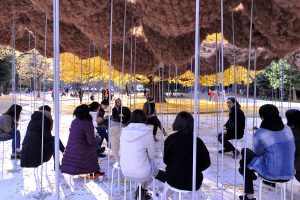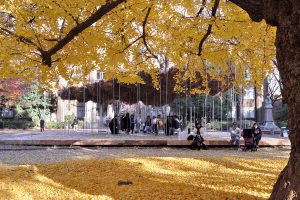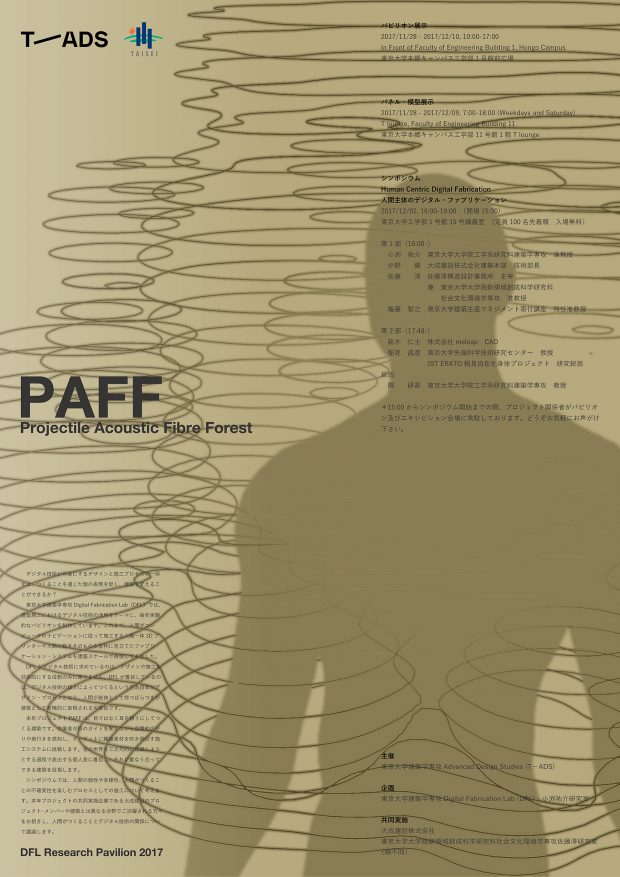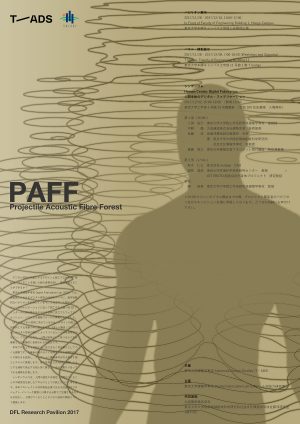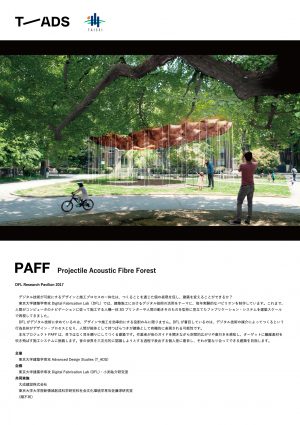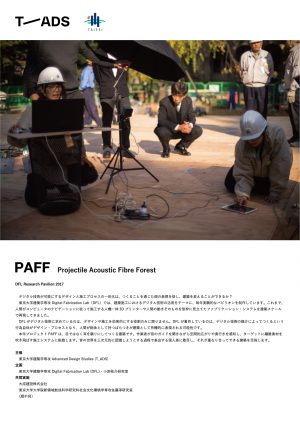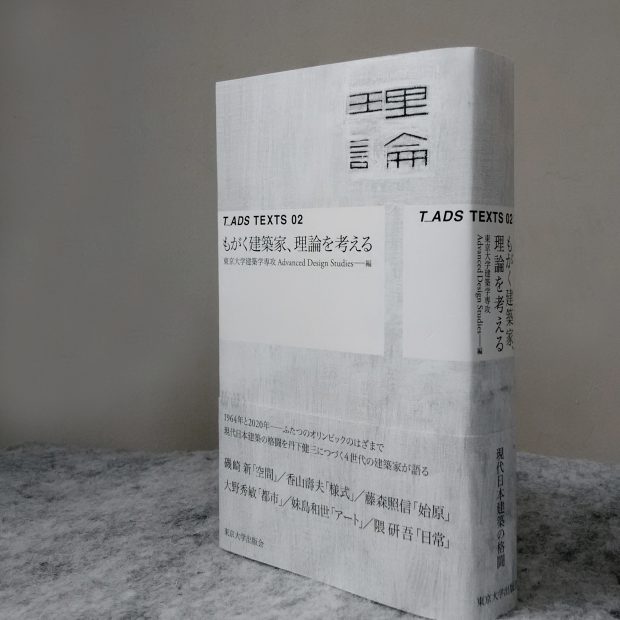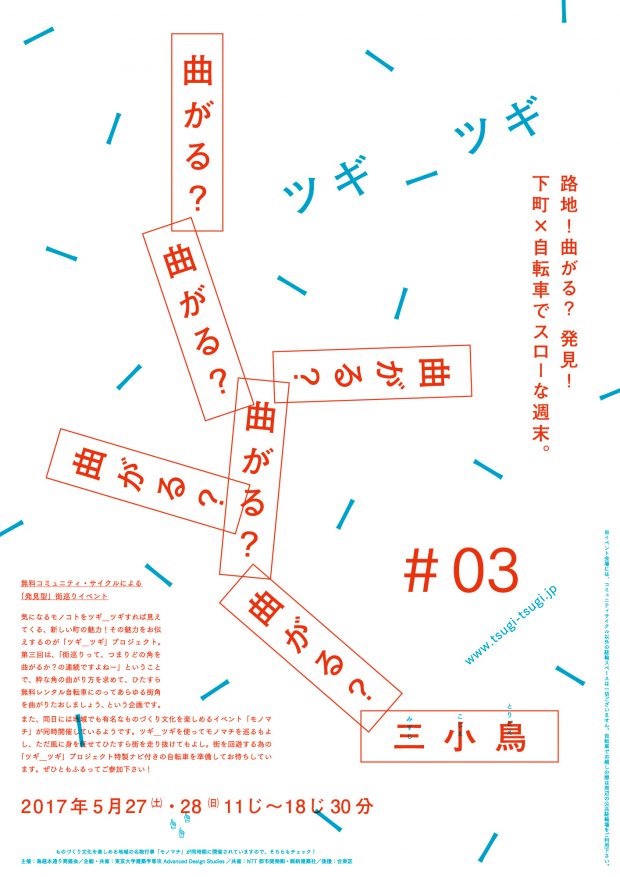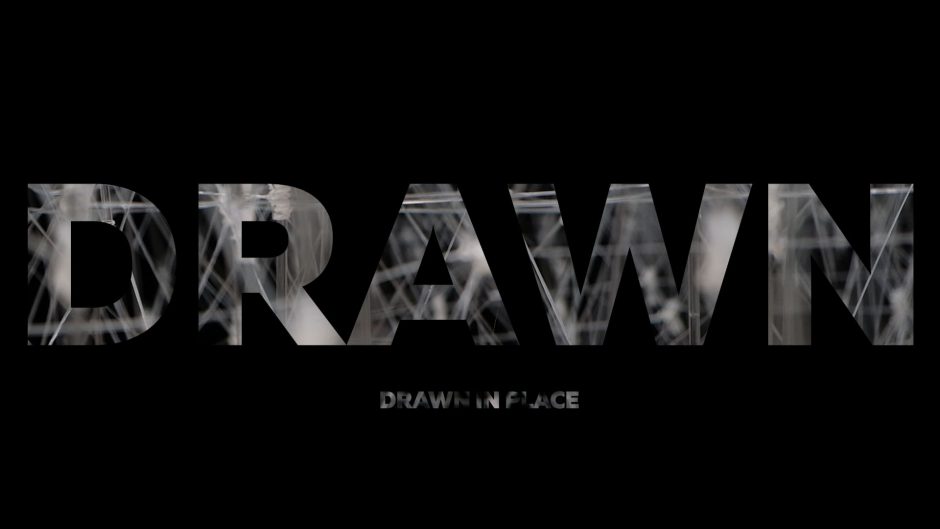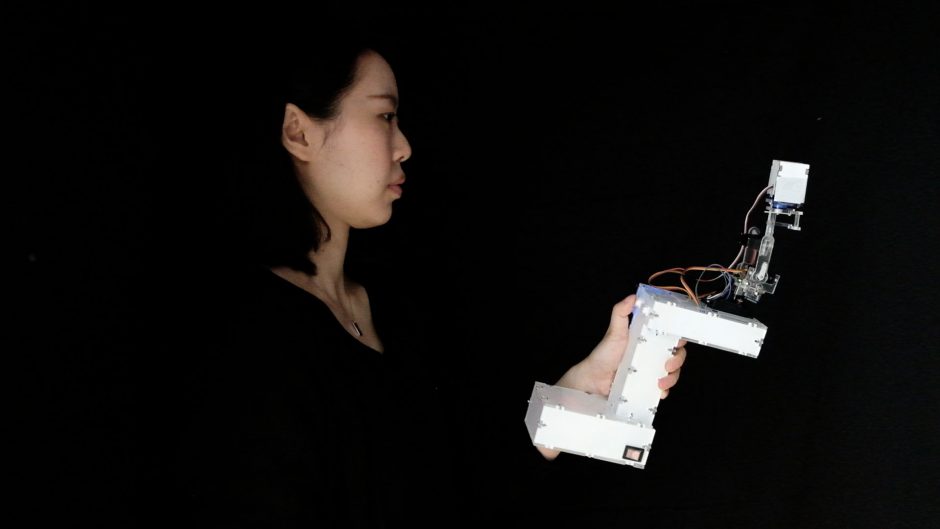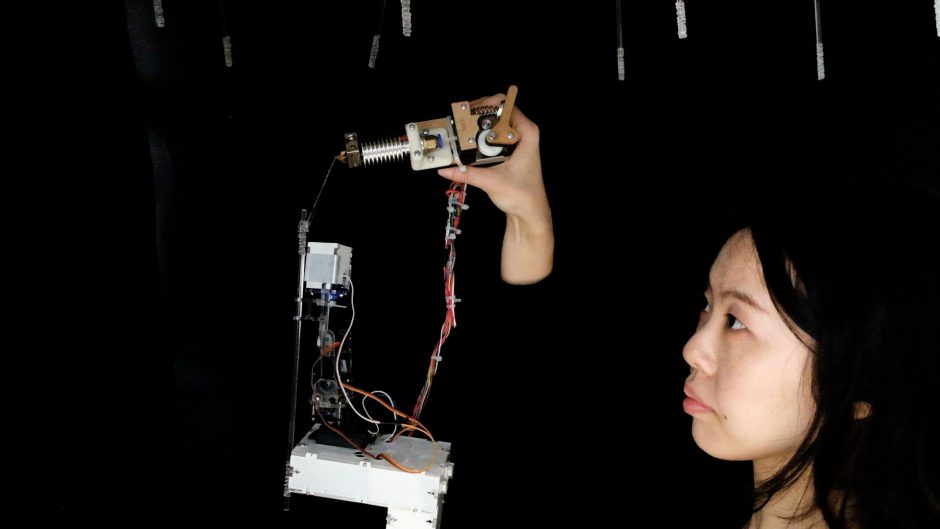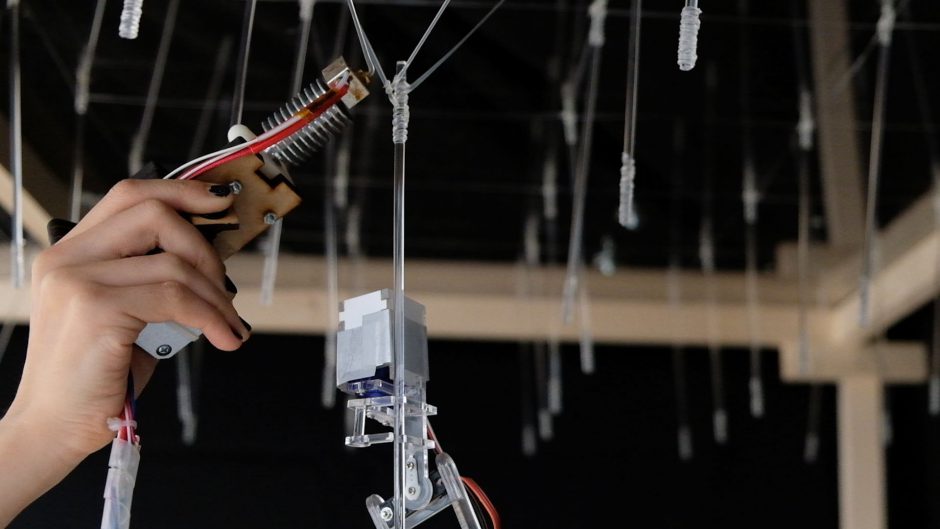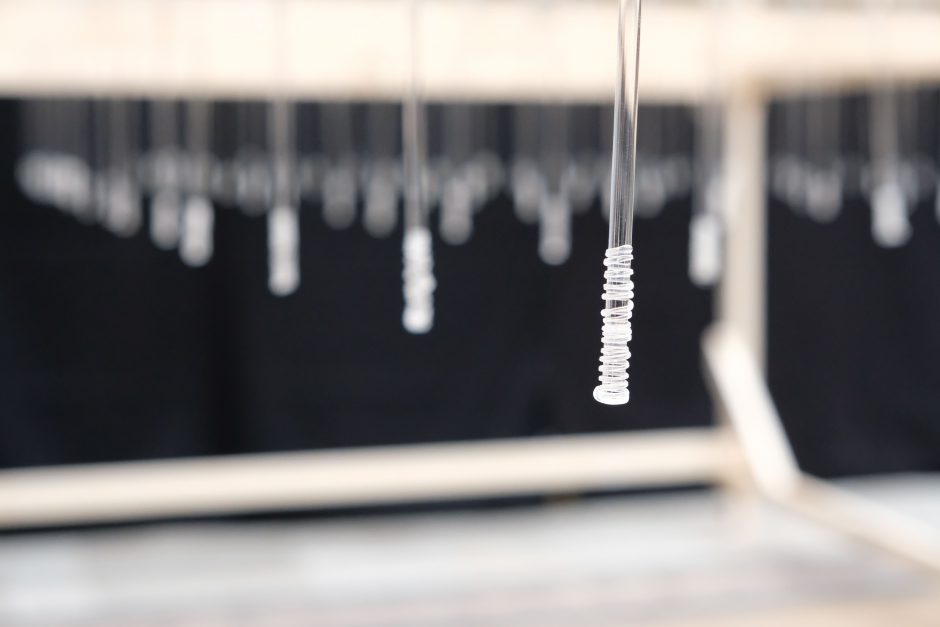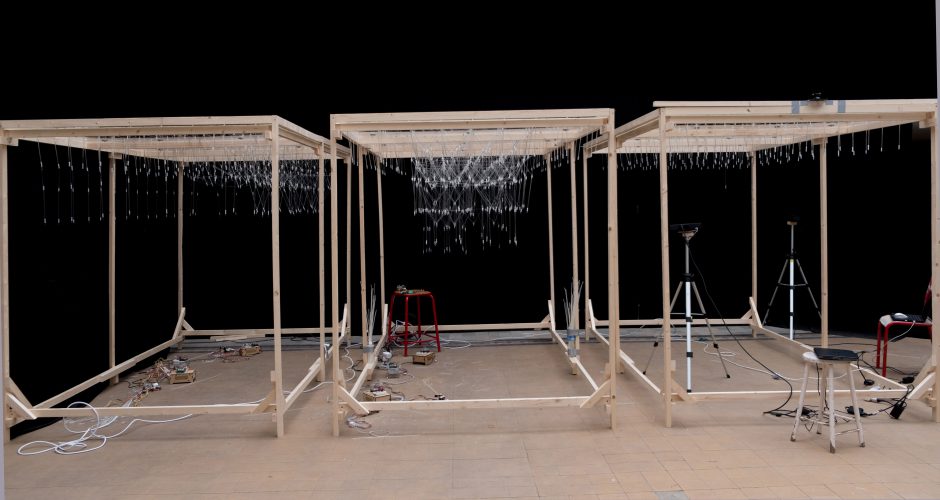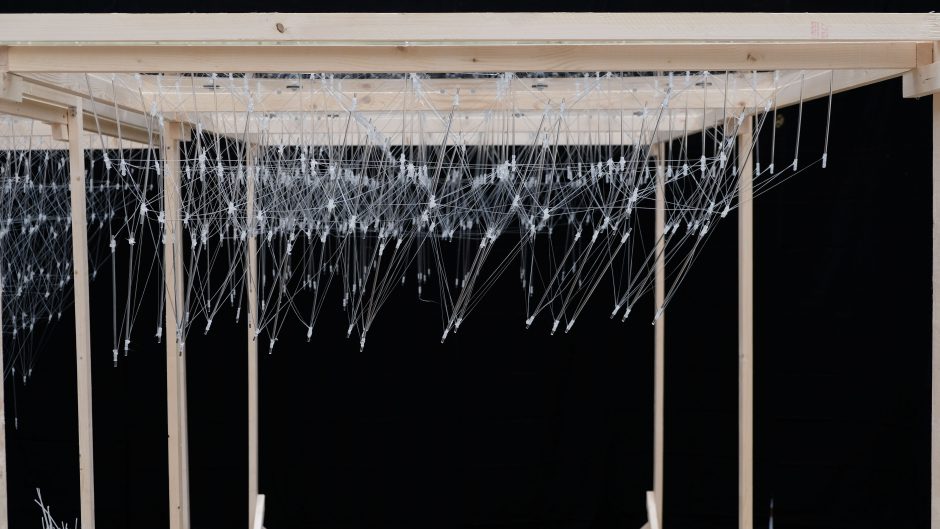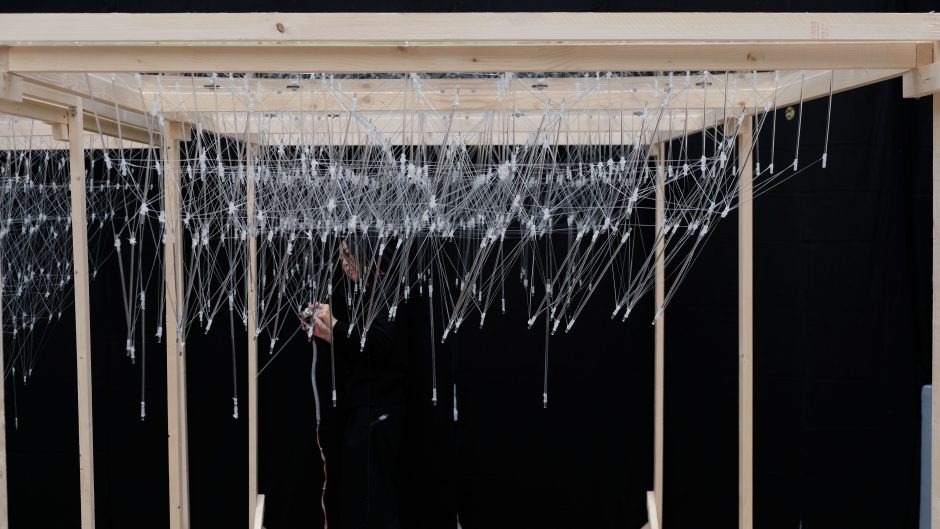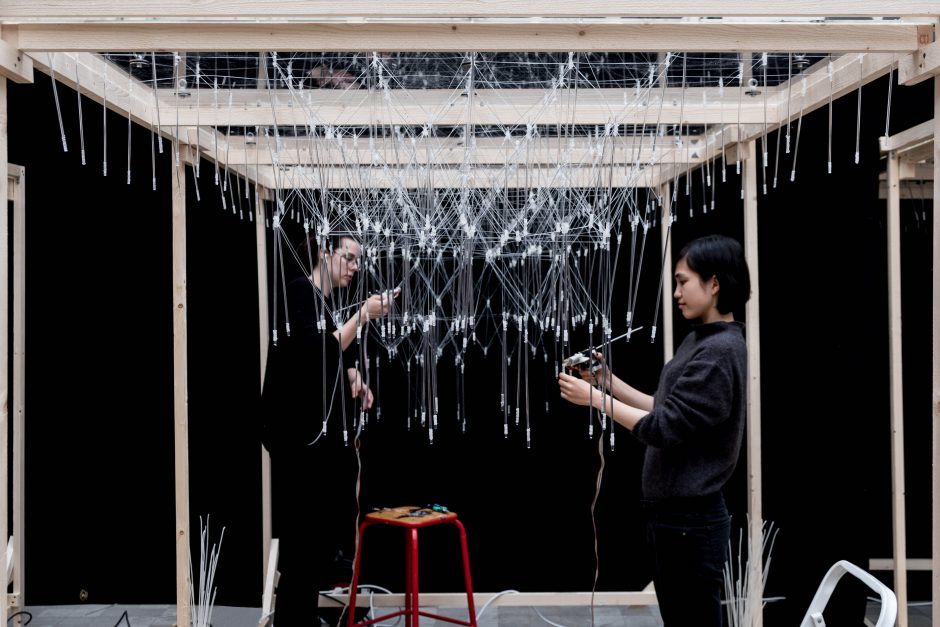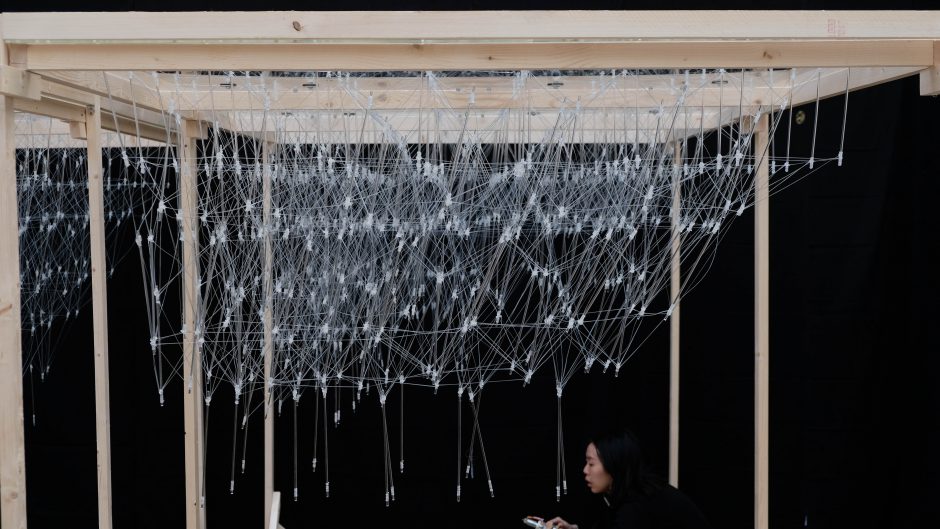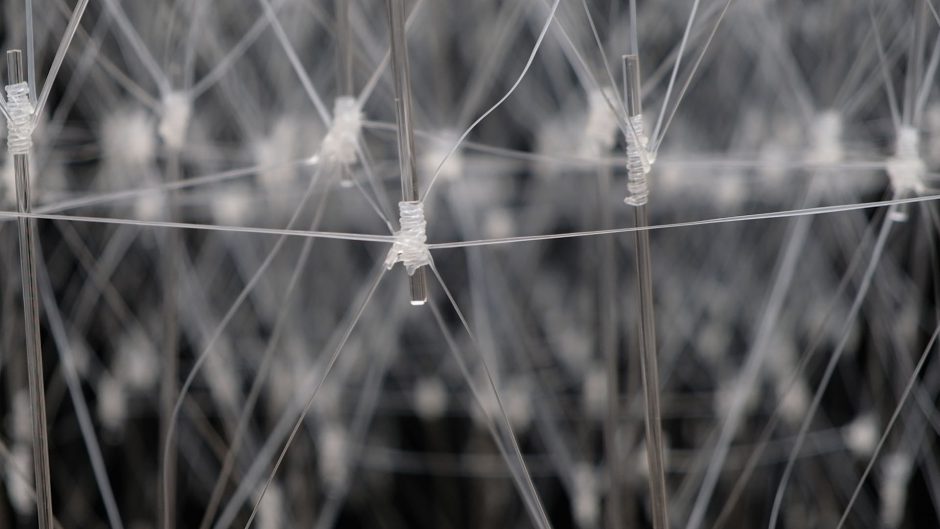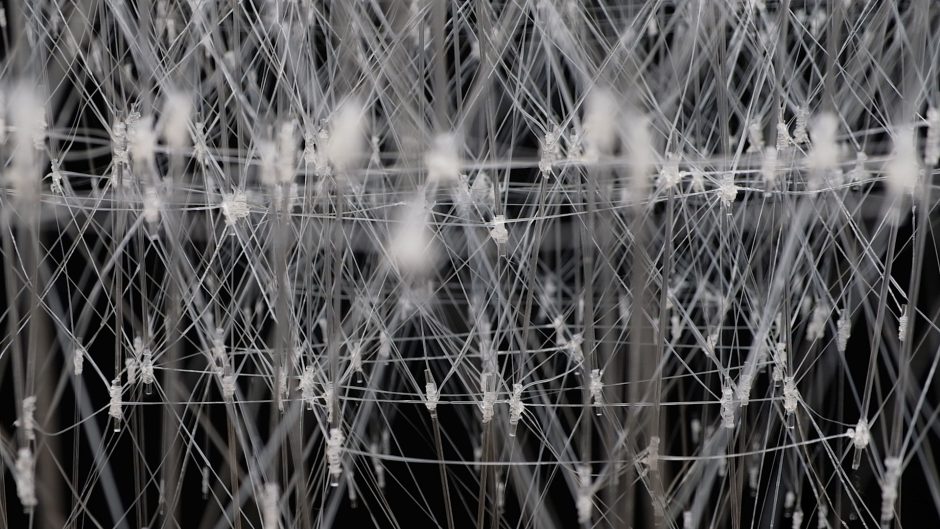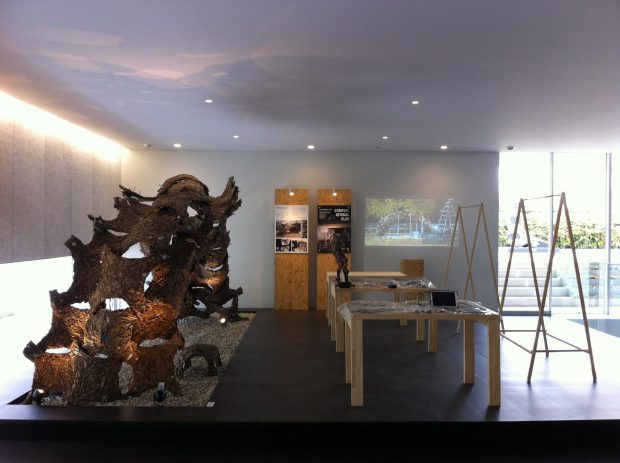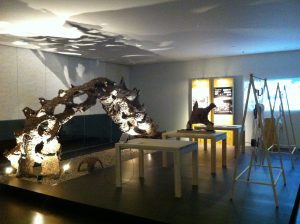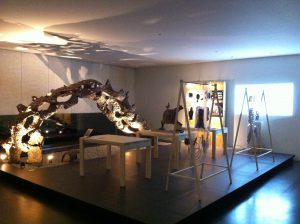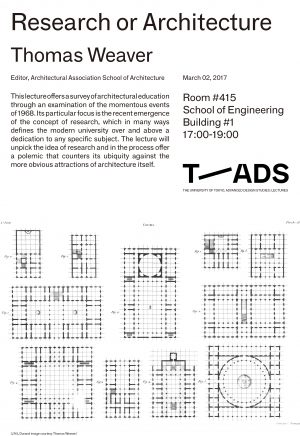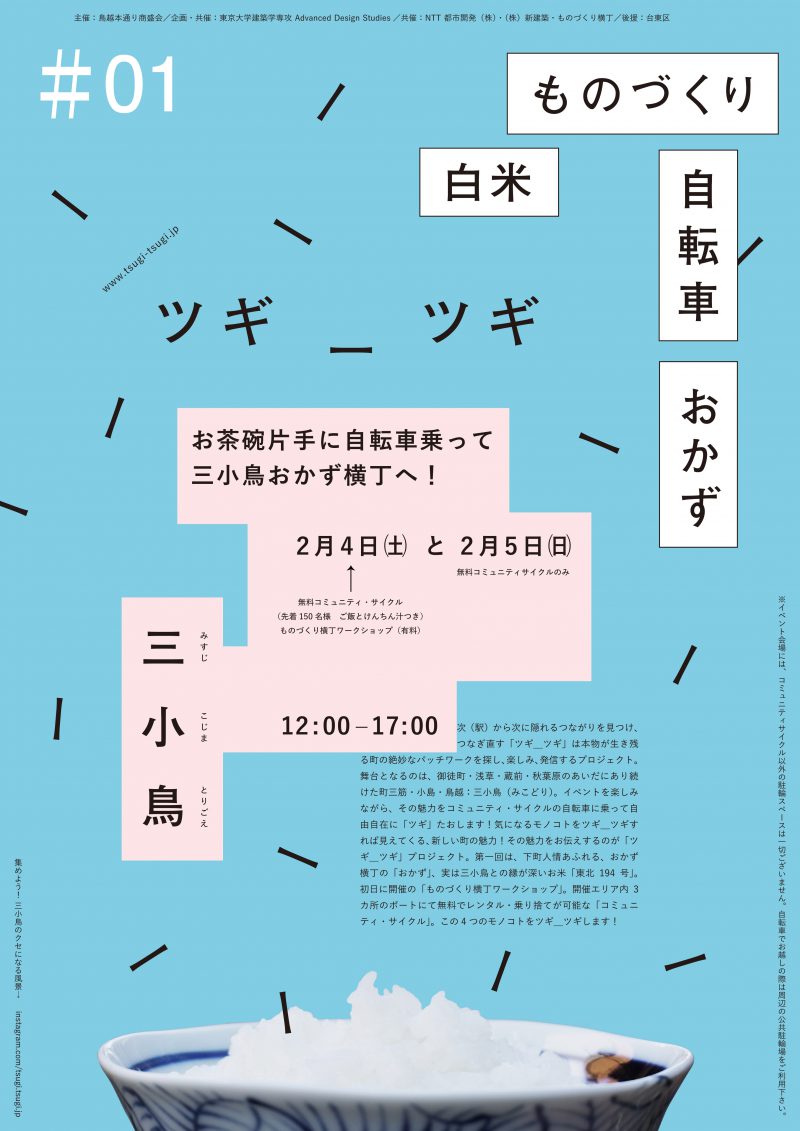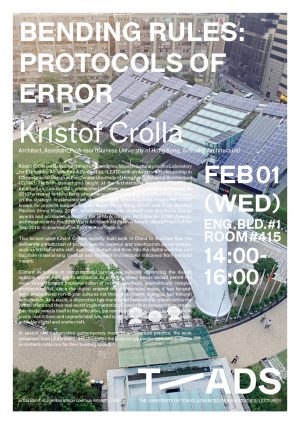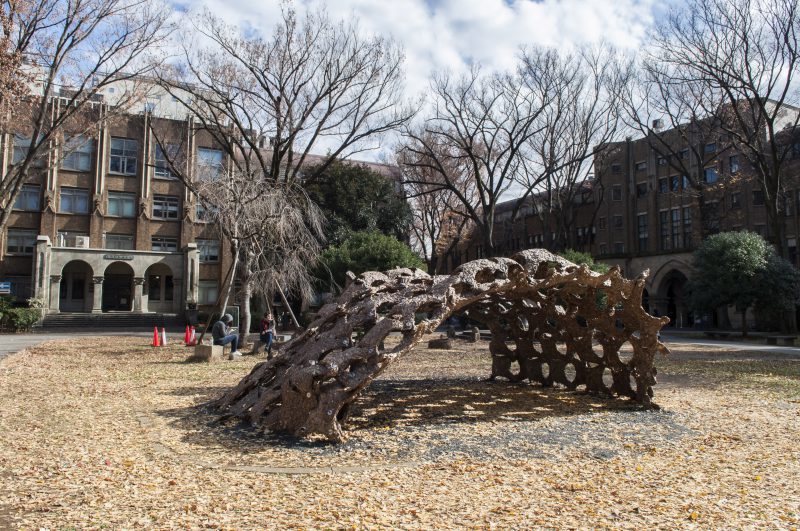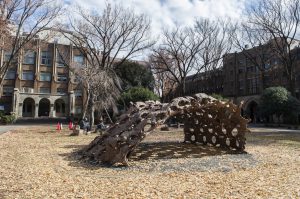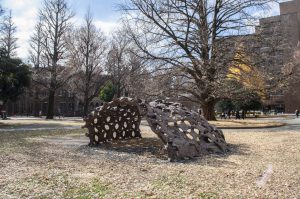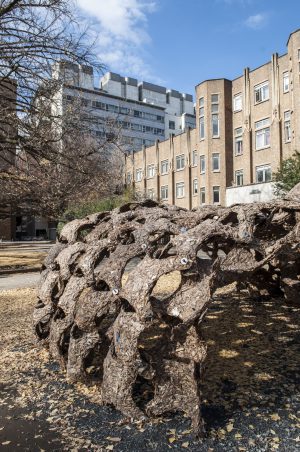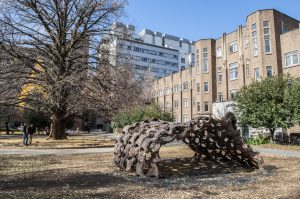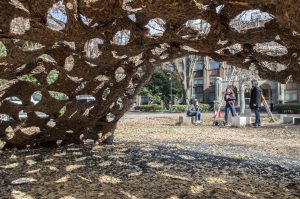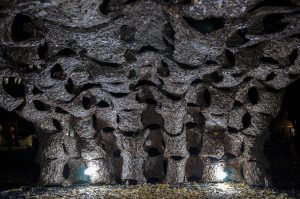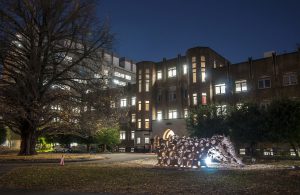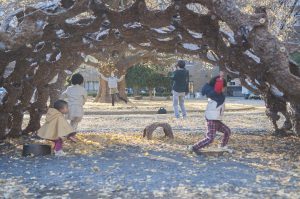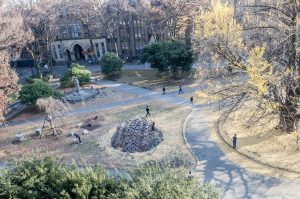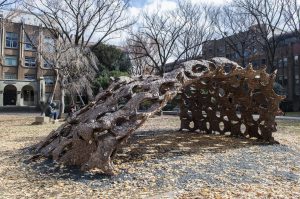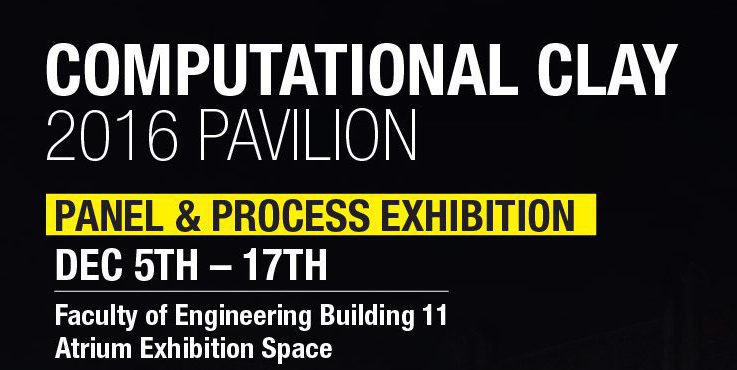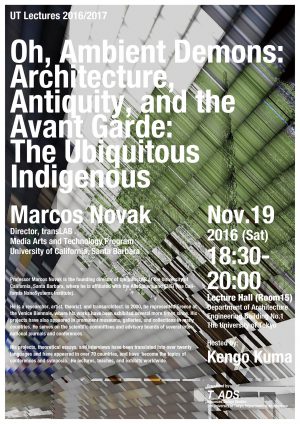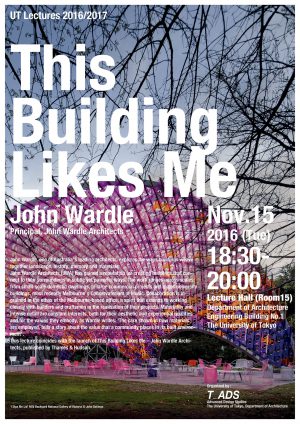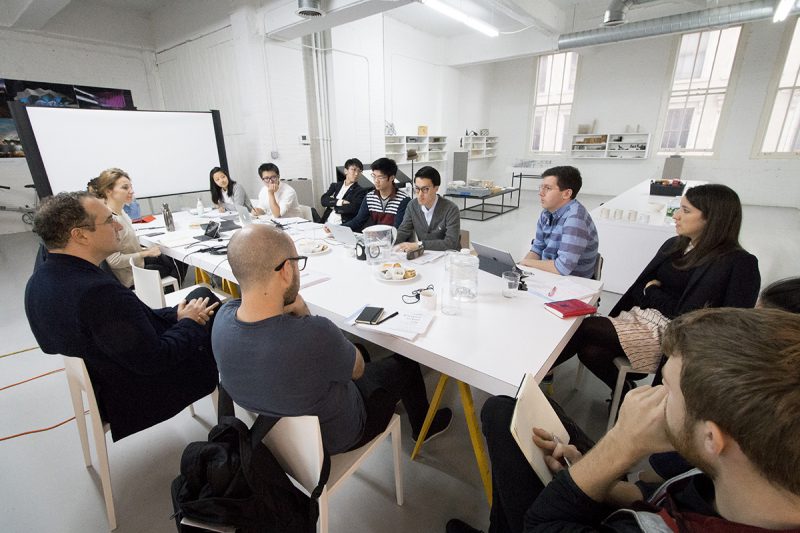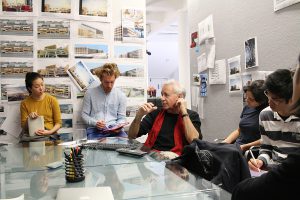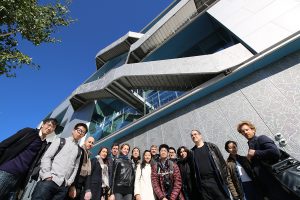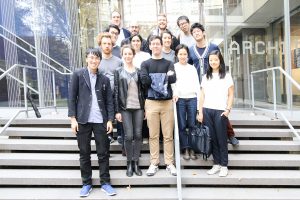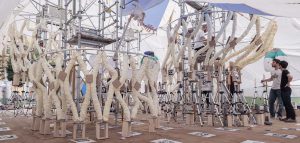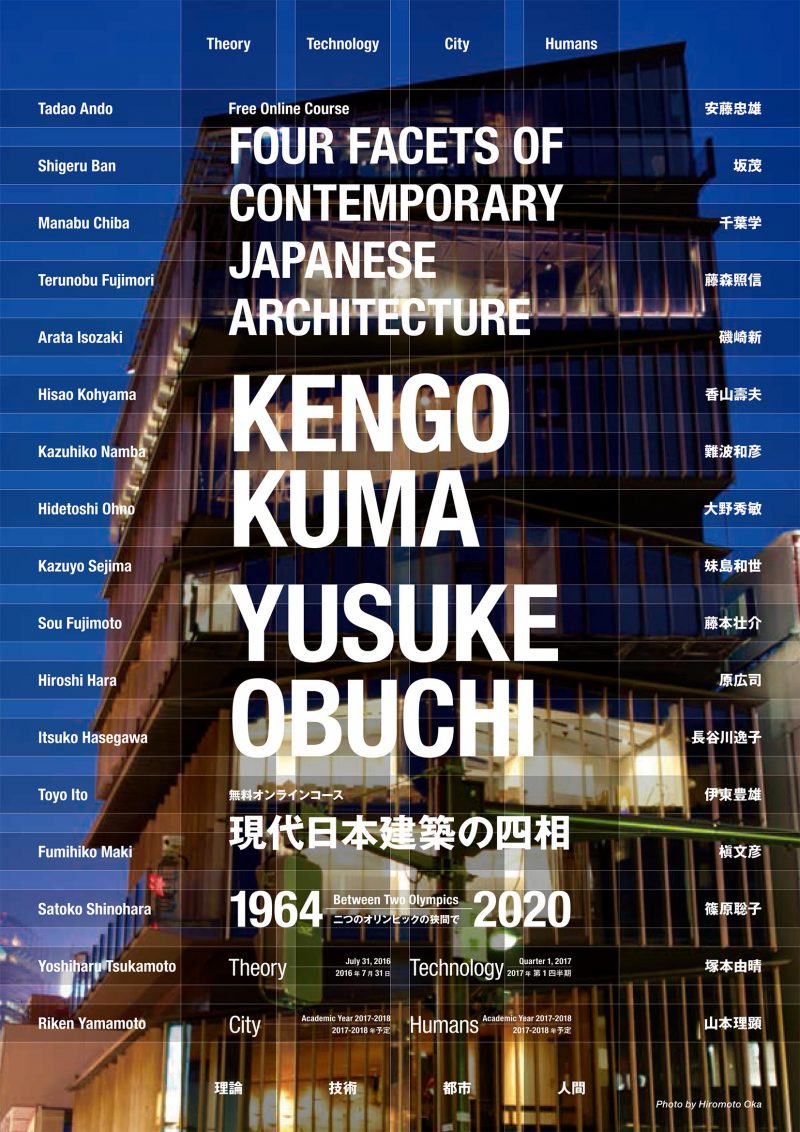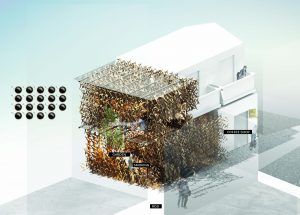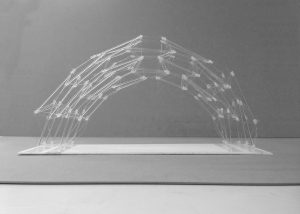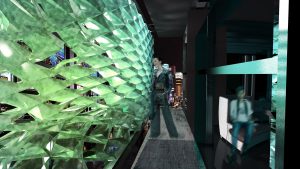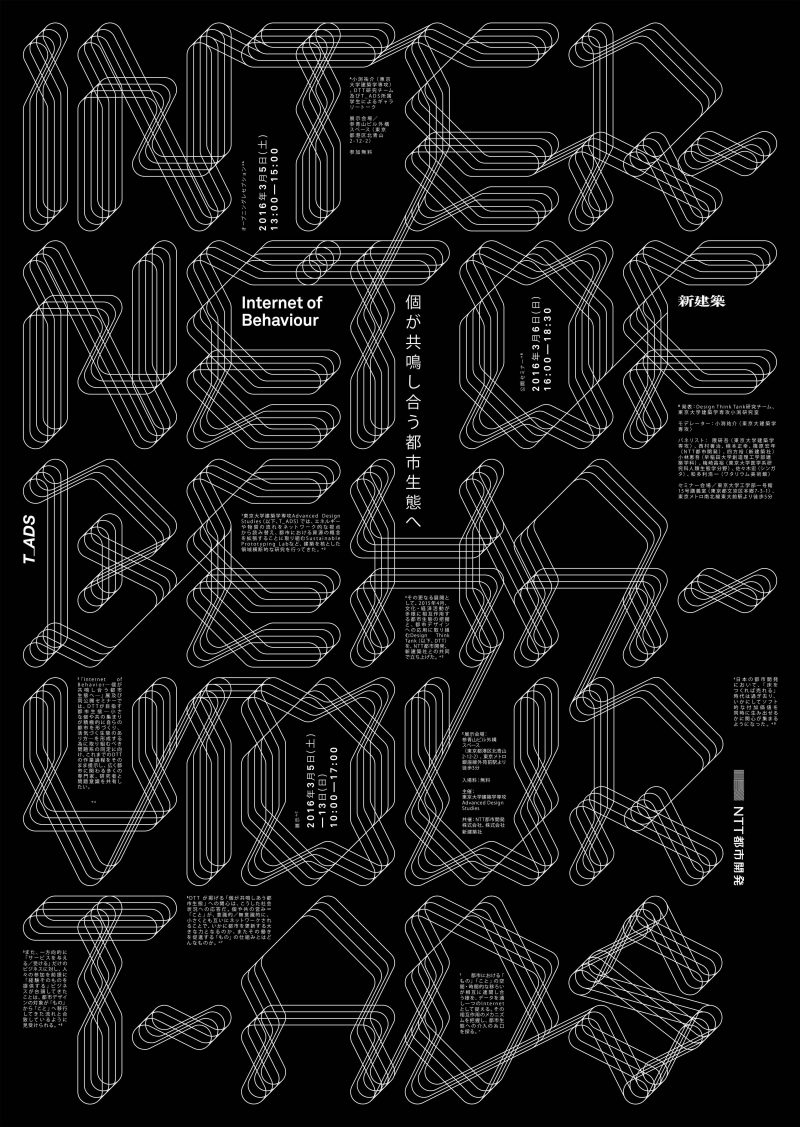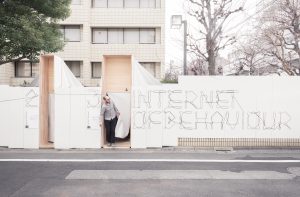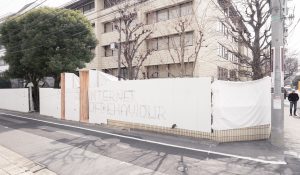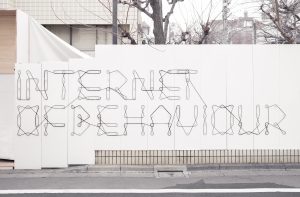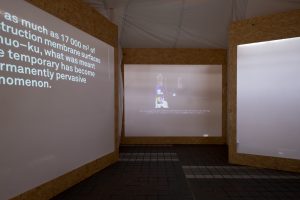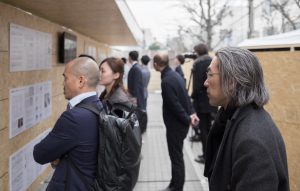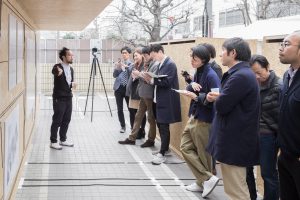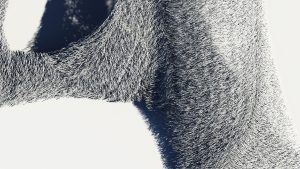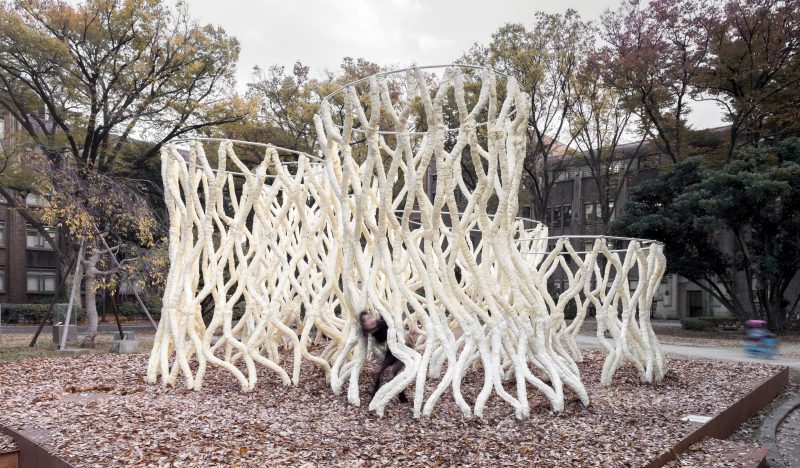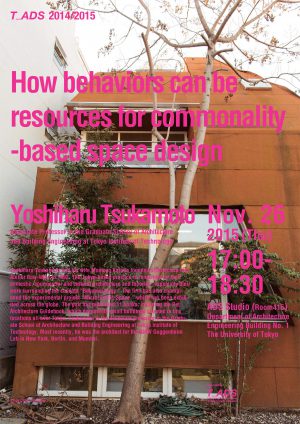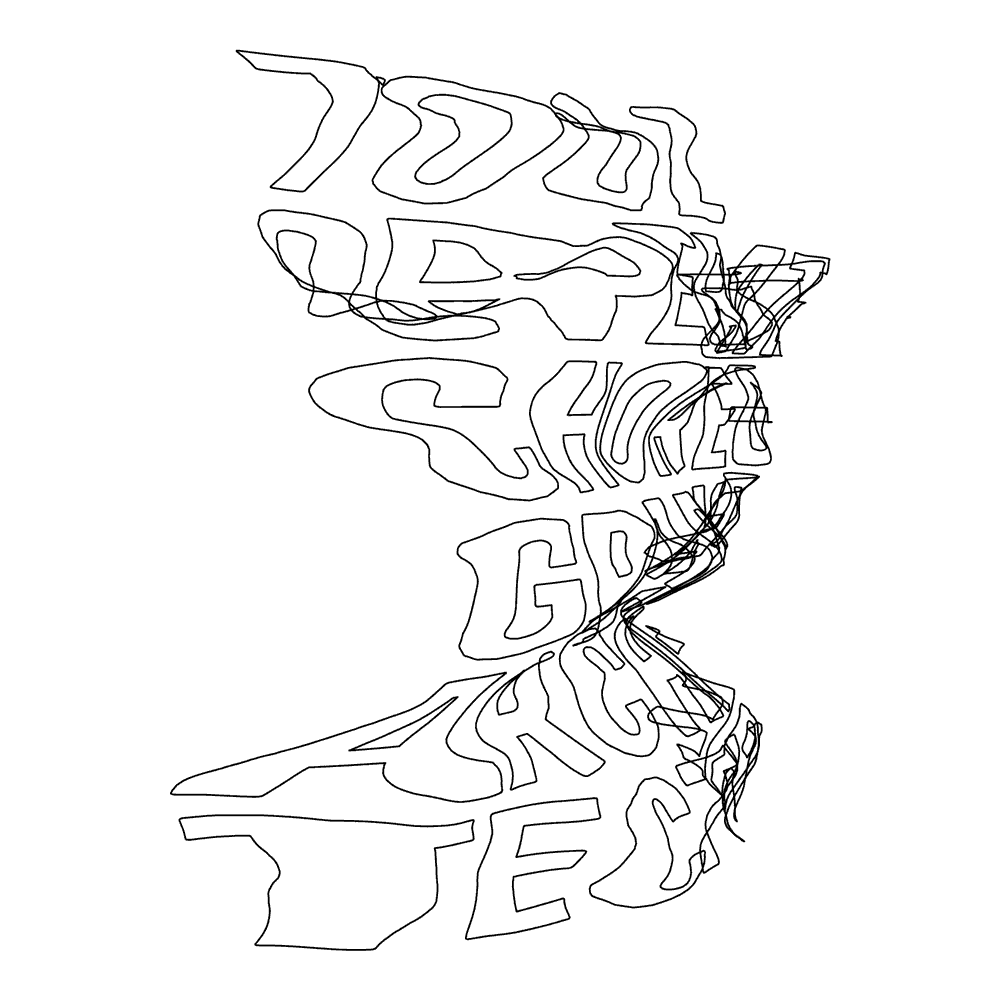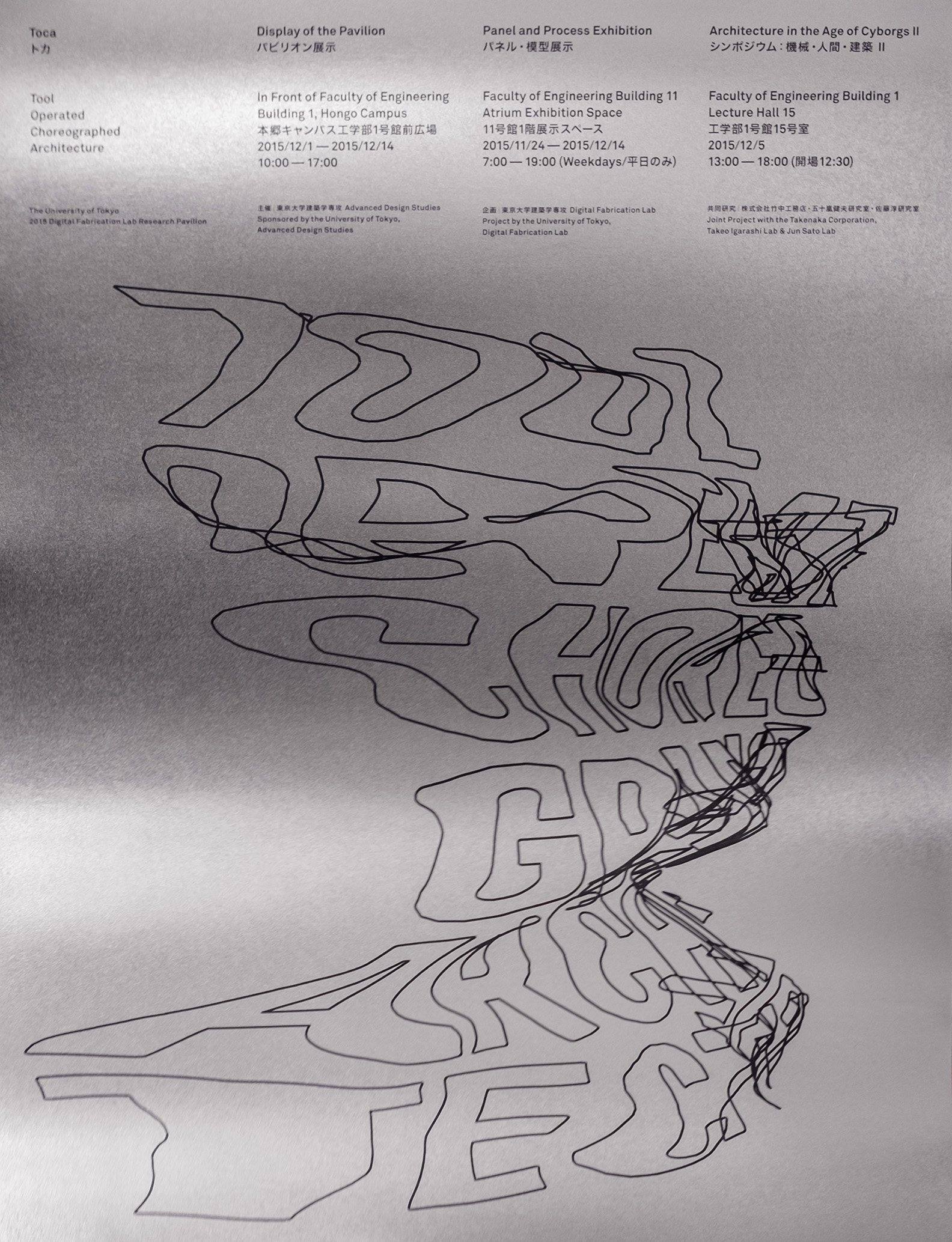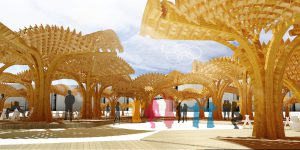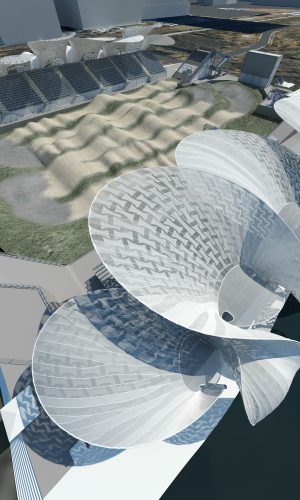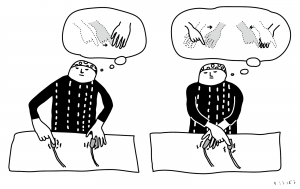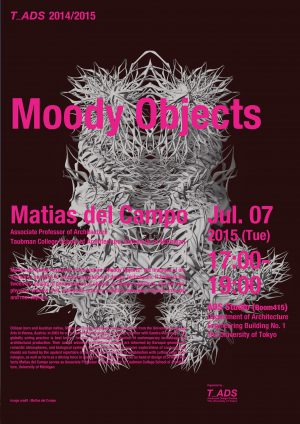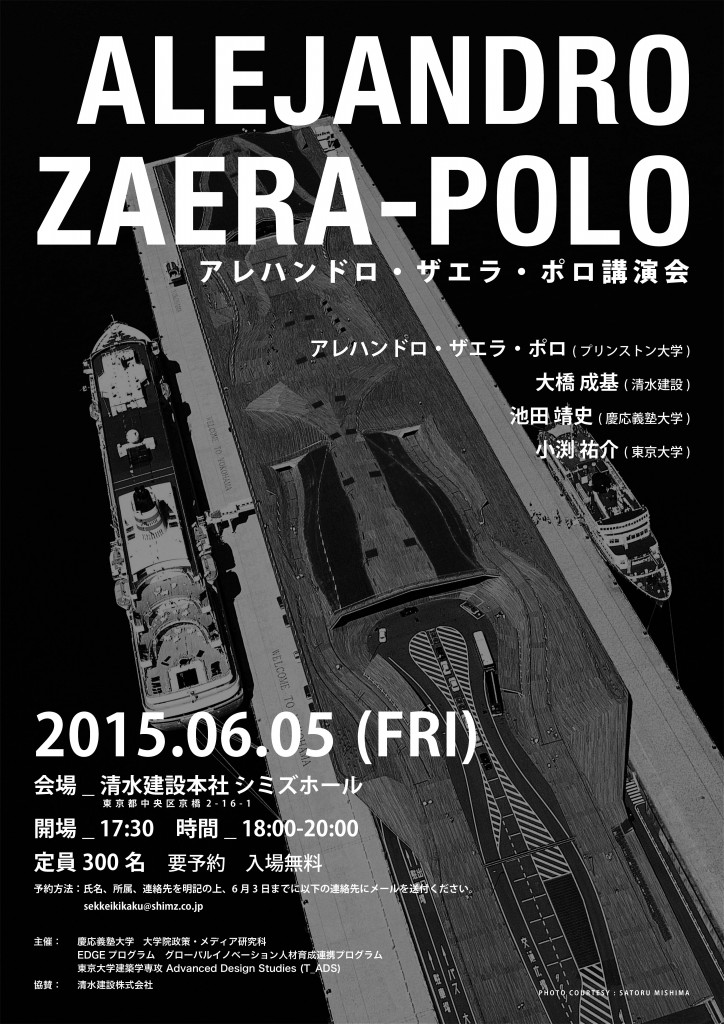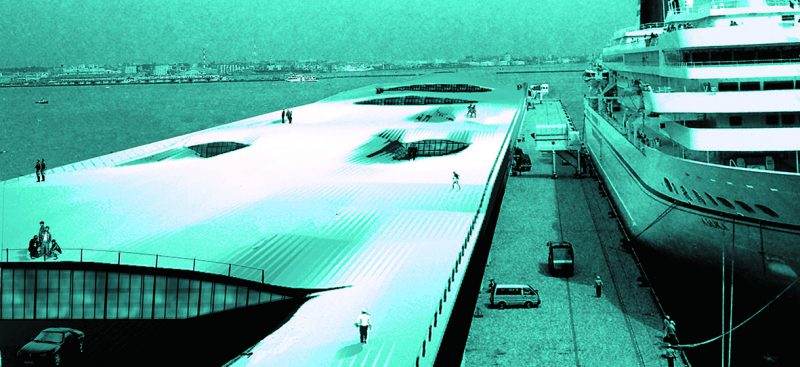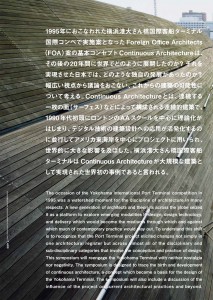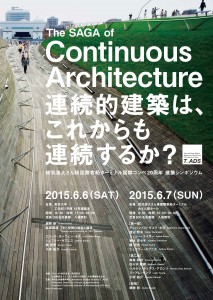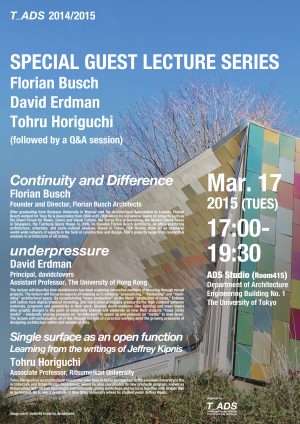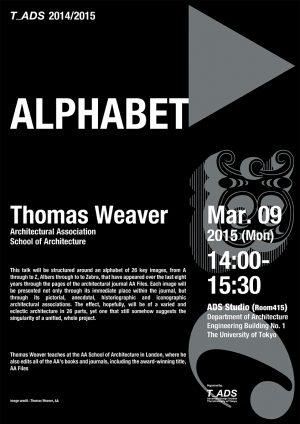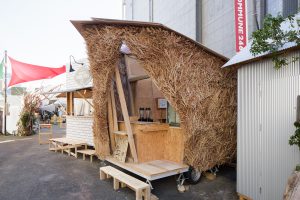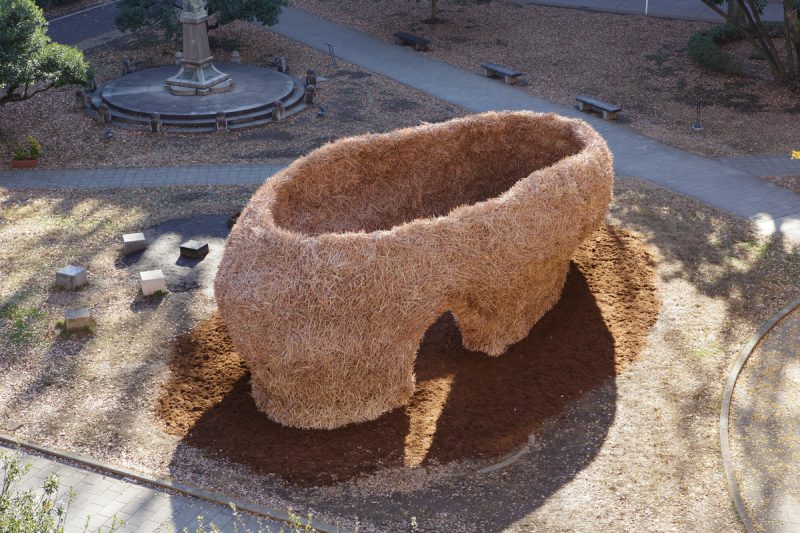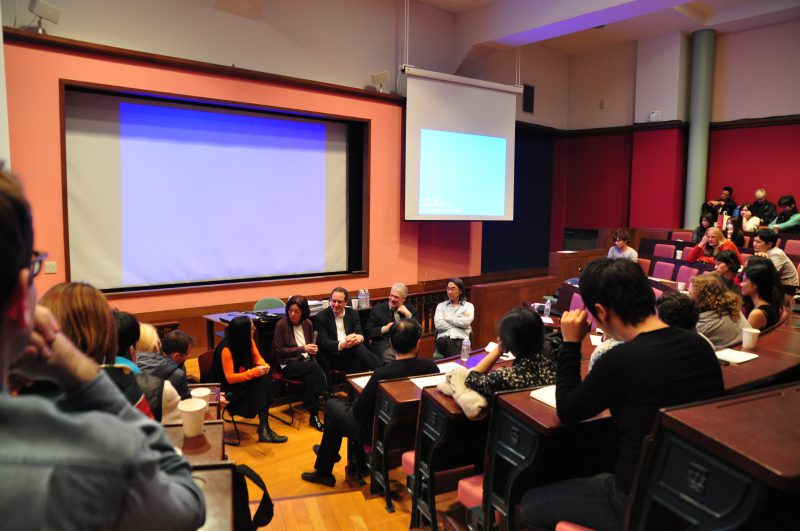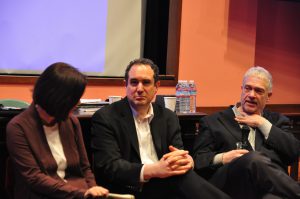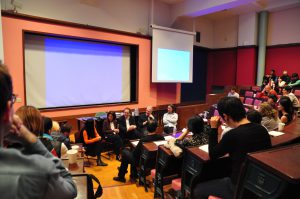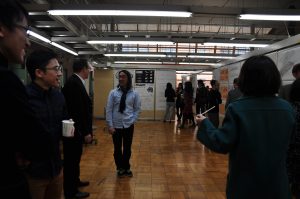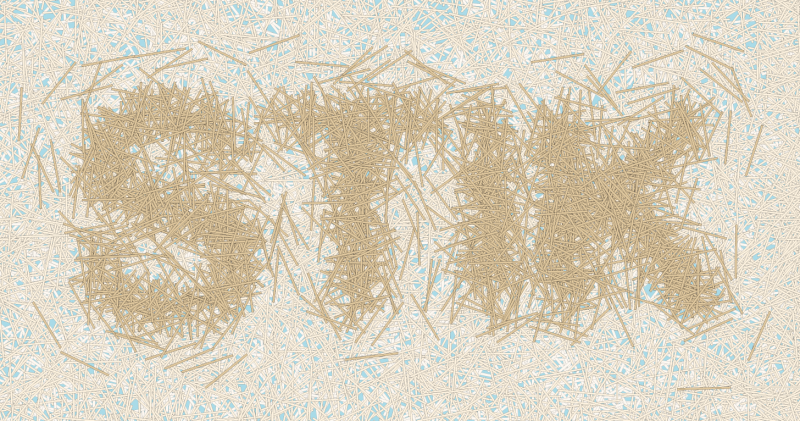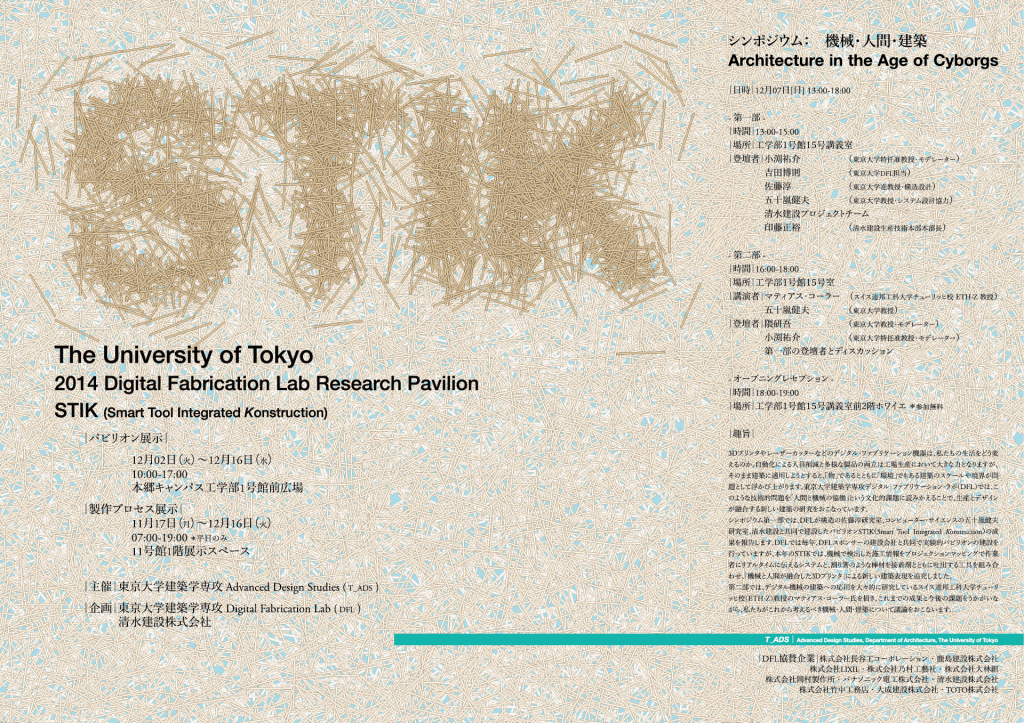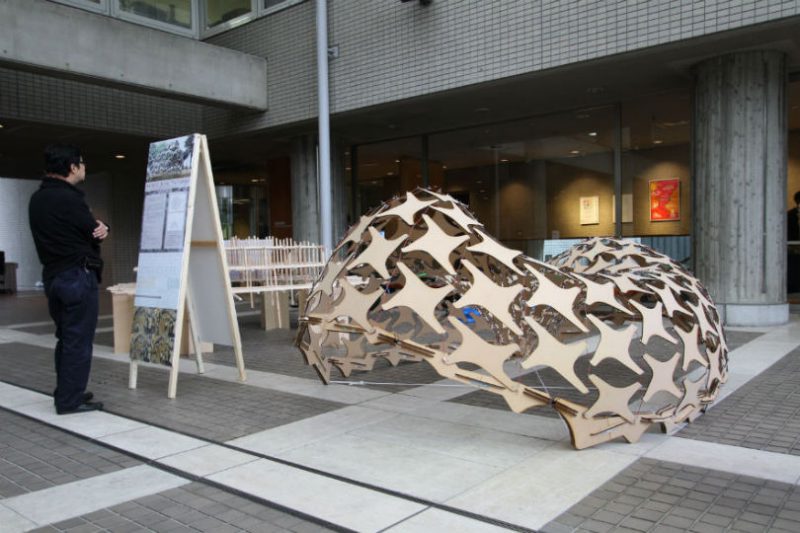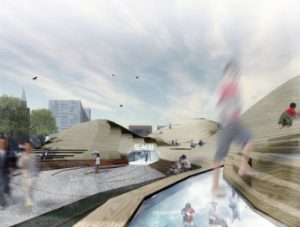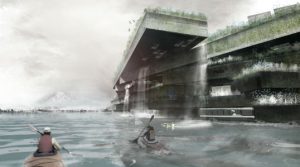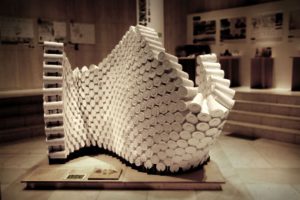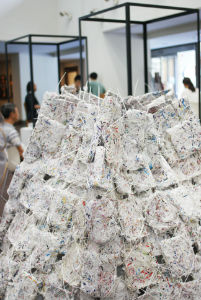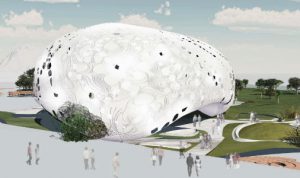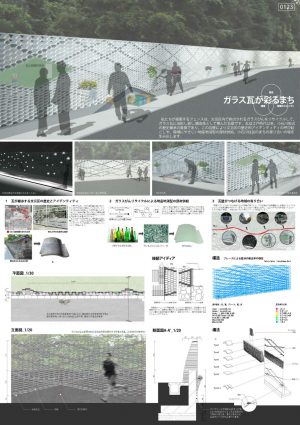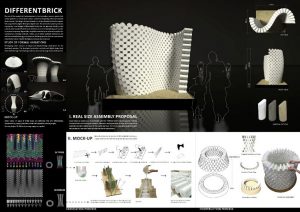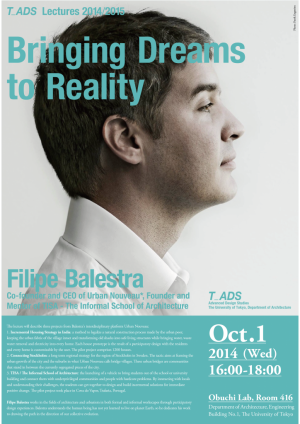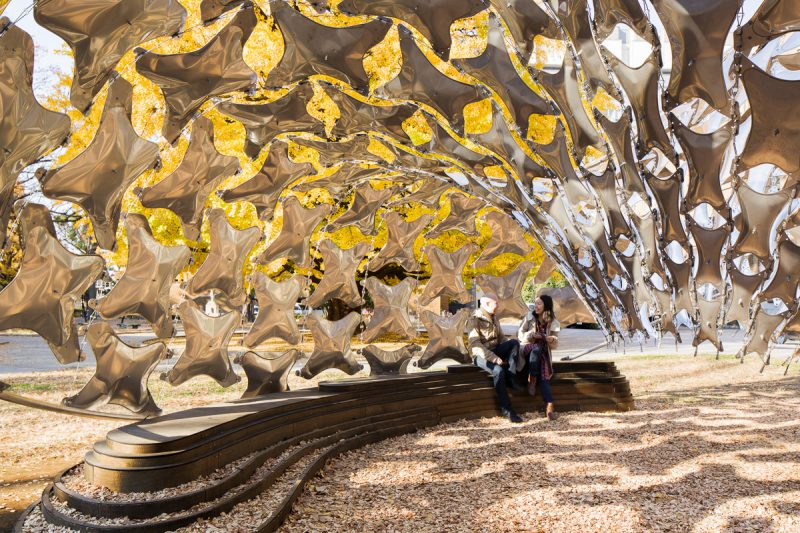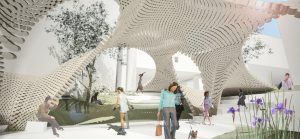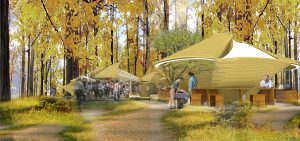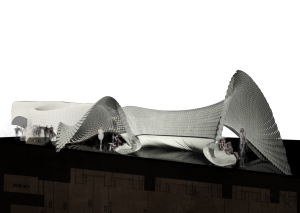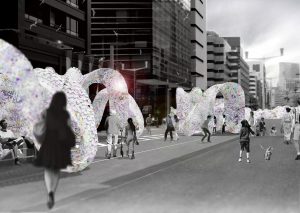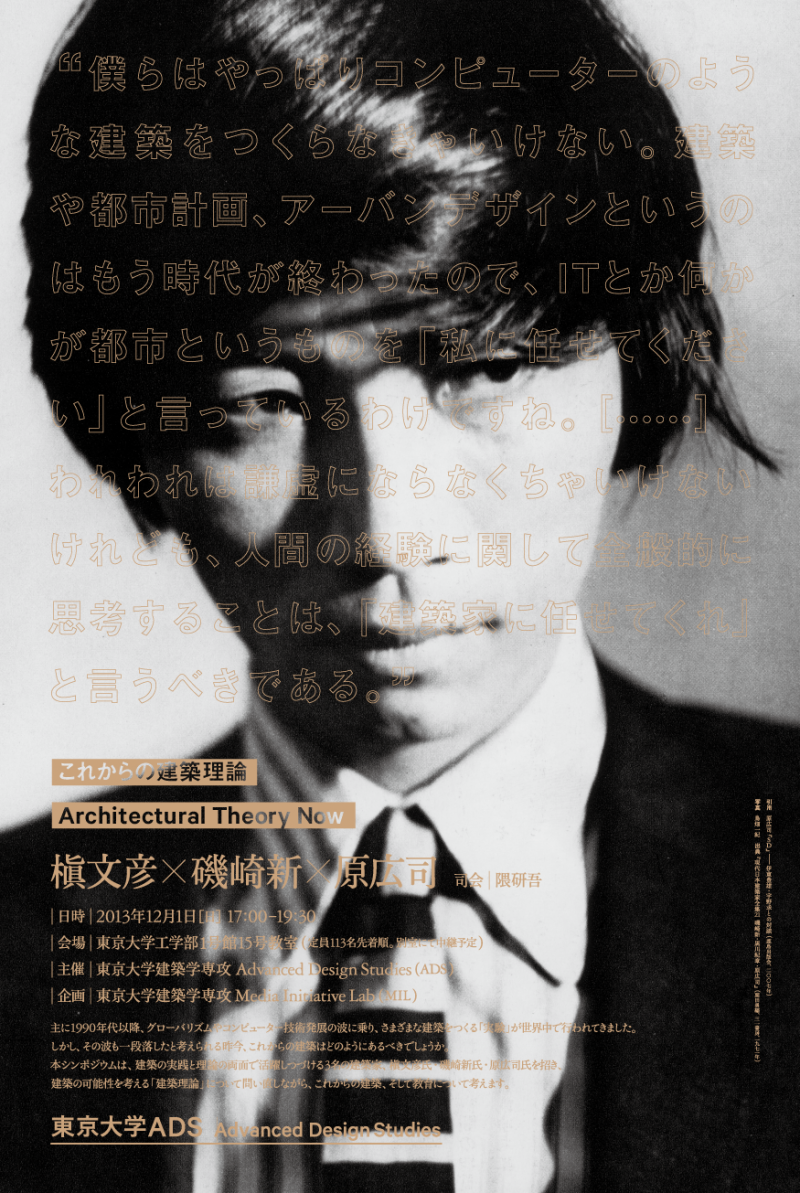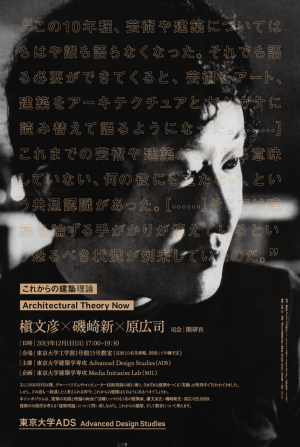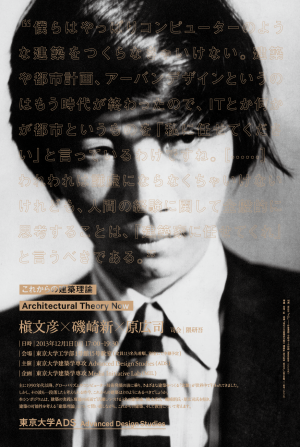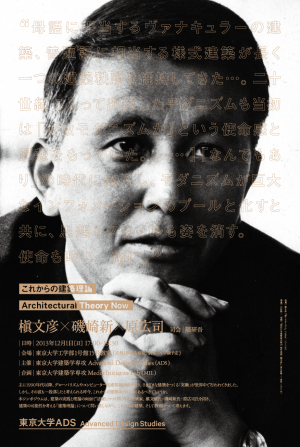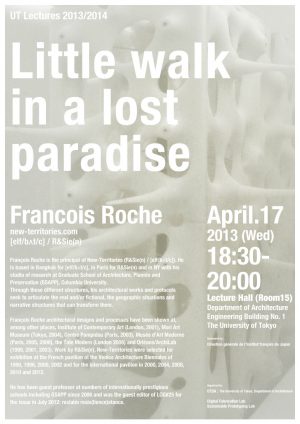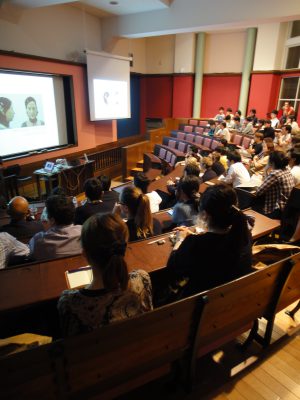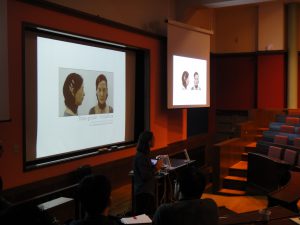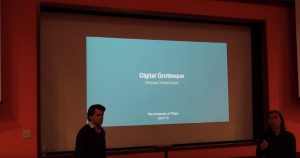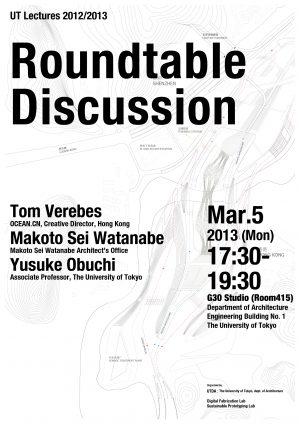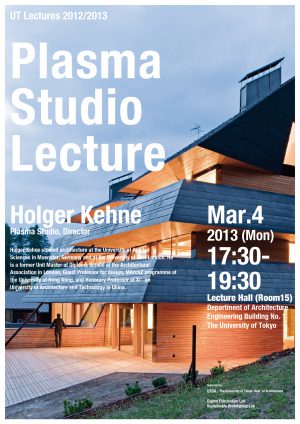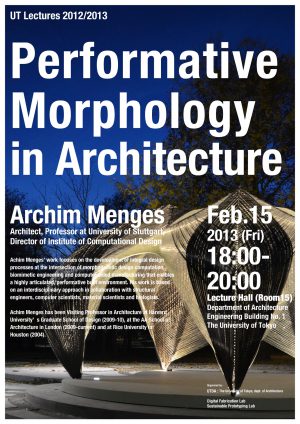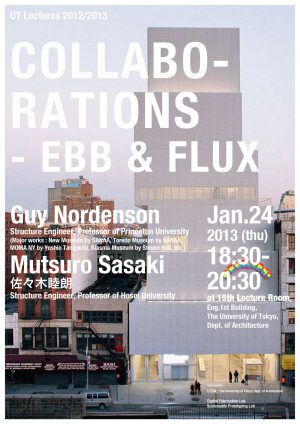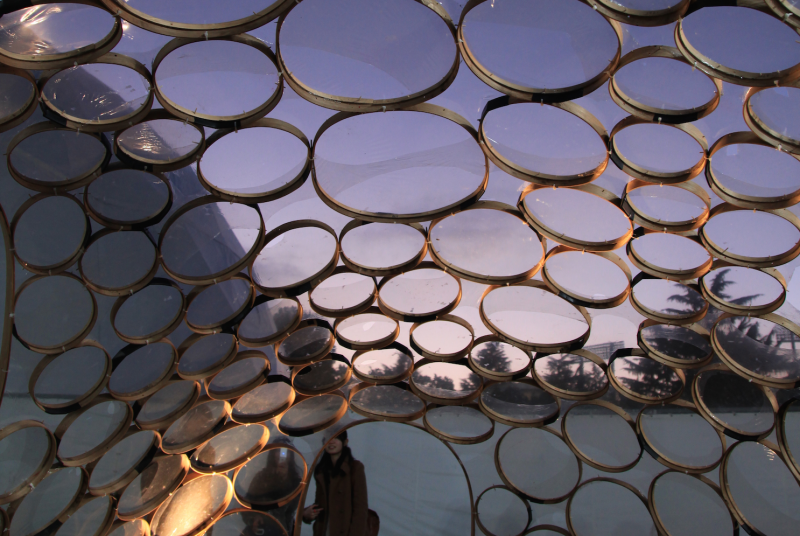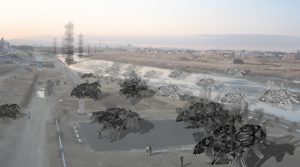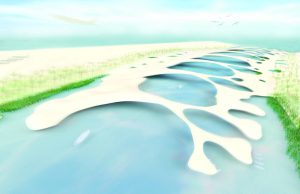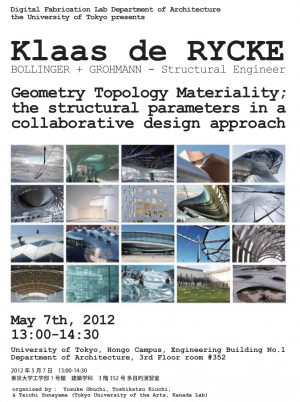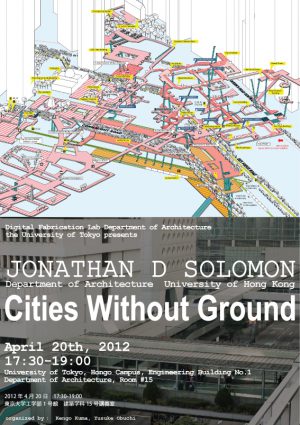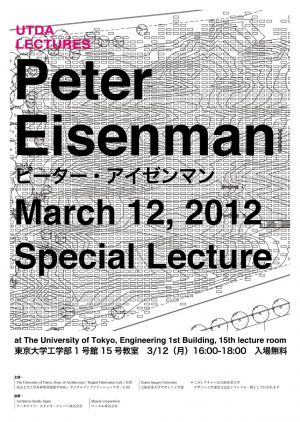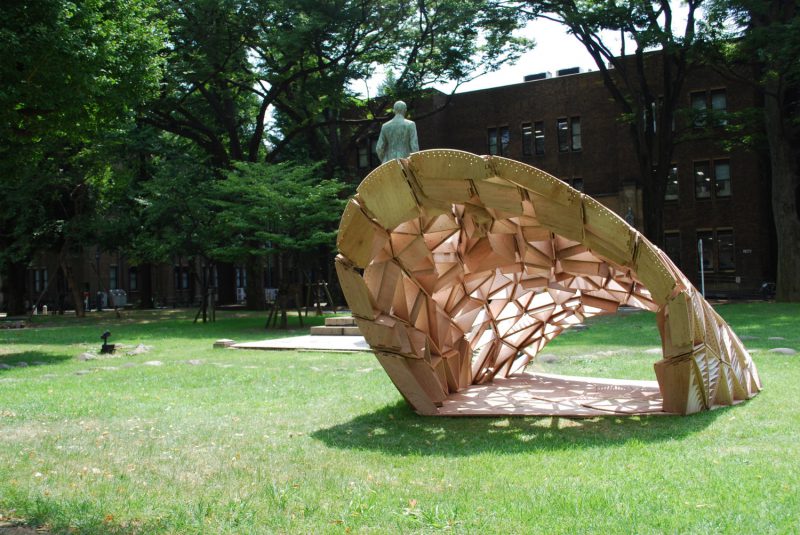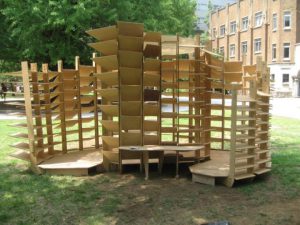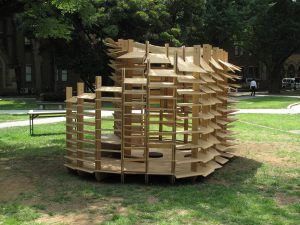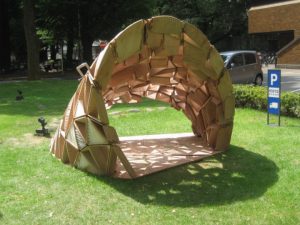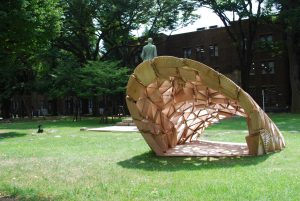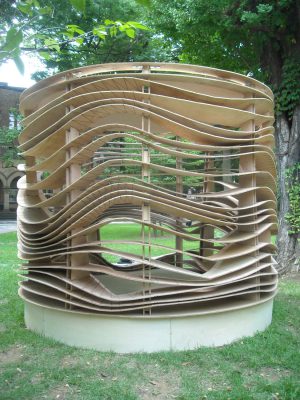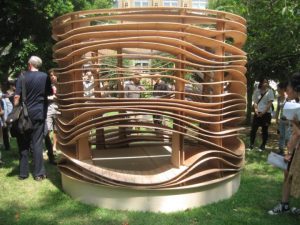Four Facets of Contemporary Japanese Architecture XSeries Program has started at edX.
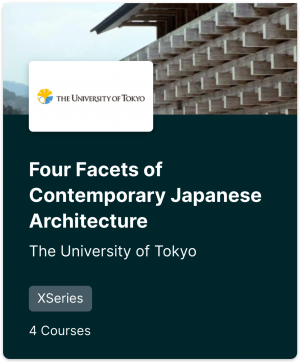
In this XSeries, you can take all four courses in the “Four Facets of Contemporary Japanese Architecture” series: “1st Facet: Theory,” “2nd Facet: Technology,” “3rd Facet: City,” and “4th Facet: Humans”. In the paid course [Verified Track], you will receive a certificate of completion by answering comprehension quizzes, but you can also view all lecture videos in the free course [Audit Track].
In this series, we have looked back on the turbulent half-century since Japan’s reconstruction after World War II, focusing on the four facets of architecture, together with the architects involved. We hope that many people will find it useful as a resource for considering the future of architecture and humanity.
Contents
FOUR FACETS OF CONTEMPORARY JAPANESE ARCHITECTURE: Theory1-1. Revisiting Kenzo Tange, Yoyogi 1st Gymnasium (1964)1-2. In Search of a Space – Arata Isozaki, The Museum of Modern Art, Gunma (1974)1-3. Learning from Style – Hisao Kohyama, Sainokuni Saitama Arts Theater (1994)1-4. New Primitivism – Terunobu Fujimori, La Collina Omihachiman (2014)1-5. Connecting the Dots – Hidetoshi Ohno, Heart Nursery School (2014)1-6. Architect without Architecture – Kengo Kuma, Asakusa Culture Tourist Information Center (2012)1-7. Too Large As Architecture Too Small As City – Kazuyo Sejima, Inujima “Art House Project” (2010-)1-8. Review – 1st Facet: Theory
FOUR FACETS OF CONTEMPORARY JAPANESE ARCHITECTURE: Technology2-1. Architecture Lives Inside People – Tadao Ando, Atelier in Oyodo II (1991)2-2. Advancing Systemic Spaces – Kazuhiko Namba, BOXHOUSE 112 (2006)2-3. What Do You Want, Wood? – Shigeru Ban, La Seine Musicale (2017)2-4. Why I Went to Countryside? – Kengo Kuma, Yusuhara Wooden Bridge Museum (2010)2-5. Design by Reinterpretation – Manabu Chiba, KOGAKUIN UNIVERSITY 125TH MEMORIAL EDUCATION CENTER (2012)2-6. In Praise of Errors – Yusuke Obuchi, DFL Pavilion (2015)2-7. Review – 2nd Facet: Technology
FOUR FACETS OF CONTEMPORARY JAPANESE ARCHITECTURE: City3-1. Architectures in Unconditional Love – Fumihiko Maki, Hillside Terrace (1969-1992)3-2. Architecture for the People – Itsuko Hasegawa, Niigata City Performing Arts Center (1998)3-3. Transparency: Literal & Behavioral – Riken Yamamoto, Saitama Prefectural University (1999)3-4. Worldly Architecture – Kengo Kuma, Nagaoka City Hall Aore (2012)3-5. Towards an Architecture of Emancipation – Jun Aoki, Omiyamae Gymnasium (2014)3-6. architecture After Architecture – Atelier Bow-Wow, Koisuru-Buta Laboratory (2012)3-7. Review – 3rd Facet: City
FOUR FACETS OF CONTEMPORARY JAPANESE ARCHITECTURE: Humans4-1. Architecture is Fiction – Hiroshi Hara, Hara House (1974)4-2. Constructing From Subconscious Images – Toyo Ito, Toyo Ito Museum of Architecture, Imabari (2011)4-3. Towards an Architecture of Interiority – Osamu Ishiyama, Gen An (1975)4-4. Living Room of the City – Kengo Kuma, V&A Dundee (2018)4-5. A House for Living Together – Satoko Shinohara, SHARE yaraicho (2012)4-6. Respect the World – Sou Fujimoto, SHIROIYA HOTEL (2020)4-7. Review – Kengo Kuma & Yusuke Obuchi, Japan National Stadium (2019)
Online courses from The University of Tokyo: https://www.edx.org/school/utokyoxIntroduction Page on the T—ADS Website: https://t-ads.org/mooc
オンライン講座「現代日本建築の四相—二つのオリンピックの狭間で」Xシリーズ スタート

このXシリーズでは、オンライン講座「現代日本建築の四相」シリーズの4つの講座「第一相:理論」「第二相:技術」「第三相:都市」「第四相:人間」のすべてを受講できます。有料コースでは、理解度を試すクイズに答えることで修了証を受けられますが、無料コースでも、すべての講義映像を視聴できます。
このシリーズでは、戦後の高度成長から現在にいたる日本の激動の半世紀を、建築の四つの相に着目して、その当事者であった建築家とともに振り返ってきました。ぜひ、これからの建築と人間の進む道を考えるための資料として、多くの方に役立てていただけることを願っています。
出演建築家
第一相:理論磯崎新、香山壽夫、藤森照信、大野秀敏、隈研吾、妹島和世
第二相:技術安藤忠雄、難波和彦、坂茂、隈研吾、千葉学、小渕祐介
第三相:都市槇文彦、長谷川逸子、山本理顕、隈研吾、青木淳、アトリエ・ワン(塚本由晴・貝島桃代)
第四相:人間原広司、伊東豊雄、石山修武、隈研吾、篠原聡子、藤本壮介
edXの東京大学サイト:https://www.edx.org/school/utokyoxT—ADS内の紹介ページ:https://t-ads.org/mooc
Free Online CourseFOUR FACETS OF CONTEMPORARY JAPANESE ARCHITECTURE — BETWEEN TWO OLYMPICSFourth Facet: Humans
Course Page on edX: Four Facets of Contemporary Japanese Architecture: Humans
Economic miracle, environmental problems, bubble economy and its collapse, information technology and globalization, earthquakes, population decline, pandemic… The nearly 60 years between the two Tokyo Olympics, 1964 and 2021, was a turbulent time for humans in Japan. During this period, how has architecture changed? And what happened to humans that architecture was supposed to have supported?
This course on “Humans” will review the works of those architects who have attempted to conceptualize humans through their architecture and examine the changes over the last half century as well as the issues for the future. Hiroshi Hara, Toyo Ito, Osamu Ishiyama, Kengo Kuma, Satoko Shinohara, and Sou Fujimoto visit their buildings to discuss the ideas behind their respective works.
Course Contents1. Architecture is Fiction – Hiroshi Hara, Hara House (1974)2. Constructing From Subconscious Images – Toyo Ito, Toyo Ito Museum of Architecture, Imabari (2011)3. Towards an Architecture of Interiority – Osamu Ishiyama, Gen An (1975)4. Living Room of the City – Kengo Kuma, V&A Dundee (2018)5. A House for Living Together – Satoko Shinohara, SHARE yaraicho (2012)6. Respect the World – Sou Fujimoto, SHIROIYA HOTEL (2020)7. Review – Kengo Kuma & Yusuke Obuchi, Japan National Stadium (2019)
This course is the fourth in the series, following “First Facet: Theory,” “Second Facet: Technology,” and “Third Facet: City,” which are currently open to the public.
Free online courses from The University of Tokyo: https://www.edx.org/school/utokyox
Introduction Page on the T—ADS Website: https://t-ads.org/mooc
無料オンラインコース現代日本建築の四相 — 二つのオリンピックの狭間で第四相:人間
オンライン講座(MOOC)プラットフォーム edX より公開Four Facets of Contemporary Japanese Architecture: Humans
高度成長、環境問題、バブル景気とその崩壊、情報化とグローバリズム、震災、人口減少、パンデミック… 1964年と2021年、2回の東京オリンピックの間の日本の約60年間は、人間をとりまく状況が大きく変化した激動の時代でした。この期間に、建築はどう変わったのでしょうか? また、建築が支えていたはずの人間はどうなったのでしょうか? 「人間」をテーマにした今回の講座では、この激動の期間を振り返りながら、建築と人間の現在と未来について考えます。
出演建築家:原広司、伊東豊雄、石山修武、隈研吾、篠原聡子、藤本壮介
このコースは、公開中の「第一相:理論」、「第二相:技術」、「第三相:都市」につづく第四弾です。
edXの東京大学サイト:https://www.edx.org/school/utokyox
T—ADS内の紹介ページ:https://t-ads.org/mooc
Intro Videos
Press release Embassy of Switzerland in Japan, 14.07.2022
A collaborative program of Aichi Trienniale 2022
July 30 to October 10, 2022At the Tokoname City Pottery Footpath (Sakae-cho 7-chome, Tokoname-shi, Aichi)
Switzerland and Japan explore the future of architecture at Aichi Triennale 2022! Kizuki-au 築き合う— Collaborative Constructions consists of two installations by Gramazio Kohler Research from ETH Zurich and T_ADS Obuchi Lab from the University of Tokyo. The project sheds light on digital processes in architecture, human-robot interactions and cross-pollination between technology and culture.
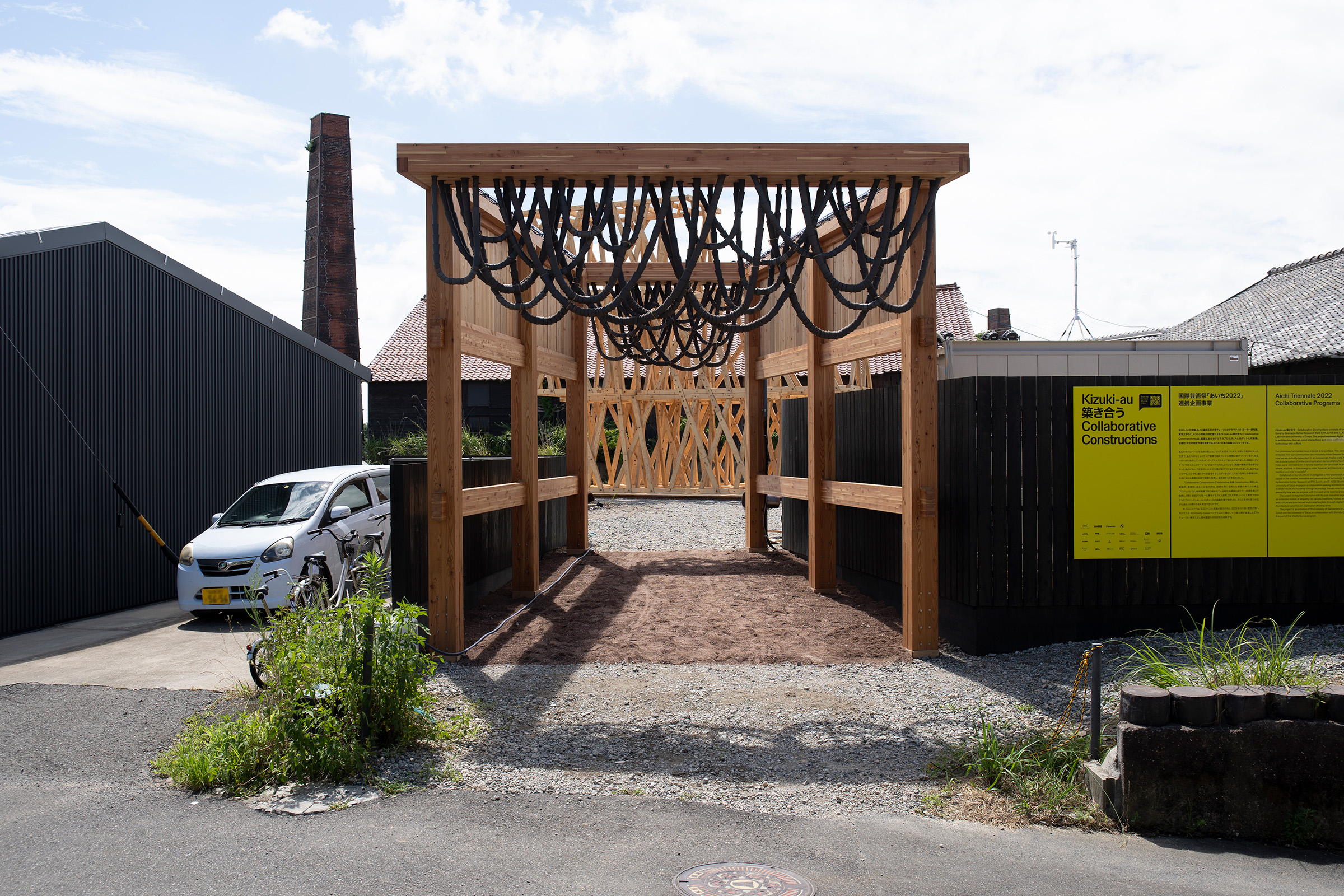
Our globalised societies have entered into a new phase. The pandemic has revealed how our communities are intricately linked beyond national borders, in a world that has become more fragile. At the same time, the widespread popularization of online communication demonstrates how technology is helping to re-connect in times of forced isolation; we can talk to anyone, anywhere, almost anytime. In this emerging order, we ask how architecture can reimagine its own tradition and role in society.
Collaborative Constructions investigates a new practice of architecture based on the creative, innovative and personal use of technology. The two projects by ETH Zurich and the University of Tokyo engage in a global collaboration looking at architectural strategies to relate nature and humanity through technology; they are results of human-robots collaborations and exemplify how we can engage with the past while looking ahead.

The project by Gramazio Kohler Research from ETH Zurich in Switzerland is a three-storey all-timber frame structure, which revives the long history of expert timber construction in Japan through Swiss design and technology. It revisits carpentry for the age of robotics, making metal parts, nails, screws or fasteners obsolete. The five constituting timber frame modules consist of more than a thousand bespoke timber elements and were prefabricated in the world-renowned Robotic Fabrication Laboratory at ETH Zurich. Designed to withstand earthquakes and storms, it is a towering structure, which activates its surrounding neighbourhood and landscape, while the wooden terrace or Japanese engawa serves as a meeting point for the community. Age-old knowledge has been revived through digital technologies, allowing for a highly material efficient and performative approach to building with timber. A new strategy for building multi-storey timber buildings is thus suggested as a sustainable alternative to conventional concrete and steel constructions.
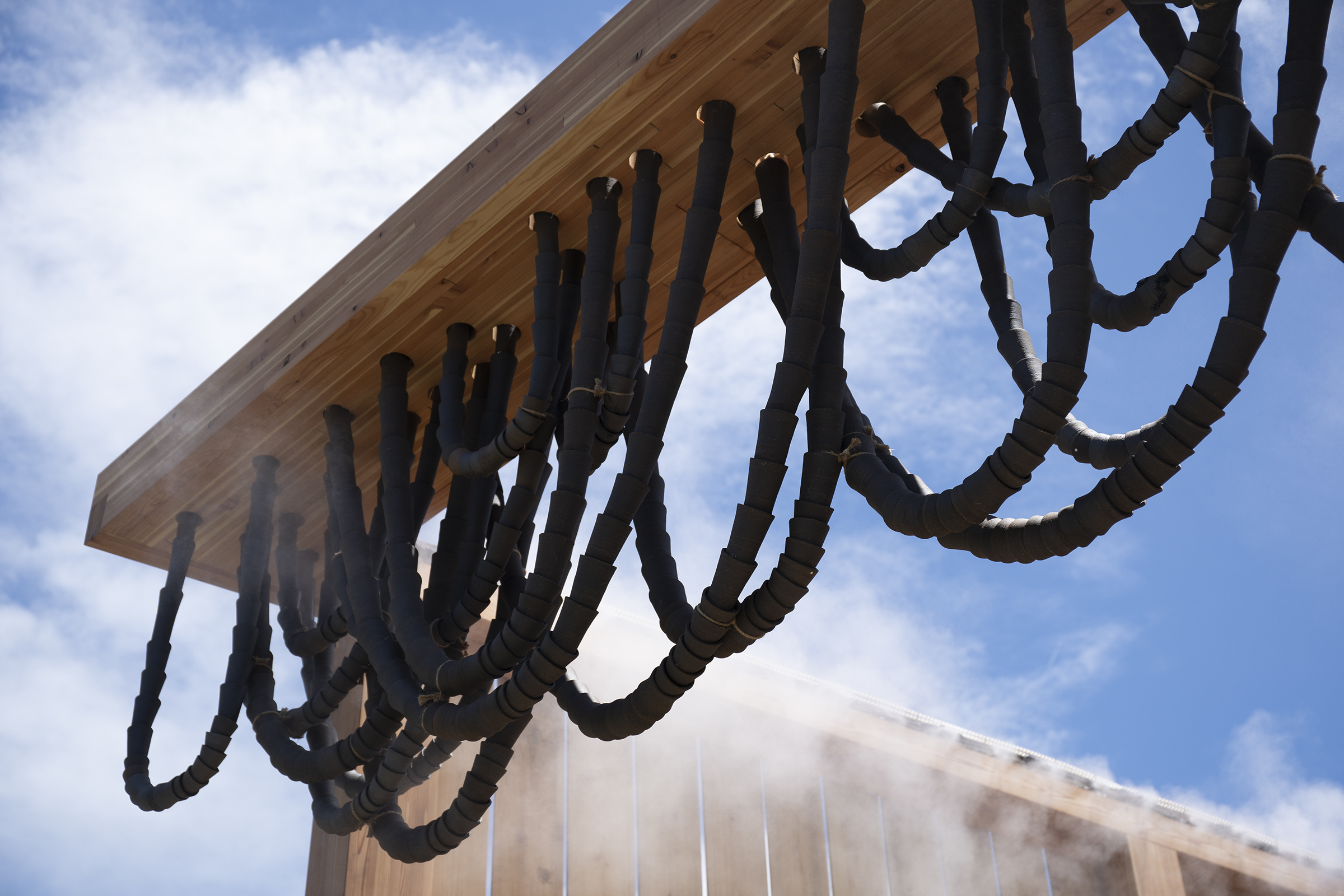
The project by T_ADS Obuchi Lab from the University of Tokyo is a gate-like structure made of wooden posts and beams, serving as an entrance to the courtyard surrounded by an old pottery factory. A series of pottery chains hanging from the gate’s beams form a large screen and resemble a traditional noren. It is a visual sign to welcome the visitors as well as an evaporative cooler, a natural climate control, in which mist dampens the surfaces of the pottery. On a hot day, the evaporative cooling effect of the pottery is expected to cool the gate area by 4 to 5 degrees Celsius.
At the heart of the project is the fabrication of the hanging pottery chains. While the pattern appears to be random at first glance, its generation requires an intricate algorithm, an algorithm that brings human and machine together. The pottery chains are created by a series of feedback processes between a person and a robot. Each person makes a uniquely defined shape of pottery chain by holding it so that it hangs from their arms without touching the ground. The robot then finds a location on the beam for its installation within the given dimension of the beam and structural requirements. The final design of the overall patterns, made of forty-five of the hanging chains, are generated by children and adults with different physiques and strength reflecting their individuality into the whole.

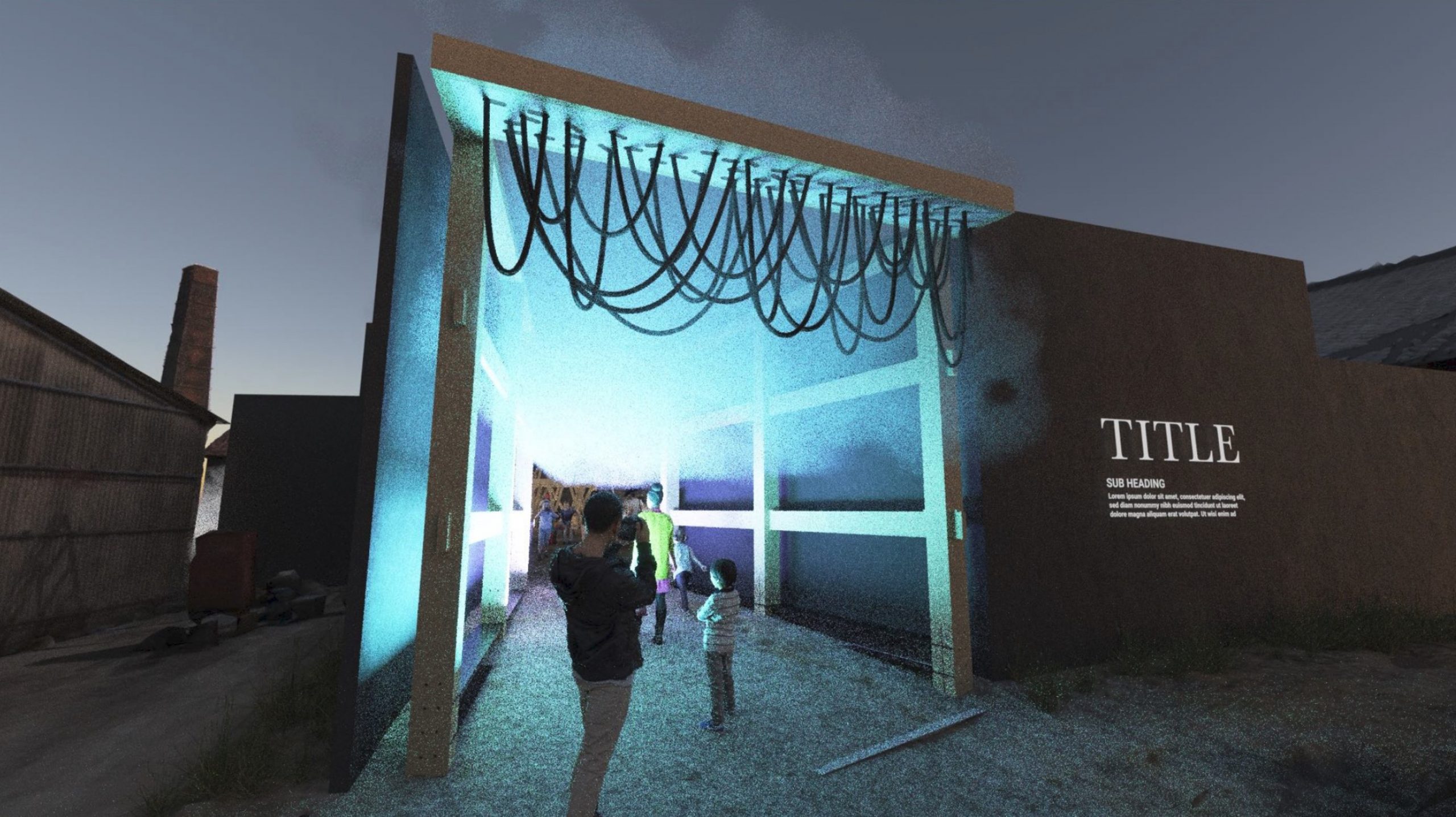
Faced with the post-industrial legacy of Tokoname, the collaboration between ETH Zürich and the University of Tokyo reimagines the place through an extended notion of empathy: its people, traditions, history, environment and culture are all intertwined and made tangible through digital processes in fabrication and construction. Architecture becomes a form of living knowledge, an expression of being alive.
Collaborative Constructions is an initiative of the Embassy of Switzerland in Japan, ETH Zurich and the University of Tokyo, in collaboration with Shimizu Corporation. The project is part of Vitality.Swiss, Switzerland’s program on the road to Expo 2025 Osaka-Kansai.
Kizuki-au 築き合う-Collaborative Constructions
Period July 30 to October 10, 2022 Open time 11:00 – 19:00Venue 79, 80, 83, 84, Sakae-cho 7-chome, Tokoname-shi, Aichi, JapanFree of chargeMore info. www.vitality.swiss
OrganizersEmbassy of Switzerland in Japan / Vitality.SwissGramazio Kohler Research, ETH ZurichT_ADS Yusuke Obuchi Laboratory, Department of Architecture, Graduate School of Engineering, The University of Tokyo
Project CollaboratorShimizu Corporation
PartnersIWC SchaffhausenBMW Japan
Panasonic Holdings Corporation
LIXIL CorporationERNE AG BauunternehmungCypress Sunadaya Co., Ltd.VitraJun Sato Laboratory, Department of Socio-Cultural Environmental Studies, Graduate School of Frontier Sciences, The University of TokyoKalt Maschinenbau AGSJB Kempter Fitze AGKnapp AGRaimund BECK KG
MONTAGE Inc.Tokoname CityThe University of Tokyo, Strategic Partnerships Project
State Secretariat for Education, Research and Innovation SERIFDFA, Presence Switzerland
Kizuki-au、築き合う– Collaborative Constructions
Our globalised societies have entered a new phase. The pandemic has revealed how our communities are intricately linked beyond borders and how mutually dependent we are in an evermore fragile world. Meanwhile, the popularization of online communication demonstrates how technology helps us re-connect even in forced isolation; we could talk to anyone, anywhere, anytime. In this emerging order, how can architecture reimagine its tradition and role in society?
Collaborative Constructions investigates a new practice of architecture based on the creative, innovative and personal use of technology. The projects by Gramazio Kohler Research at ETH Zurich, and T_ADS Obuchi Lab of the University of Tokyo engage in a collaboration seeking architectural strategies to relate nature and humanity through technology; human-robot collaborations exemplify how we can engage with the past while looking ahead.
The project reimagines Tokoname with its post-industrial legacy, through an extended notion of empathy: its people, traditions, history, environment and culture are intertwined and made tangible through digital fabrication. Architecture becomes an expression of being alive.
The project is an initiative of the Embassy of Switzerland in Japan, ETH Zurich and the University of Tokyo, in collaboration with Shimizu Corp. It is part of the Vitality.Swiss program.
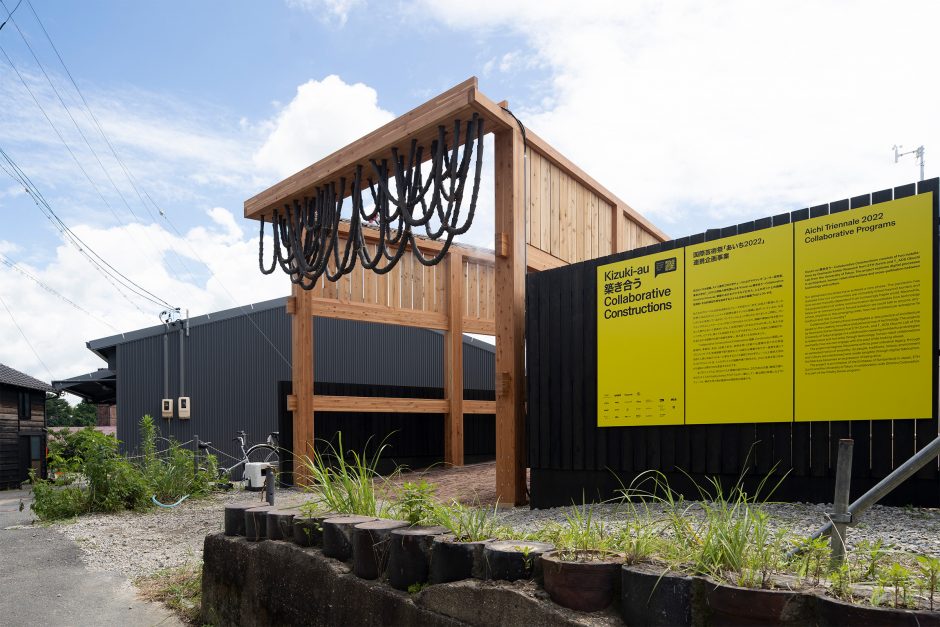
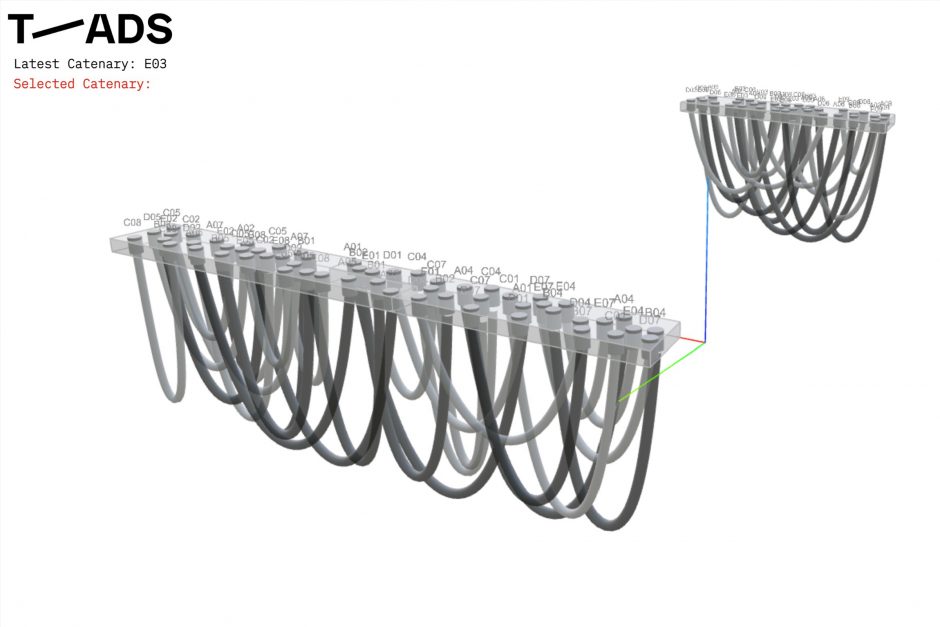
Participatory Shape Generation

Each person makes a uniquely defined shape of pottery chain by holding it with different physiques and strengths reflecting their individuality.
Real-time Optimization
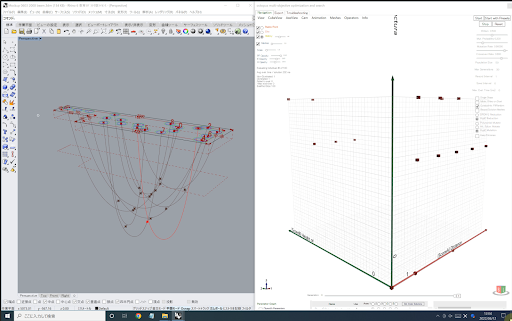
The heart of the project is the fabrication of the hanging pottery chains. While the pattern appears to be random at first glance, its generation requires an intricate algorithm, an algorithm that brings humans and machines together.
Robotic Drilling
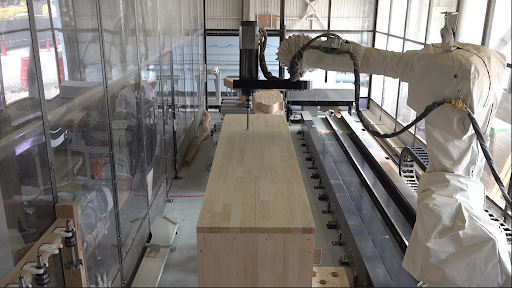
“Collaborative Constructions” combines elements of traditional architectural construction, culture, and natural materials with modern digital technologies such as computational design and robotics fabrication.
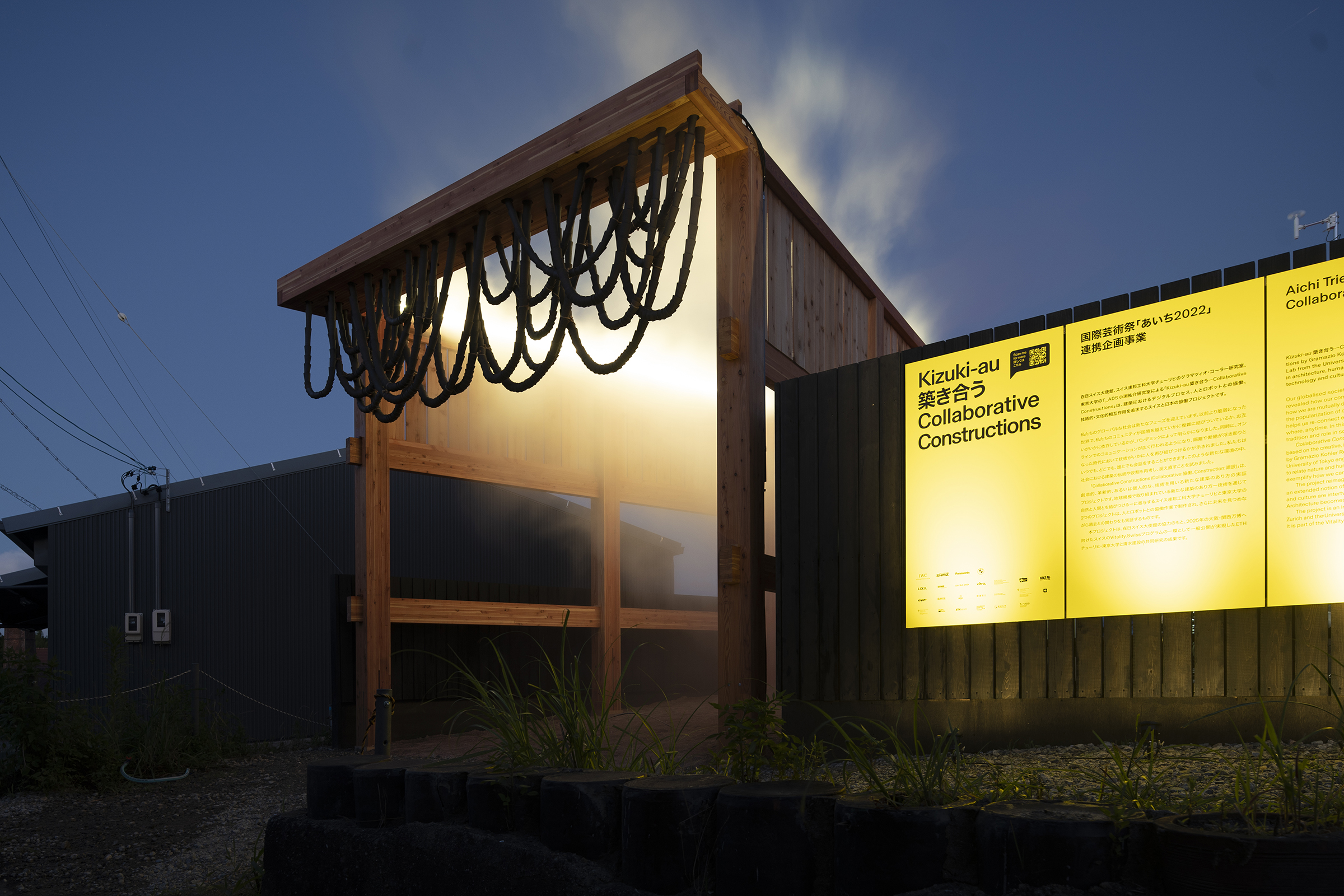
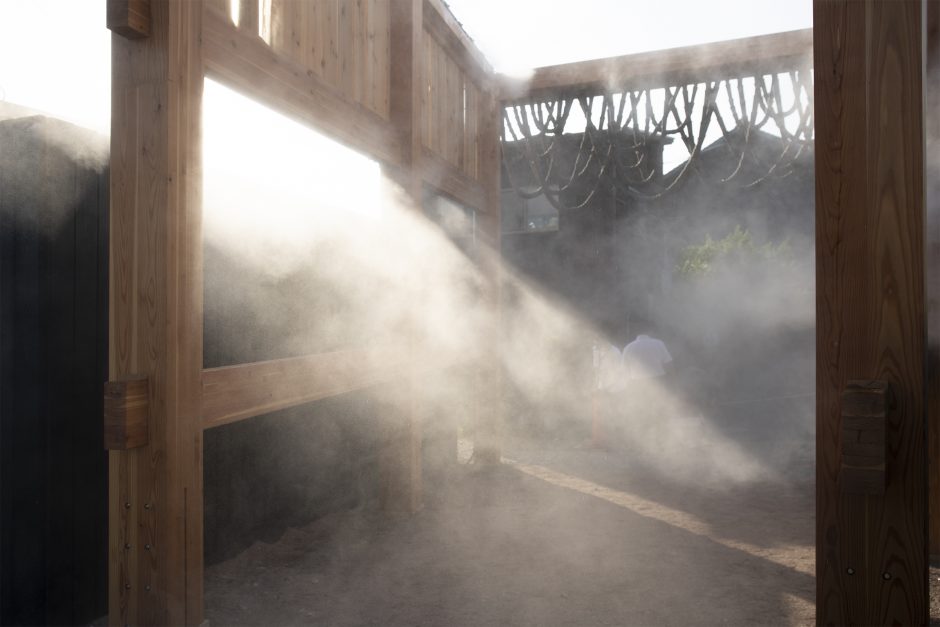
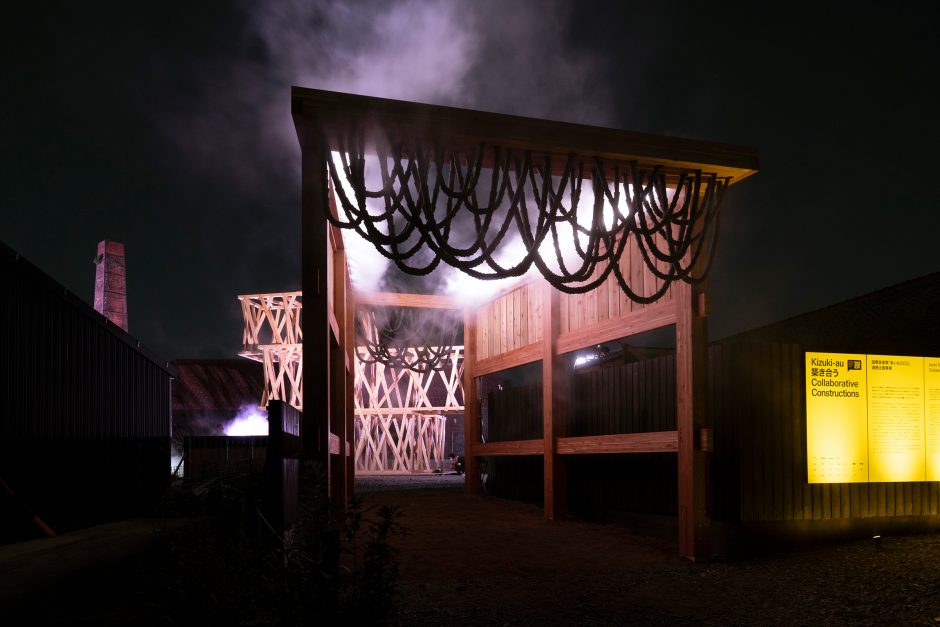
Collaborative Constructions
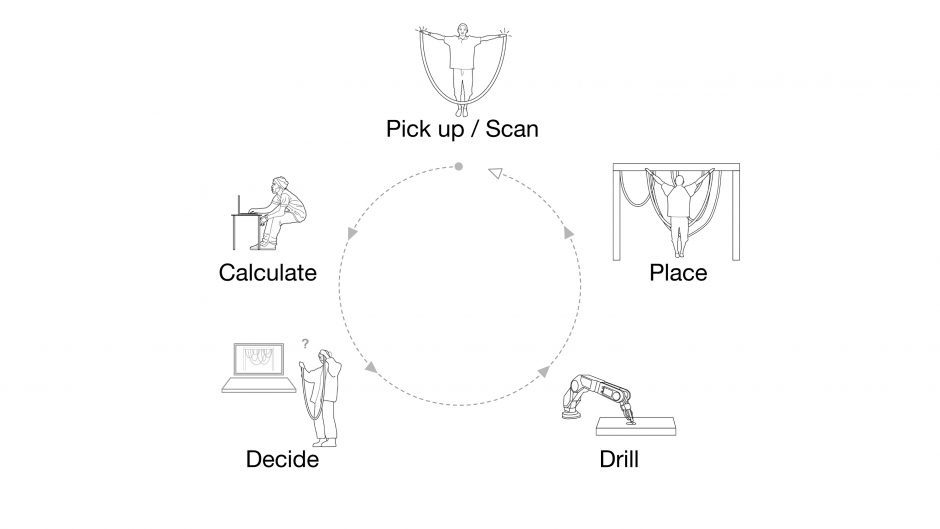
Process Chronology
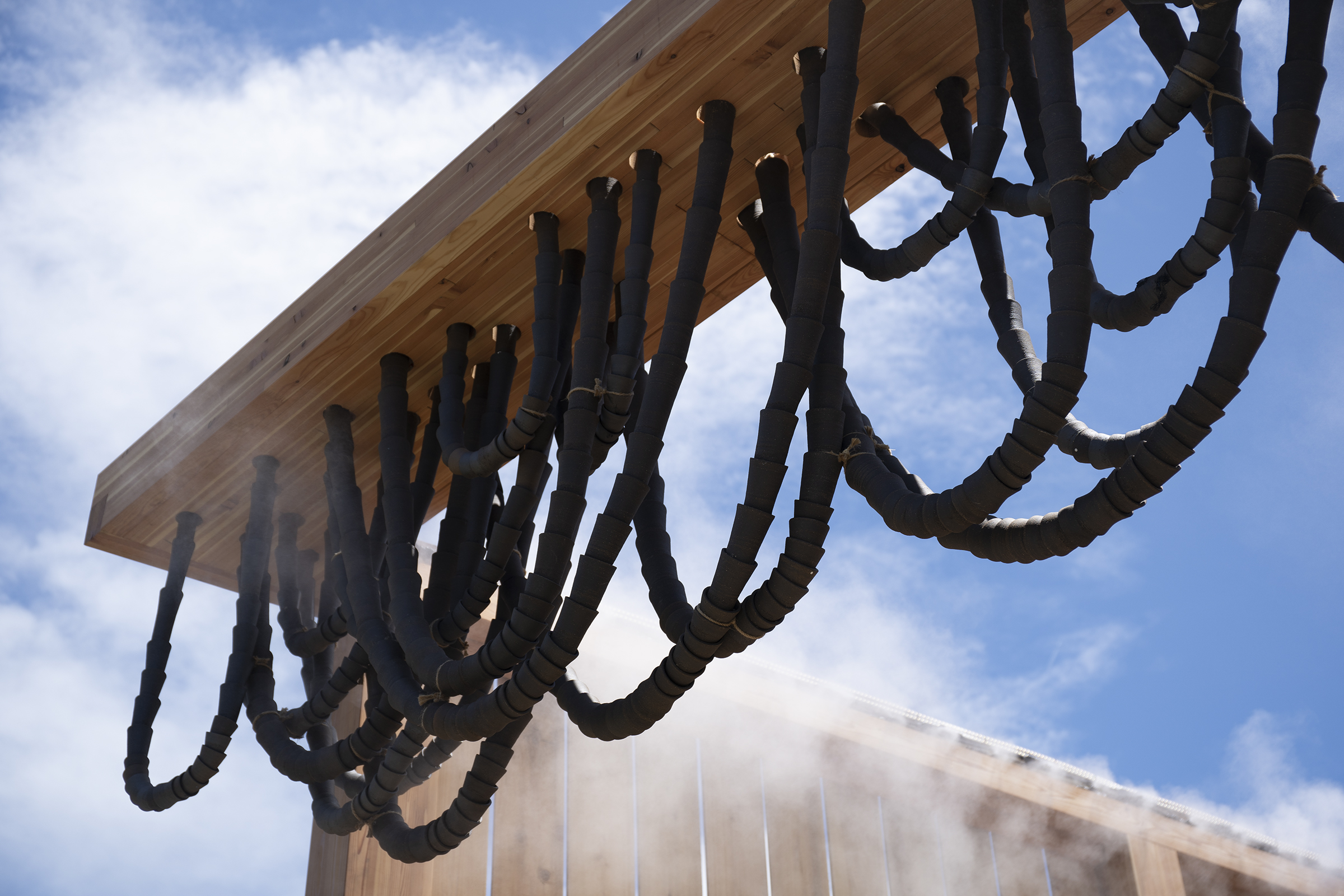
Human Scaled Participatory Shape Generation



The pottery chains are created by a series of feedback processes between a person and a robot. The pottery chains are created by a series of feedback processes between a person and a robot. Sensors are placed on each subject’s hand so that the information-gathering process is as natural as possible.


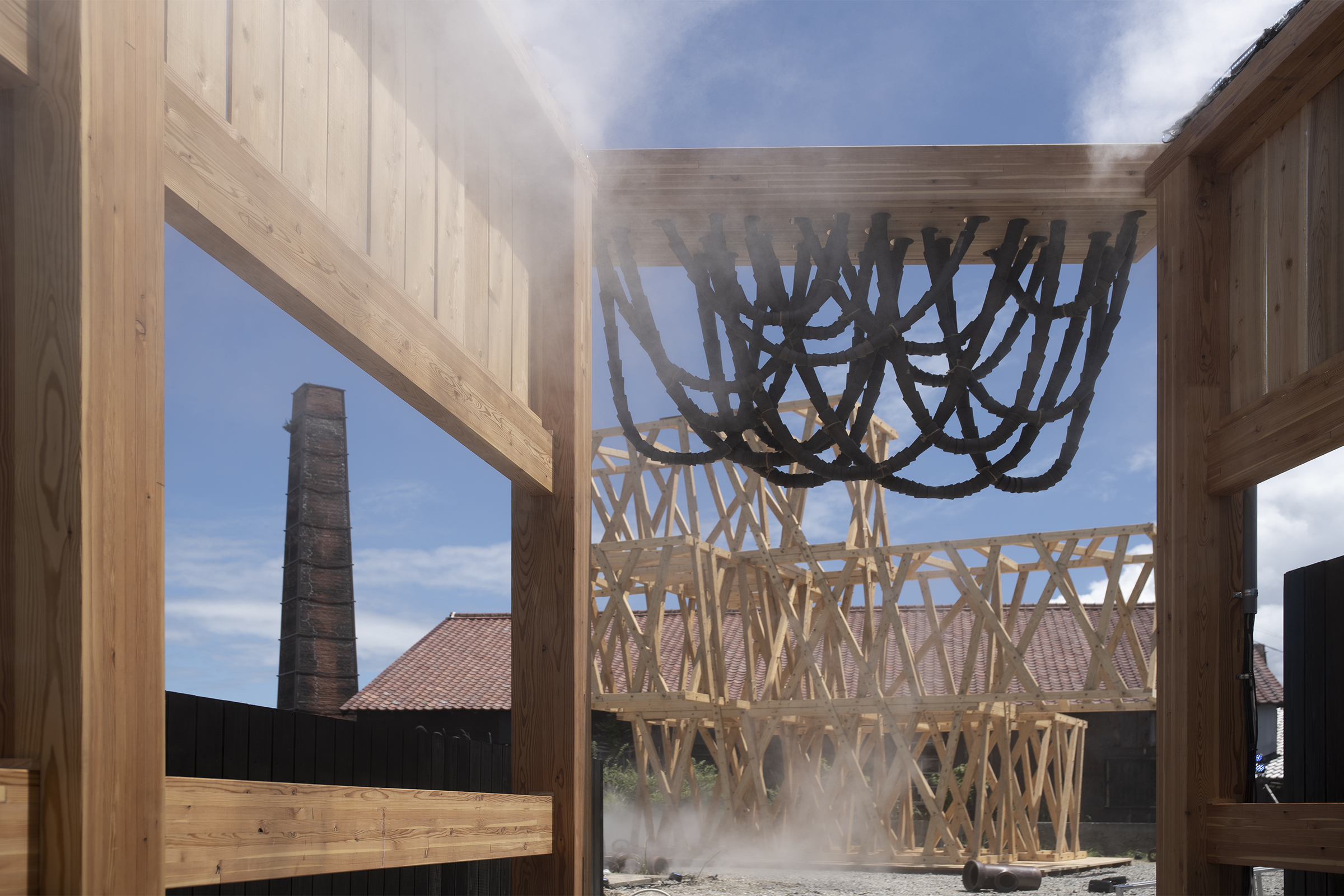
Real-time Optimization Controlling Design Outcome
Optimization Criteria

Tangential Connections
Distance between catenaries should be within a certain domain to avoid intersection, but meanwhile should allow to be tied together.

Intersection Height
Position of connections should be far away enough from the beam to ensure structural stability.

Structural Continuity
Each drilling point should have direct route for force transmission to the edge of the beam.

Human Evaluation / Decision

Searching for Optimized Placement Options

Human Evaluation / Decision

Real-time decisions controlling Design Outcome
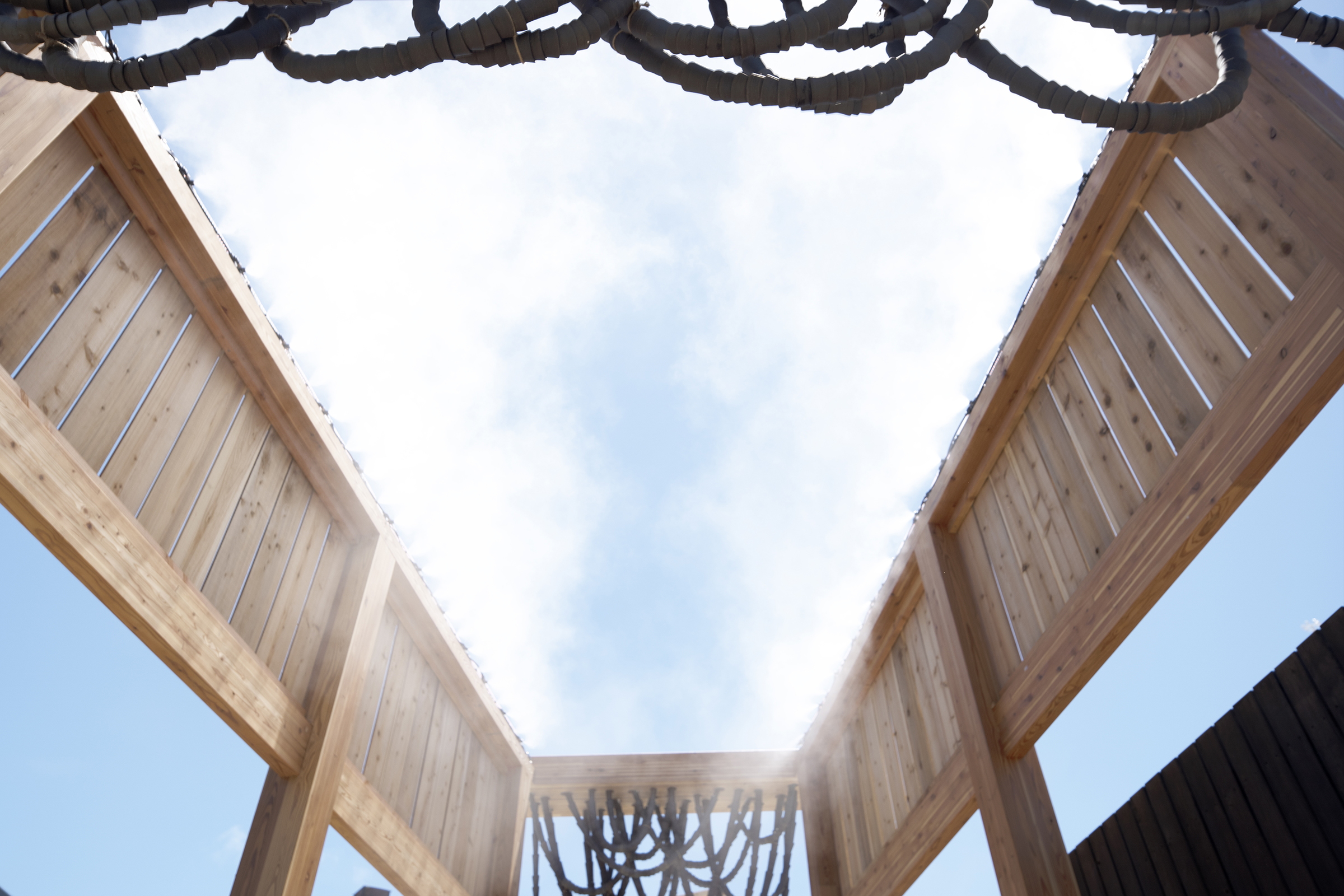
Robotic Drilling and Assembly



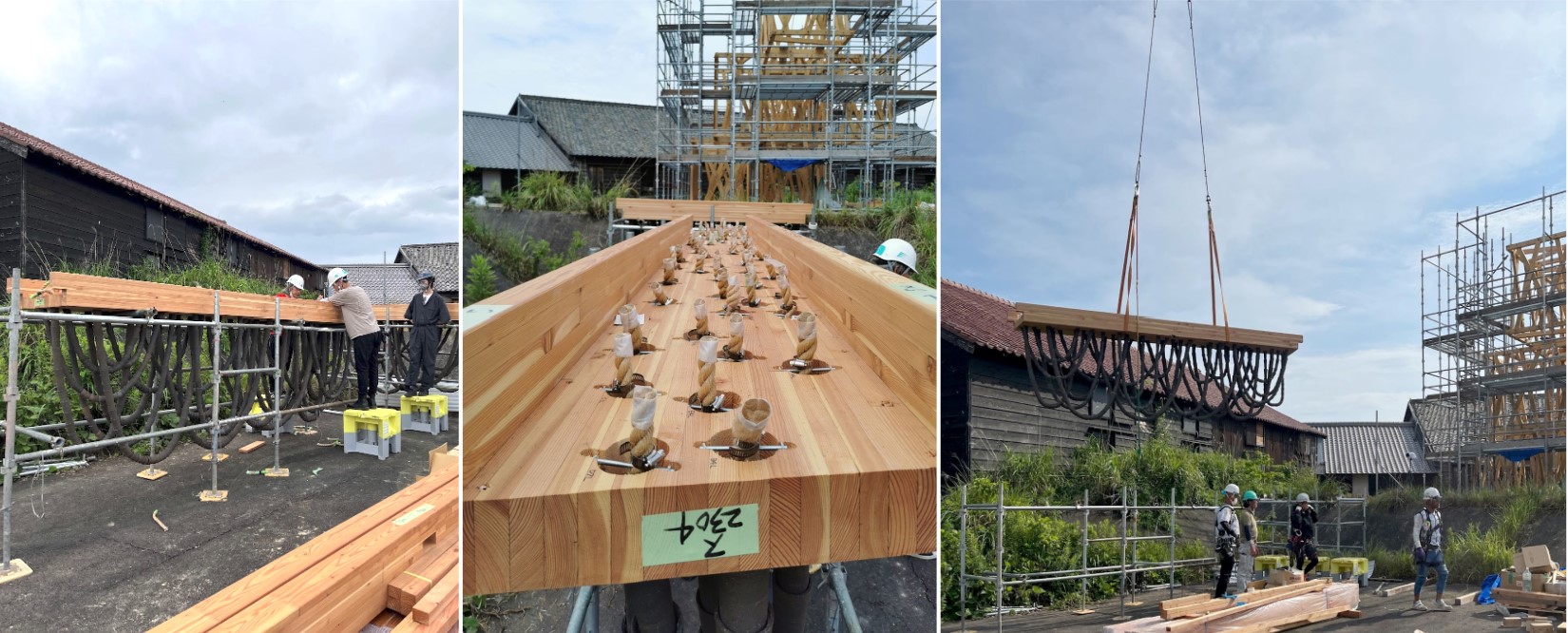
Credits:
University of Tokyo Obuchi LaboratoryYusuke ObuchiShuta Takagi, Yusuke Komate
2021-2022Alex Orsholits, Zhou Li, Cheng Zhe Zhu, Kritika Dhupar
2020-2021Alex Orsholits, Annette Choi, Zhou Li
2019-2020Alex Orsholits, Aungsoe Pyaezone, Boon Hau Lim, Campbell Meredith Argenzio, Dominika Demlova, Hao Li, Ke Zhou, Surjyatapa Ray Choudhury, Yiyuan Qian, Yucheng Zeng, Annette Choi, Zhou Li
Digital Fabrication Research Collaborator:Shimizu Corporation Construction Technology Division
Construction:Shimizu Corporation
Mist Design:Panasonic Holdings CorporationManufacturing Innovation Division
Structural Design:University of Tokyo Jun Sato Laboratory
Pottery Production Advisor:LIXIL CorporationINAX Museums Cultural Promotion Department
Pottery Artist:Daisuke Tominoto, Sachiko Iketani
東京大学 小渕祐介研究室、佐藤淳研究室がプロジェクトサポートとして参画した「ヴェネチア・ビエンナーレ国際建築展 アラブ首長国連邦(UAE)館: Wetland」が最優秀賞にあたる金獅子賞を授賞しました。
小渕研究室は佐藤研究室と協働し、プロジェクトの初期段階から現地における施工段階まで、デジタルファブリケーションシステムの開発を担当しました。
施工計画をはじめとし、デジタル計測/施工ツールデザインや、施工の観点からのマテリアルデザインを通じて、これまでの小渕研究室のテーマでもあった「リアルタイム/オンラインでの施工プロセスの最適化」を追求し、世界規模の感染症が蔓延する状況の中、国際的なリモート環境でデジタルファブリケーションシステムを実現しました。
Venice Biennale Architecture Exhibition is one of the most respected architecture exhibitions in the world. With a request from Kenichi Teramoto and Wael Al Awar, curators of the UAE (United Arab Emirates) National Pavilion, Jun Sato’s laboratory and Yusuke Obuchi’s laboratory collaborated to support the UAE’s commissioners and ambitions. The UAE produces a large amount of salt as a byproduct during the desalination process of seawater. The main concept of the pavilion was to utilize magnesium, which was extracted from the salt, and use it as a hardening agent for building parts made of cement.
Sato-Lab proposed a simple solution for the production of 2500 pieces of the cement parts within a tight time constraint; make shallow trenches in the ground as a formwork and pour cement to be cured. This production process resulted in the making of “coral-shaped” pieces. We also proposed a structural design by synchronizing with Obuchi sensei’s digital fabrication guiding system for sequential structural optimization to develop an assembly logic.
Obuchi-Lab has designed and developed a human centric digital fabrication system which supported assembly crew members on site by connecting them with real-time spatial and geometrical information of the 2500 pieces to be installed in a designated area. When pieces were installed in a shape of ring and formed a layer, collected spatial data of installed pieces was then analyzed for structural stability and overall geometrical accuracy. In the end of the fabrication process, we were able to create an architectural form as a result of integrating technology and nature, and craftsmanship and machine.
It is a great honor to be part of the work that received the Golden Lion, the highest award given , at this prestigious exhibition.
Joint statement by Jun Sato and Yusuke Obuchi
第17回 ヴェネチア・ビエンナーレ 国際建築展 審査委員長である妹島和世氏から、以下のようなメッセージを頂きました。
| 今回のベネチアビエナーレは、これまで以上に建築の枠を超えた新しい可能性を感じられる展示作品がたくさんありました。特に多くの最先端のテクノロジーを応用した作品には驚きました。また、ナショナル・インターナショナル、どちらのパビリオンにおいても、国境を超えてさまざまな国々から集まって構成され、そして企画された展示が多くみられ、UAEパビリオンも中東、日本、アメリカなど複数の国々からのメンバーで成り立っており、そこで東京大学の2つの研究室が技術協力を行なった事はとても嬉しく思いました。日本においてもこれ迄以上に研究活動が海外に広がり活躍されることを期待しています。小渕先生と佐藤先生、素晴らしい作品、金獅子賞おめでとうございます。
妹島和世 |
| At this Venice Biennale, there were many exhibited works that dealt issues beyond the convention of architecture more than ever and hinted new possibilities. I was particularly surprised to see many works that applied cutting-edge technologies. Also, in both National and International pavilions, there were many exhibitions organized by a team of participants joined from various countries across national borders. The UAE Pavilion’s team was also made up of collaborators from multiple countries such as the Middle East, Japan, and the United States. I was very pleased that the two laboratories of the University of Tokyo provided technical corporation for the work. I hope that research activities in Japan will expand more and reach out overseas and play an active role.
Congratulations to Dr. Obuchi and Dr. Sato for their wonderful work and the Golden Lion Award. Kazuyo Sejima, Architect |
DataSheet
- プロジェクト期間:2019年12月 – 2021年8月
- 担当業務:
- 小渕祐介研究室
- パビリオンのデジタルファブリケーションシステムデザイン
- コンクリート部材位置のスキャニングツール、システムの開発
- コンクリート部材施工のガイディングツール、システムの開発
- コンクリート部材配置のオンラインデータベースの構築
- 構造最適化計算のオンライン統合ネットワークシステムの構築
- webサイト開発(https://venice2021.t-ads.org/) 開発:Alex Orsholits
- 佐藤淳研究室
- 構造設計
- コンクリート調合設計
- ピース形状スタディ、最適化
- モックアップ構造実験
- 構造最適化プログラム開発
- 2研究室協働
- 立体形状最適化、決定
- 平面計画、立面計画
- ドキュメント作成、記録
- 小渕祐介研究室
The University of Tokyo project team
Yusuke Obuchi,Associate Professor, Department of Architecture
Jun Sato, Associate Professor, Department of Socio Cultural Environmental Studies
Shuta Takagi, Obuchi Lab Support Specialist
Yusuke Komata, Obuchi Lab Support Specialist
Project consultants (Sato Lab)
Mika Araki, Associate Professor, Kwansei Gakuin University School of Architecture / Mika Araki Structural Engineers
Kosuke Suehiro, Jun Sato Structural Engineers Co., Ltd.
Obuchi Lab – student assistant credit list
Construction System & Network Development: Alex Orsholits
Scanning & Guiding Hardware Design: Zhou Li
System Documentation: Annette Choy de Leon
Scanning System: Pyaezone Aungsoe, Meredith Campbell Argenzio, Boon Hau Lim, Surjyatapa Raychoudhury
Guidance System: Yiyuan Qian
Sato Lab – student assistant credit list
Structural Optimization System Development: Ren Imai, Shimpei Kojima, Yusuke Shimoyamada
Manufacturing & Structural Assemblage Development: Hirotaka Ujioka, Kenta Isebo
Construction Test: Ryoma Kanazawa, Miho Wada, Kousuke Miyano
Official Credit
Commissioner: Salama Bint Hamdan Al Nahyan Foundation
Supporter: UAE Ministry of Culture and Youth
Curators: Wael Al Awar and Kenichi Teramoto
Venue: Arsenale
Exhibitors
Urban Researchers: Ahmed & Rashid Bin Shabib
Researchers
Wetland Research Team
New York University, Abu Dhabi, Amber Lab
University of Tokyo, Sato Lab and Obuchi Lab
American University of Sharjah, Department of Biology, Chemistry and Environmental Sciences
https://www.labiennale.org/en/news/awards-17th-international-architecture-exhibition
Release
Venice Biennale AWARDS Official Release:
https://www.labiennale.org/en/news/awards-17th-international-architecture-exhibition
designboom:
https://www.designboom.com/architecture/uae-golden-lion-best-national-pavilion-venice-architecture-biennale-08-30-2021/
ArchDaily:
https://www.archdaily.com/967667/uae-wetland-wins-the-golden-lion-for-best-national-participation-at-the-2021-venice-biennale
Free Online CourseFOUR FACETS OF CONTEMPORARY JAPANESE ARCHITECTURE — BETWEEN TWO OLYMPICSThird Facet: City
Course page on edX: Four Facets of Contemporary Japanese Architecture: City
After the 1970s, Japanese architects are said to have stopped conceptualizing cities and instead focused on designing the individual buildings that make up the cities. However, as cities continue to undergo significant transformations in response to globalization, the advent of information technologies, and so on, Japanese architects are once again engaging the city, and doing so in unique ways.
This course on “City” will review the works of those architects who have attempted to conceptualize cities through their architecture and examine the changes over the last half century as well as the issues for the future. Fumihiko Maki, Itsuko Hasegawa, Riken Yamamoto, Kengo Kuma, Jun Aoki, and Atelier Bow-Wow (Yoshiharu Tsukamoto & Momoyo Kaijima) visit their buildings to discuss the ideas behind their respective works.
Course Contents1. Architectures in Unconditional Love – Fumihiko Maki, Hillside Terrace (1969-1992)2. Architecture for the People – Itsuko Hasegawa, Niigata City Performing Arts Center (1998)3. Transparency: Literal & Behavioral – Riken Yamamoto, Saitama Prefectural University (1999)4. Worldly Architecture – Kengo Kuma, Nagaoka City Hall Aore (2012)5. Towards an Architecture of Emancipation – Jun Aoki, Omiyamae Gymnasium (2014)6. architecture After Architecture – Atelier Bow-Wow, Koisuru-Buta Laboratory (2012)7. Review – 3rd Facet: City
This course is the fourth in the series, following “First Facet: Theory,” and “Second Facet: Technology,” which are currently open to the public.
Free online courses from The University of Tokyo: https://www.edx.org/school/utokyox
Introduction Page on the T—ADS Website: https://t-ads.org/mooc
無料オンラインコース 現代日本建築の四相 — 二つのオリンピックの狭間で 第三相:都市
オンライン講座(MOOC)プラットフォーム edX より公開中Four Facets of Contemporary Japanese Architecture: City
広島ピースセンター(1955)、東京計画1960、東京オリンピック(1964)、大阪万博(1970)など、1950年代から60年代において、建築家丹下健三は、数多くの都市的プロジェクトに携わりました。しかし、1970年代以降の日本では、大規模プロジェクトの減少とともに、建築家たちは都市の構想から撤退し、個々の建物の設計に専念するようになったとも言われます。しかし現在、グローバリズムや情報技術の進歩などによって都市の概念すら変わりつつあるなか、建築家たちは再び都市と向き合い、独自の方法で活動を繰り広げています。第三相「都市」では、建築から都市を考えることを継続してきた現代建築家の活動を振り返りながら、この半世紀の間に何が変わったのか、これからの課題とともに考えます。
出演建築家:槇文彦、長谷川逸子、山本理顕、隈研吾、青木淳、アトリエ・ワン
このコースは、公開中の「第一相:理論」、「第二相:技術」につづく第三弾です。
edXの東京大学サイト:https://www.edx.org/school/utokyox
T—ADS内の紹介ページ:https://t-ads.org/mooc
Intro Videos
・オンラインシンポジウムのご案内
まちをはかる ―間地(まち)から紐解く都市の生態―
東京大学建築学専攻Design Think Tank 共同研究発表オンラインシンポジウム
主催: 東京大学建築学専攻Advanced Design Studies
共催: NTT都市開発株式会社 株式会社新建築社
東京大学建築学専攻Advanced Design Studies(以下、T_ADS)では、2015年5月、文化・経済活動が多様に相互作用する都市生態の把握と、都市デザインへの応用に取り組むDesign Think Tank(以下、DTT)を、NTT都市開発、新建築社との共同で立ち上げ、2019年度で最終年度を迎えました。
研究完了を迎え、2020年3月に実施予定だった共同研究発表シンポジウム「まちをはかる ―間地(まち)から紐解く都市の生態―」は、新型コロナウィルス感染症の拡大防止の目的で延期となりましたが、このたびオンラインシンポジウムに形を変え、下記の日程で実施に至りました。
2020年5月現在、コロナウィルスがもたらした影響として、今後都市部のオフィスに変化が生まれてくることが議論されています。社会は急速に分散型に移行していくだろうという議論もあります。
対して本研究では、そもそも都市開発の現場で用いられてきた駅近さ、築年数の浅さ、スケールメリット、集約性などの評価軸の中で見過ごされてしまっている、「都市が元来もっていた土地や文化に紐づく微差が生み出す魅力」を拾い出す、新しい尺度の提案を模索してきました。駅前に集約するだけではない都市の価値をどのように生み出していくのか、突如浮上したこうした課題に対し、本研究からも何がしかのヒントを発信できないかと考えます。
過去5年間のDTTの研究成果から、広く都市に関わる多くの専門家、研究者の方々を迎え、都市開発の可能性について提示し、来る研究や実務へその成果をつなげる機会にできればと考えています。
- シンポジウム詳細
日時:2020年6月4日(木)10:00-12:00(開場09:30)
会場:オンライン
【アドレス】
https://apj27.webex.com/apj27-jp/onstage/g.php?MTID=e0fb88a08620577e04215576934470b42
【パスワード】0604
※ 上記URLにアクセスいただくと、Webexのオンラインシンポジウム用参加画面に誘導されますので、❶お名前とメールアドレスを入力し、「今すぐ参加」をクリック、❷初めてwebexをご利用の方は、ブラウザにwebexのアドオンを追加する手続きを求められますので、誘導に従って、インストールを実施して参加して下さい。2回目以降の方はそのまま参加して下さい。❸シンポジウム開始後、音声が聞こえない場合は、画面下部に表示されている丸ボタンの内、・が3つ表示されている右から2番目のボタン「他のオプション」をクリックし、音声接続がつながっているか確認下さい。視聴するだけでも接続する必要があります。
※ 上記手続きでアドオンを追加したくない方は、「ブラウザから参加」を選択することも可能ですが、その場合システムの制約上、発表で予定している動画共有をご覧いただけない為、別途ストリーミングからご覧いただくかたちとなります。予めご了承下さい。
※ Webex経由でのイベント資料のダウンロードに時間がかかるようです。宜しければ、こちらからもイベント資料をダウンロードいただけます。 https://drive.google.com/file/d/1hCJ5R81ZVnCBx_84T9Y0–7e-e6HzDZD/view?usp=sharing
_ゲスト講演(10:05-):
島原万丈(官能都市指標ディレクター・LIFULL HOME’S総研 所長)
『Sensuous City [官能都市] –都市の本当の魅力を測るあたらしいモノサシの提案』
岩嵜博論(博報堂ミライの事業室 ビジネスデザインディレクター)
『REFRAMING THE OPPORTUNITY SPACE』
_基調研究発表(10:45-):
Design Think Tank研究チーム、東京大学建築学専攻小渕研究室
_公開ランドテーブル(11:15-):以下、パネリスト
島原万丈(官能都市指標ディレクター・LIFULL HOME’S総研 所長)
岩嵜博論(博報堂ミライの事業室 ビジネスデザインディレクター)
隈研吾(東京大学大学院工学部研究科建築学専攻 教授)
小渕祐介(東京大学大学院工学部研究科建築学専攻 准教授)
楠本正幸(NTT都市開発株式会社 代表取締役副社長)
篠原宏年(NTT都市開発株式会社 常務取締役 開発本部長)
四方裕(株式会社新建築社 取締役副社長)
- 研究概要
どんな都市開発にとっても地形・歴史・文化は重要な要素である一方、それらにもとづく開発対象の界隈性を深く読み取り、元来備わっている周辺との相対的な差異を界隈の価値として具体的に打ち出す事例は皆無と言えます。本研究では、地図情報さえあればどこでも入手できる街区データにより都市界隈を類型化し、また地域に住まい働く人の主観的な界隈への視点を収集することで、古くから界隈で培われながら、現代の都市開発では見過ごされてしまっている価値を、現代的なデータ解析の手法により可視化することを試みます。
データから都市を見渡すこと、また都市指標研究では収集されることが少ない人々の主観的視点をデータに含め、定量的な分析に紐づけることの価値を提示します。
新型コロナウイルス感染症の国内での感染者が増加している現在の状況をふまえ、感染拡大防止の為、下記に予定しておりましたシンポジウムは延期とさせていただきます。延期日程につきましては現在未定でして、延期後の開催目途が立ち次第、追って本ホームページにて情報を公開致します。ご出席を予定いただいていた方々にはご迷惑をおかけしますが、何卒ご理解、ご了承下さいますよう宜しくお願い申し上げます。
—–
・シンポジウムのご案内
まちをはかる ―間地から紐解く都市の生態―
東京大学建築学専攻Design Think Tank 共同研究発表シンポジウム
主催: 東京大学建築学専攻Advanced Design Studies
共催: NTT都市開発株式会社 株式会社新建築社
東京大学建築学専攻Advanced Design Studies(以下、T_ADS)では、2015年5月、文化・経済活動が多様に相互作用する都市生態の把握と、都市デザインへの応用に取り組むDesign Think Tank(以下、DTT)を、NTT都市開発、新建築社との共同で立ち上げ、今期で最終年度を迎えます。
共同研究発表シンポジウム「まちをはかる ―間地から紐解く都市の生態―」では、これまで都市開発の現場で用いられてきた駅近さ、築年数の浅さ、スケールメリット、集約性などの評価軸の中で見過ごされてしまっている、「都市が元来もっていた土地や文化に紐づく微差が生み出す魅力」を拾い出す、新しい尺度の提案を行います。過去5年間のDTTの研究成果から、広く都市に関わる多くの専門家、研究者の方々とこれからの都市開発の可能性について議論し、来る研究や実務へとその成果をつなげる機会にできればと考えています。
■ シンポジウム詳細
日時:2020年3月5日(木)15:00-18:00(開場14:30) ⇐延期となりました
会場:東京大学工学部1号館15号講義室(東京都文京区本郷7-3-1定員100名先着順、入場無料)
_ゲスト講演(15:00-):
島原万丈(官能都市指標ディレクター・LIFULL HOME’S総研 所長)
『Sensuous City [官能都市] –都市の本当の魅力を測るあたらしいモノサシの提案』
岩嵜博論(博報堂ミライの事業室 ビジネスデザインディレクター)
『REFRAMING THE OPPORTUNITY SPACE』
_基調研究発表(16:30-):
Design Think Tank研究チーム、東京大学建築学専攻小渕研究室
_公開ランドテーブル(17:00-):以下、パネリスト
島原万丈(官能都市指標ディレクター・LIFULL HOME’S総研 所長)
岩嵜博論(博報堂ミライの事業室 ビジネスデザインディレクター)
隈研吾(東京大学大学院工学部研究科建築学専攻 教授)
小渕祐介(東京大学大学院工学部研究科建築学専攻 准教授)
楠本正幸(NTT都市開発株式会社 代表取締役副社長)
篠原宏年(NTT都市開発株式会社 常務取締役 開発本部長)
四方裕(株式会社新建築社 取締役副社長)
■ 研究概要
どんな都市開発にとっても地形・歴史・文化は重要な要素である一方、それらにもとづく開発対象の界隈性を深く読み取り、元来備わっている周辺との相対的な差異を界隈の価値として具体的に打ち出す事例は皆無と言えます。本研究では、地図情報さえあればどこでも入手できる街区データにより都市界隈を類型化し、また地域に住まい働く人の主観的な界隈への視点を収集することで、古くから界隈で培われながら、現代の都市開発では見過ごされてしまっている価値を、現代的なデータ解析の手法により可視化することを試みます。
データから都市を見渡すこと、また都市指標研究では収集されることが少ない人々の主観的視点をデータに含め、定量的な分析に紐づけることの価値を提示します。
昨年10月に東池袋を中心に開催した「ツギ_ツギ#05 シェアサイクルまちめぐりツアー」。
その報告会&ゲストトーク会のお知らせです!
詳しくは http://tsugi-tsugi.jp/
第一部:研究報告およびゲストトーク
第二部:ワークショップ『まちの活気資源コード』でイベントを企画しよう
*大塚・東池袋・雑司が谷から一品ずつ、おいしいものを用意しています!*
-自転車に乗った参加者がどんな行動をしたか、研究を通してまちの特徴を探ります。
-ゲストトークでは、豊島区の隠れた魅力や素敵なまちをつくるヒントを都市工学の専門家が語ります。
-ワークショップでは「まちの活気資源コード」を使って次回のイベントをみんなで企画します。
ツギ_ツギ#05に参加した方もそうでない方も、ぜひみんなで集まって「これからの東池袋」について考える機会にしましょう!
第一部19:00〜20:00(無料)
第二部20:00〜21:00(500円)、引き続き懇親会
一部のみ、二部のみOK。20時での出入りは自由。
場所:日の出ファクトリー
〒170-0013 東京都 豊島区東池袋2-6-2 ロイヤルアネックス205
対象:豊島区やまちづくりに興味があるかた、どなたでも
(参加希望の方は事前にご連絡いただくとスムーズです。当日参加ももちろんOKです)
連絡先:以下facebookイベントページより、”主催者にメッセージを送信”
https://www.facebook.com/events/388721151689511/?active_tab=about
主催:東京大学建築学専攻 Advanced Design Studies
共催:NTT 都市開発(株)/(株)新建築社
協力:日の出ファクトリー
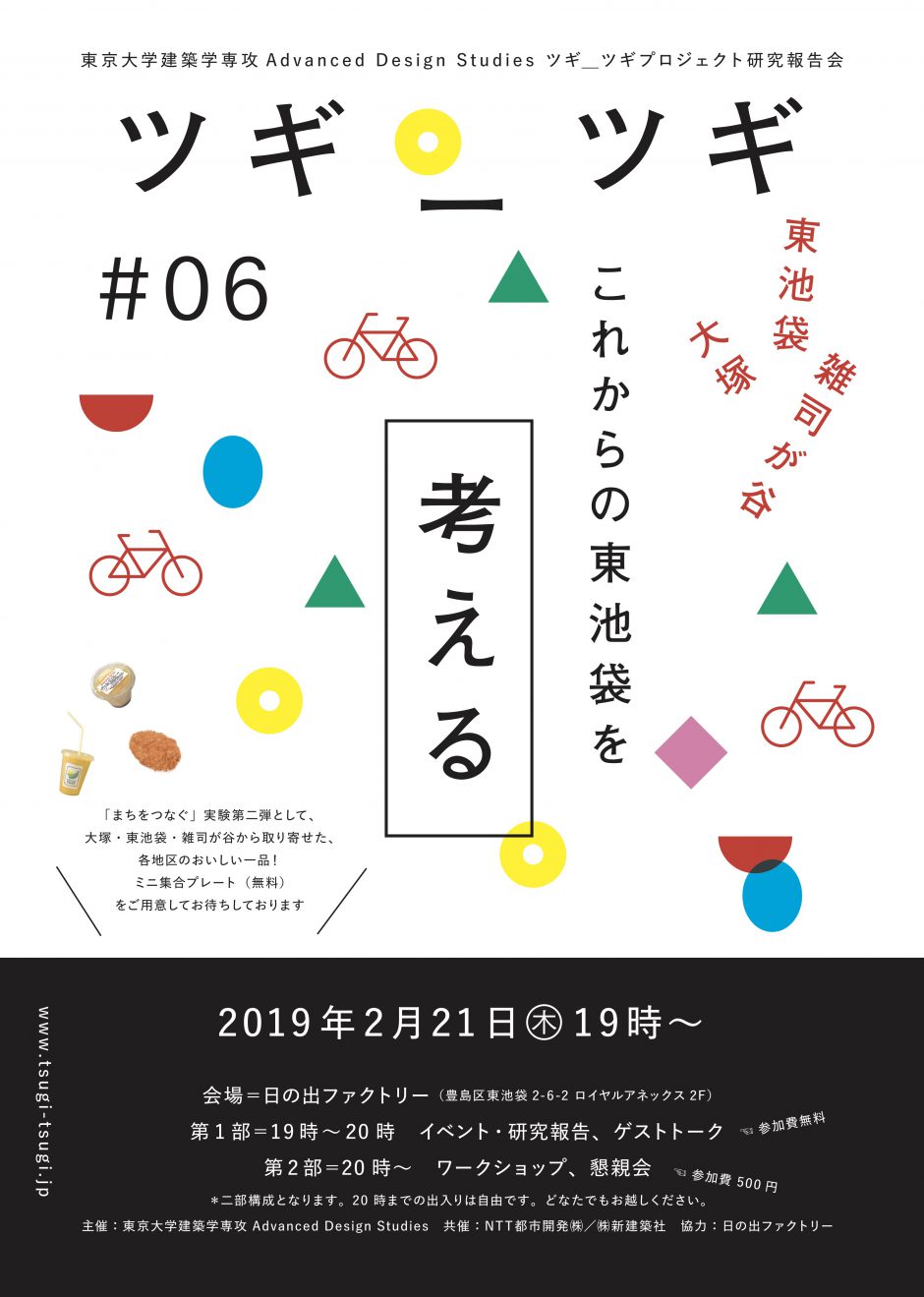
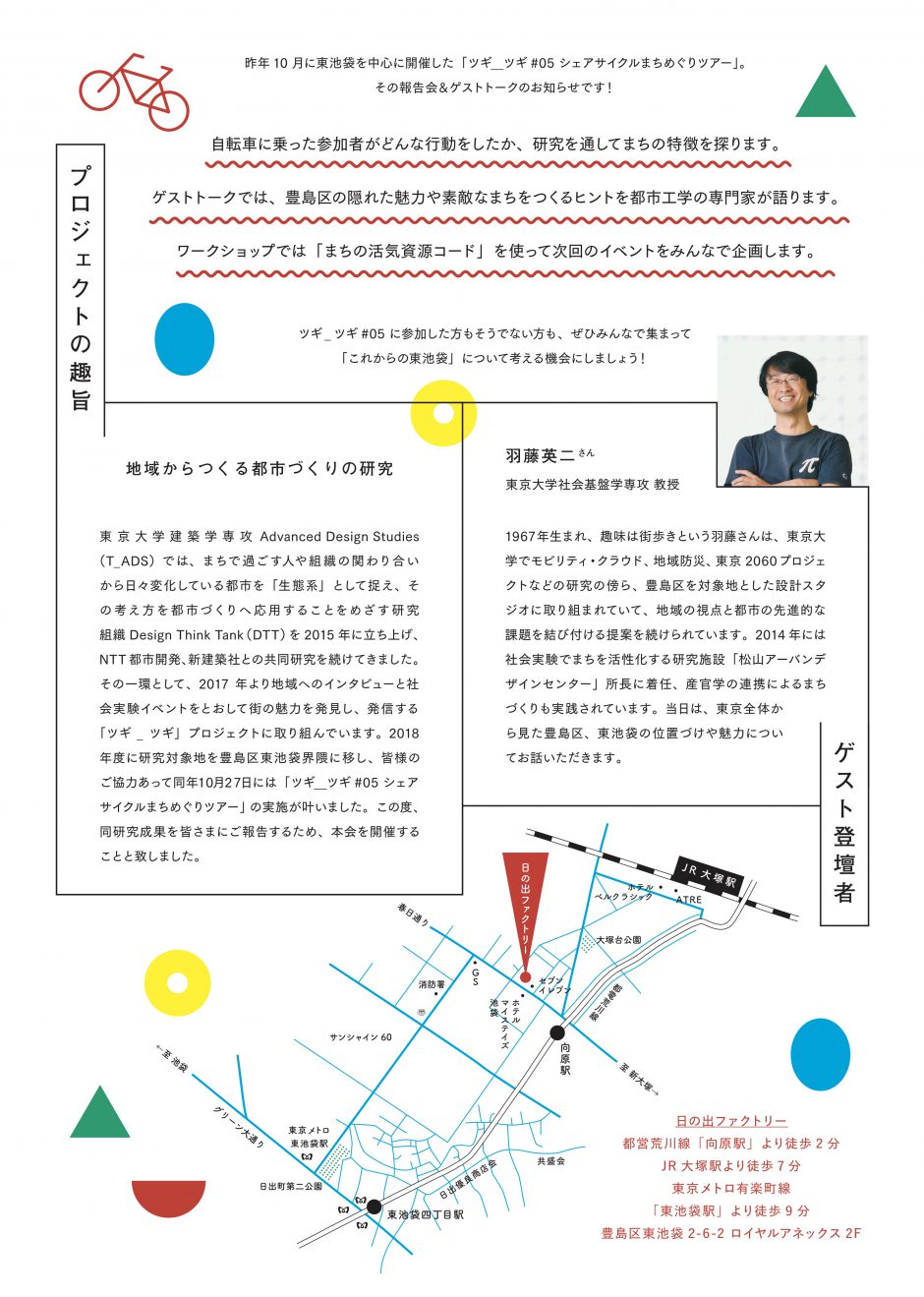
社会実験イベントのご案内
東京大学建築学専攻Advanced Design Studies(T–ADS)では、文化・経済が複雑に交差する都市を「生態系」として捉え、デザインへ応用することを目指す研究組織Design Think Tank(DTT)を立ち上げ、NTT都市開発、新建築社との共同研究を2015年4月にスタートしました。
DTTでは、その一環として2017年2月より社会実験イベントをとおして街の魅力を発見し、発信する「ツギ_ツギ」プロジェクトに取り組んできました。そしてこの度、第五回「ツギ_ツギ#05 シェアサイクルまちめぐりツアー 「まちの“ステキ”を しる めでる そだてる」を開催いたします。
第五回は前回同様シェアサイクルを使ったまちめぐりイベントで、舞台を豊島区の[東池袋・雑司が谷・大塚]に移しました。まちの達人たち30人に行ったインタビューをもとにまちの魅力ポイントをマッピングしたナビアプリを使いながら、普段何気なく過ごしている地元や、あまり足を伸ばしたことがなかった隣接地区の魅力を知り、愛で、育てていくイベントです。
街巡りに参加していただき、回遊のパターンや潜在的な魅力スポットを分析させていただきます。
また豊島区の協力のもと、事業用地ではこどものためのプレイパークとコーヒーの屋台も開催。同日にはHINODE AUTUMN MARKETも開催されます。
魅力的なまちを楽しみに、是非とも気軽にご参加下さい!
イベント詳細
日時: 2018年10月27日(土)11:00 – 17:00
○無料コミュニティ・サイクルによる「発見型」街巡りイベント
自転車貸出場所:・日出町第二公園(東池袋4-4)
・雑司が谷みみずく公園(雑司が谷3-15-20)
・大塚台公園(南大塚3-27-1)
同受付までお越しいただき、① 利用申込書へのお名前・住所・携帯電話番号等のご記入 ② 本人確認書類のご提示 ③ 利用規約へのご同意による受付手続きを済ませていただいた方に、最大1日2時間30分まで、無料でレンタル自転車をお貸し致します。
なお、イベント会場には本レンタル自転車以外の駐輪スペースは一切ございません。自転車でお越しの際は周辺の公共駐輪場をご利用下さい。
○[ヒミツきちをつくろう]×コーヒー屋台[CAFE SELECT]
場所:東池袋5-24 (豊島区事業用地)
※ 先に地域の方に配布させていただきました紙媒体チラシ内の事業用地の住所が間違っておりました。お詫び致しますと共に、訂正致します。
×[東池袋5-14-18]→○[東池袋5-24]
主催:東京大学建築学専攻 Advanced Design Studies
まちめぐりイベント共催:NTT 都市開発(株)/(株)新建築社
後援:豊島区
≫ その他の詳細についてはhttp://tsugi-tsugi.jp/をご覧ください。
またこちらから、前回のツギ_ツギ#04イベント記録動画もご覧いただけます。
イベントの雰囲気を感じ取っていただければ幸いです。
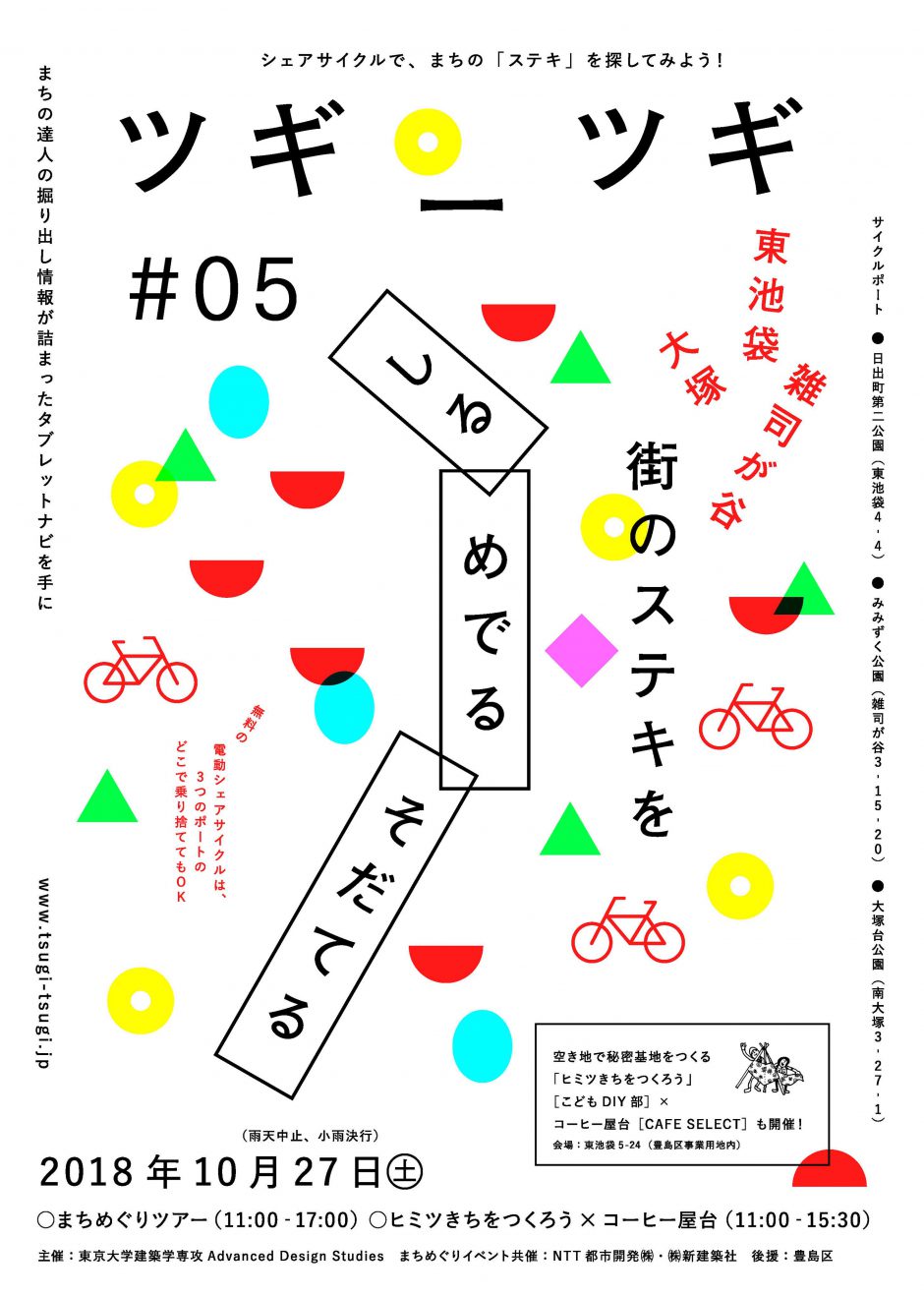
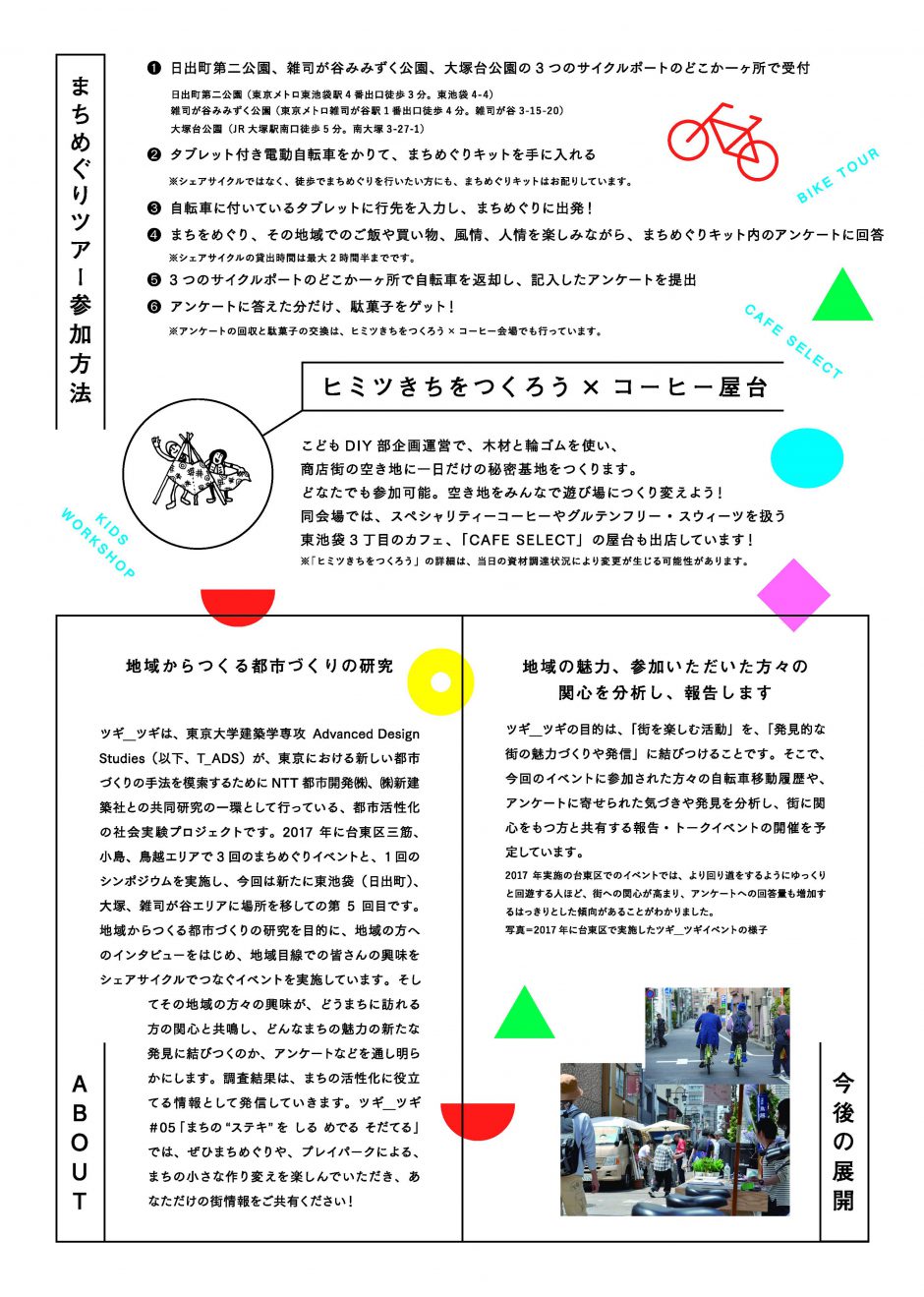
無料オンラインコース「現代日本建築の四相 第一相:理論」が、2018年 日本建築学会教育賞(教育貢献)を受賞しました。
日本建築学会URL : https://www.aij.or.jp/2018/2018prize.html
Free Online Course “FOUR FACETS OF CONTEMPORARY JAPANESE ARCHITECTURE : Theory “ won the Prize of AIJ (Architectural Institute of Japan) for Education Award for Outstanding Practice.
Architectural Institute of Japan URL : https://www.aij.or.jp/eng/prizes/prize/prize18.html
Free Online CourseFOUR FACETS OF CONTEMPORARY JAPANESE ARCHITECTURE — BETWEEN TWO OLYMPICSSecond Facet: Technology
Course Page on edX: Four Facets of Contemporary Japanese Architecture: Technology
This is the second course of architecture series. We will focus on works by architects who explored the use of technology—from techniques used for traditional crafts to computational processes—as a vehicle for their investigations into the conceptualization and production of architecture. Tadao Ando, Kazuhiko Namba, Shigeru Ban, Manabu Chiba, Kengo Kuma, and Yusuke Obuchi will visit their buildings to discuss the ideas behind their respective works.
Course Contents1. Architecture Lives Inside People – Tadao Ando, Atelier in Oyodo II (1991)2. Advancing Systemic Spaces – Kazuhiko Namba, BOXHOUSE 112 (2006)3. What Do You Want, Wood? – Shigeru Ban, La Seine Musicale (2017)4. Why I Went to Countryside? – Kengo Kuma, Yusuhara Wooden Bridge Museum (2010)5. Design by Reinterpretation – Manabu Chiba, KOGAKUIN UNIVERSITY 125TH MEMORIAL EDUCATION CENTER (2012)6. In Praise of Errors – Yusuke Obuchi, DFL Pavilion (2015)7. Review – 2nd Facet: Technology
This course is the second in the series following “First Facet: Theory,” and is followed by “Third Facet: City” and “Fourth Facet: Humans.”
Free online courses from The University of Tokyo: https://www.edx.org/school/utokyox
Introduction Page on the T—ADS Website: https://t-ads.org/mooc
無料オンラインコース 現代日本建築の四相 — 二つのオリンピックの狭間で 第二相:技術
オンライン講座(MOOC)プラットフォーム edX より公開中Four Facets of Contemporary Japanese Architecture: Technology
現代日本建築の発展において、技術はどのような意味を持っていたのか? それは、今後どのように変わっていくのか? 6人の建築家と彼らの代表作で行われた対話から探ります。
出演建築家:安藤忠雄、難波和彦、坂茂、隈研吾、千葉学、小渕祐介
このコースは、現在公開中の 「第一相:理論」につづくシリーズ第二弾で、「第三相:都市」、「第四相:人間」に続きます。
edXの東京大学サイト:https://www.edx.org/school/utokyox
T—ADS内の紹介ページ:https://t-ads.org/mooc
Intro Videos
DFL Colloquium
Where does design start and end?
The role of architects in the age of advanced computation and AI
Thursday 22 March 2018, 17:00-19:30 (doors open at 16:30, admission free)
Lecture Theatre 15, Faculty of Engineering Building 1, The University of Tokyo Hongo Campus
Language – English
‘Which jobs will be replaced by AI and robots?’ This type of catchy headline has become increasingly common in most news outlets, effectively grabbing viewers’ and readers’ attention. While presented as either something to embrace or refuse, it is undoubtedly imminent. Should architects be concerned? Could architects’ creative design processes also be done by AI and robots? If AI and robots will perform creative design processes better, then what will humans do? In other words, what does it mean to say, designed and made by humans?
The aim of this colloquium is to discuss the state of design culture specifically from the point of view of ‘making physical stuff.’ Computational capabilities have already dramatically altered the way manufacturing industries operate and deliver products with high degrees of efficiency and productivity through automation, robotic fabrication and building information modelling. Today, these methods and tools have become integral parts of architectural production processes, being both taught and practiced. This event will explore, and discuss the potentials and concerns for today’s designers and makers by asking where do design processes start and end?
Session 1 Presentations 17:00-18:20
Yusuke Obuchi
Associate Professor, Department of Architecture, The University of Tokyo
Hannes Mayer
Senior Researcher, Director of Education, Gramazio Kohler Research, ETH Zurich
Lisa Iwamoto
Professor, Department of Architecture, University of California, Berkeley
Session 2 Panel Discussion 18:30-19:30
Moderator
Thomas Weaver
TU Delft
Curatorial Presentation by
Fumio Nanjo
Director, Mori Art Museum
Organised by
The University of Tokyo Advanced Design Studies (T_ADS)
The University of Tokyo Digital Fabrication Fab (DFL)
DFLトーク・セッション
Where does design start and end?
The role of architects in the age of advanced computation and AI
2018年3月22日(木)17:00-19:30 (開場16:30)
東京大学本郷キャンパス工学部1号館15号講義室 (定員100名先着順 入場無料)
*使用言語:英語
デジタル機械・IT技術の発展に伴い、ものづくりにおける生産が設計プロセスと結びついて、従来のものづくりにあった人間との関係が希薄になりつつあります。建築においても、設計と施工が一体化することで、施工は「つくるもの(創造)」から「解釈のない/できない組み立てる仕事」に変わりつつあります。
他方、リノベーションのような、既存のデザインに手を加える設計や、解体後の廃材の活用に係るデザインなど、これまでの「設計=かたち/空間のデザイン」だけではない時代になり、設計、ひいては建築家の役割の再定義が求められています。
このトーク・セッションが着目するのは、人間と設計・施工プロセスとの関係が変わりつつある時代における「デザインのはじまりとおわり」です。
Session 1では、それぞれ異なるかたちでデジタル機械・IT技術の応用を試みる建築家や研究者の方々よりお話を伺います。Session 2のパネル・ディスカッションでは、著述家かつ歴史家であるデルフト工科大学のThomas Weaver氏、森美術館館長の南條史生氏にコーディネート頂きながら、デジタル・AI時代における設計と建築家の役割について議論します。
Session 1 Presentations 17:00-18:20
小渕 祐介 東京大学大学院工学系研究科建築学専攻 准教授
Hannes Mayer スイス連邦工科大学チューリッヒ校Gramazio Kohler Research 上席研究員 教育長
Lisa Iwamoto カリフォルニア州立大学バークレー校建築学科 教授
Session 2 Panel Discussion 18:30-19:30
Moderator
Thomas Weaver デルフト工科大学
Curatorial Presentation by
南條 史生 森美術館 館長
主催
東京大学建築学専攻Advanced Design Studies (T_ADS)
東京大学建築学専攻Digital Fabrication Fab (DFL)
Can the integration of digital technologies in design and construction processes be used for expressing personal tendencies through the creation of new architectural practices as well as novel aesthetics?
The University of Tokyo Digital Fabrication Lab (DFL) has annually been involved in an experimental pavilion installation, aiming at the application of digital technologies to architectural construction. Its projects are the embodiments of human-machine interaction, demonstrating its unique fabrication systems that make a worker behave as part of a 3D printer; translating human movement into formwork.
At the DFL, we believe that the role played by digital technologies in design and construction does not necessarily have to make them more efficient and streamlined. Their potential is instead focused on personalising the fabrication process. In our view, the act of making as such becomes a design in itself by means of computer assistance. The diversity that humans collectively show is organically expressed in the architecture.
PAFF is an architecture made by reference to sound rather than visual information. We developed a sound guidance system whereby a worker’s task is to recognise a sound source in a three-dimensional space, and shoot fibres into various targets. PAFF is expressed through the accumulation of the multi-agent system, revealing personal differences in the way that people perceive space through sound.
Project Credits:
UNIVERSITY OF TOKYO ADVANCED DESIGN STUDIES PROFESSORS
Yusuke Obuchi
Jun Sato
UNIVERSITY OF TOKYO PROJECT MANAGEMENT
Shohei Furuichi
Shuntaro Nozawa
Shuta Takagi
Deborah Lopez Lobato
Hadin Charbel
PROJECT COLLABORATOR
TAISEI CORPORATION
SPONSOR
TAISEI CORPORATION
SECOND YEAR STUDENT TEAM
Mika Kaibara Portugaise
Ziyi Wu
Nathalia Barros Abate Rotelli
Ruta Stankeviciute
Xiaoke Chen
Ao Yang
FIRST YEAR STUDENT TEAM
Ruoyu Chen
Wanting Liu
Yuqing Shi
Anran Wang
Yuxi Zhu
Sher Lin Tan
Otto Lindstam
Sofia Iino Cotado
Dominika Demlova
Priya Murugeswaran
ADDITIONAL SUPPORT
Machiko Asahara
Kyosuke Kawamura
Kota Isobe
PHOTOGRAPHS
Otto Lindstam
Yuqing Shi
DFL Research Pavilion 2017
PAFF (Projectile Acoustic Fibre Forest)
パビリオン展示
2017/11/28 – 2017/12/10, 10:00-17:00
In Front of Faculty of Engineering Building 1, Hongo Campus
東京大学本郷キャンパス工学部1号館前広場
パネル・模型展示
2017/11/28 – 2017/12/09, 7:00-18:00 (Weekdays and Saturday)
T lounge, Faculty of Engineering Building 11
東京大学本郷キャンパス工学部11号館1階T lounge
*12/02はシンポジウム開催に合わせ、15:00から16:00までの間、プロジェクト関係者がパビリオン及びエキシビション会場に常駐しております。どうぞお気軽にお声がけ下さい。
シンポジウム
Human Centric Digital Fabrication 人間主体のデジタル・ファブリケーション
2017/12/02, 16:00-19:00 (開場15:30)
東京大学工学部1号館15号講義室 (定員100名先着順 入場無料)
デジタル技術が可能にするデザインと施工プロセスの一体化は、つくることを通じた個の表現を促し、建築を変えることができるか?
東京大学建築学専攻Digital Fabrication Lab(DFL)では、建築施工におけるデジタル技術の活用をテーマに、毎年実験的なパビリオンを制作しています。これまで、人間がコンピュータのナビゲーションに従って施工する人機一体3Dプリンターや人間の動きそのものを型枠に見立てたファブリケーション・システムを建築スケールで再現してきました。
DFLがデジタル技術に求めているのは、デザインや施工を効率的にする役割のみに限りません。DFLが着目しているのは、デジタル技術の媒介によってつくるという行為自体がデザイン・プロセスとなり、人間が総体として持つばらつきが建築として有機的に表現される可能性です。
本年プロジェクトPAFFは、目ではなく耳を頼りにしてつくる建築です。作業者が音のガイドを聞きながら空間的広がりや奥行きを感知し、ターゲットに繊維素材を吹き飛ばす施工システムに挑戦します。音の世界を三次元的に認識しようとする過程で表出する個人差に着目し、それが重なり合ってできる建築を目指します。
シンポジウムでは、人間の個性や多様性、人間がつくることの不確実性を楽しむプロセスとしての施工について考えます。本年プロジェクトの共同実施企業である大成建設のプロジェクト・メンバーや建築とは異なる分野でご活躍される方々をお招きし、人間がつくることとデジタル技術の関係について議論します。
第1部(16:00-)
小渕 祐介 東京大学大学院工学系研究科建築学専攻 准教授
中野 優 大成建設株式会社建築本部 技術部長
佐藤 淳 佐藤淳構造設計事務所 主宰
東京大学大学院新領域創成科学研究科社会文化環境学専攻 准教授
第2部(17:30-)
権藤 智之 東京大学建築生産マネジメント寄付講座 特任准教授
稲見 昌彦 東京大学先端科学技術研究センター 教授
JST ERATO 稲見自在化身体プロジェクト 研究総括
新木 仁士 ARスポーツ「HADO」開発者、株式会社meleap CAO
総括
隈 研吾 建築家、東京大学大学院工学系研究科建築学専攻 教授
主催
東京大学建築学専攻Advanced Design Studies (T_ADS)
企画
東京大学建築学専攻Digital Fabrication Lab (DFL)・小渕祐介研究室
共同実施
大成建設株式会社
東京大学大学院新領域創成科学研究科社会文化環境学専攻佐藤淳研究室
(順不同)
建築の理論について考える書籍シリーズ T_ADS TEXTS の第2号、『T_ADS TEXTS 02 もがく建築家、理論を考える』が、6月30日に東京大学出版会より出版されます。
今号は、隈研吾と小渕祐介が講師をつとめる国際オンライン講義「現代日本建築の四相 第一相:理論」Four Facets of Contemporary Japanese Architecture: Theory をまとめたもので、現代日本建築を「理論」から理解する格好の入門書になっています。
図版をふんだんに使い、オンライン講座を見た方も見ていない方も楽しめる内容になっています。ぜひお手にとってご覧ください!
社会実験イベントのご案内
東京大学建築学専攻Advanced Design Studies(T–ADS)では、文化・経済が複雑に交差する都市を「生態系」として捉え、デザインへ応用することを目指す研究組織Design Think Tank(DTT)を立ち上げ、NTT都市開発、新建築社との共同研究を2015年4月にスタートしました。
DTTでは、その一環として台東区の三筋・小島・鳥越(三小鳥〔ミコドリ〕)で、2017年2月より社会実験イベントをとおして街の魅力を発見し、発信する「ツギ_ツギ」プロジェクトに取り組んできましたが、その第三回「ツギ_ツギ#03 曲がる?三小鳥」を開催いたします。
第三回は、街巡りの本質は、どの角を曲がるかの連続にあるという仮説の下、「より街巡りを楽しく発見的にする角の曲がり方があるのだとすれば、それはどんなものか?」を紐解こうというものです。
回遊促進を意図してつくられたプロジェクト特製ナビ付きと、ナビ無しの一般無料レンタル自転車の2種類を用意、ご協力いただける方にどちらかの自転車で「なるべくたくさん街角を曲がる」目的で街巡りに参加していただき、回遊パターンにどんな違いが生まれたかを分析させていただきます。
同日には地域でも有名なものづくり文化を楽しめるイベント「モノマチ」が同時開催しているようです。ツギ_ツギを使ってモノマチを巡っていただくこともできます。
それでなくとも魅力的な街・三小鳥を楽しみに、是非とも気軽にご参加下さい!
イベント詳細
日時: 2017年5月27日(土)・28日(日)11:00 – 18:30
無料コミュニティ・サイクルによる「発見型」街巡りイベント
自転車貸出場所:台東区鳥越1丁目14番:郡司味噌漬物店横
同受付までお越しいただき、① 利用申込書へのお名前・住所・携帯電話番号等のご記入 ② 本人確認書類のご提示 ③ 利用規約へのご同意による受付手続きを済ませていただいた方に、最大1日2時間30分まで、無料でレンタル自転車をお貸し致します。
なお、イベント会場には本レンタル自転車以外の駐輪スペースは一切ございません。自転車でお越しの際は周辺の公共駐輪場をご利用下さい。
主催:鳥越本通り商盛会
企画・共催:東京大学建築学専攻 Advanced Design Studies
共催:NTT 都市開発(株)/(株)新建築社
後援:台東区
≫ その他の詳細についてはhttp://tsugi-tsugi.jp/をご覧ください。
またこちらから、前回2月のツギ_ツギ#01イベント記録動画もご覧いただけます。
三小鳥の街の雰囲気を感じ取っていただければ幸いです。
ツギ_ツギ#01 白米モノヅクリ自転車おかず from ツギ_ツギ on Vimeo.
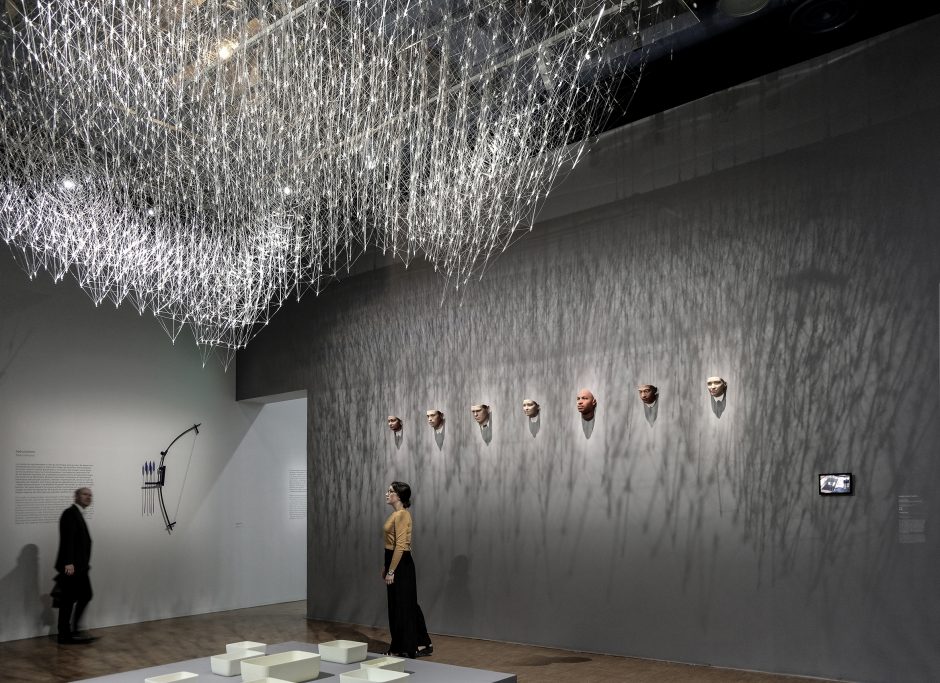
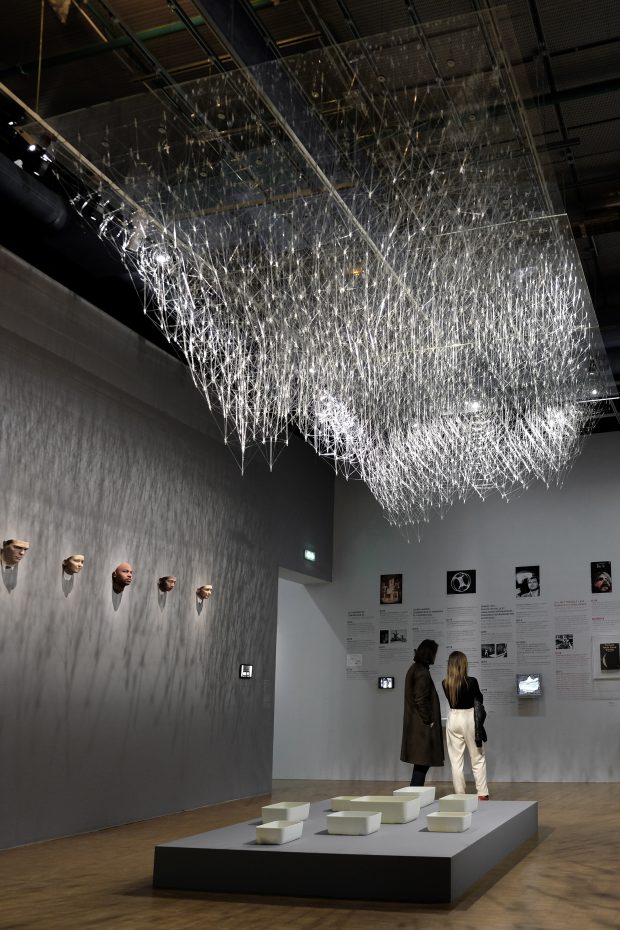
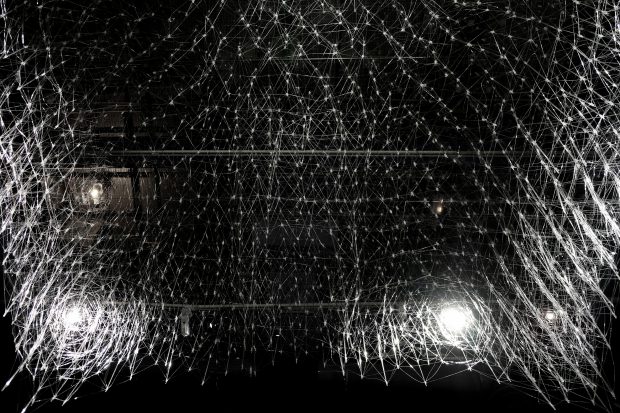

TーADS is proud to announce the work of alumni Kevin Clement and Anders Rod is being featured at the Centre Pompidou Museum in Paris, France. The exhibit, originally conceived as the Harvesting Plasticity graduate research project, is a hanging work featured as a part of the Mutations/Créations event. The event aims to bring together design, architecture, and music.
This work is included as a part of the Imprimer le Monde exhibition, a collection of works exploring the use of the digital for 3D creations.
Mutations / Créations
Imprimer le Monde, A Collective Exhibition
Centre Pompidou, Paris, France
15 March – 19 June, 2017
Galerie 4, level 1
(Mutations / Créations details via Centre Pompidou)
Project Credits
University of Tokyo Advanced Design Studies Unit (TーADS)
Professors: Yusuke Obuchi, Kengo Kuma, Manabu Chiba
Core research: Kevin Clement, Anders Rod
Project Coordinators: Kevin Clement, Shuntaro Nozawa
Project Team: Jiang Lai, Deborah Lopez, Hadin Charbel, Mika Portugaise, Chen Xiaoke, Ruta Stankeviciute, Hirokazu Tei, Wu Ziyi, Alric Lee, Nathalia Rotelli, Emi Shiraishi, Veronika Smetanina, Tom Moss, Yang Ao, Tyler Mcbeth
Jun Sato Lab
Professor: Jun Sato
Project Team: Mika Araki, Ying Xu
Video Production: Deborah Lopez, Hadin Charbel
Special thanks to: Kengo Kuma and Associates, The University of Tokyo Department of Architecture
École Spéciale d’Architecture
Gallery of Construction Images
Timelapse Video of Installation (courtesy Centre Pompidou)
2016年DFLパビリオンComputational Clayエキシビション
場所:鹿島建設技術研究所 1階展示スペース (アックセス)
開催:3月14日(火)〜24日(金)
09:00-17:00(平日のみ、最終日は午前中のみ)
※ 一般に開放されているスペースです。どなたにでもご覧頂けます。
COMPUTATIONAL CLAY 2017 PAVILION DISPLAY & PANEL EXHIBITIONのご案内(鹿島)
Computational Clay Exhibition – Pavilion and Panel Display
Tuesday March 14th – Friday March 24th
Entrance, Ground Floor, Kajima Technical Research Center (Chofu, Tokyo)
09:00-17:00, weekdays only
Entrance free of charge
Kajima Technical Research Institute Access Information
Lecture: Research or Architecture
Speaker: Thomas Weaver, Editor, AA School of Architecture
March 2, 2017 (Thursday)
17:00-19:00
This lecture offers a survey of architectural education through an examination of the momentous events of 1968. Its particular focus is the recent emergence of the concept of research, which in many ways defines the modern university over and above a dedication to any specific subject. The lecture will unpick the idea of research and in the process offer a polemic that counters its ubiquity against the more obvious attractions of architecture itself.
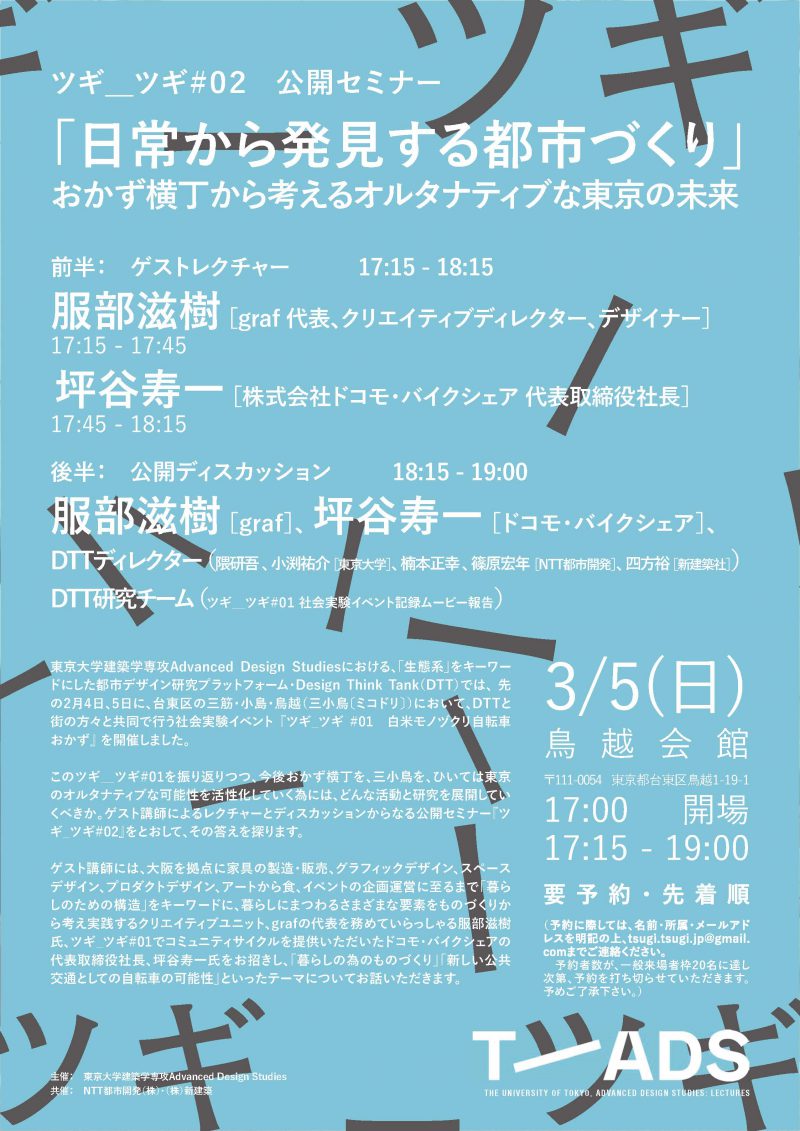 ツギ_ツギプロジェクト第2弾、公開セミナーのお知らせ
ツギ_ツギプロジェクト第2弾、公開セミナーのお知らせ
おかげさまで、Design Think Tank(DTT)では、先の2月4日、5日に共同研究の一環として台東区の三筋・小島・鳥越において、街の方々と共同で行う社会実験イベント 『ツギ_ツギ #01 白米モノヅクリ自転車おかず』 を無事執り行うことができました。
今般、イベントを振り返りつつ、今後のツギ_ツギプロジェクトの可能性を模索する場としてゲスト講師にgraf代表服部滋樹氏、(株)ドコモ・バイクシェア坪谷寿一氏の2名をお招きした公開セミナーを開催する運びとなりました。
住民、商店街、事業者、大学等、様々な立場のプレイヤーが集う、意見交換の場になればと考えております。ぜひ皆様にもお越しいただければ幸甚です。
尚、席に限りがございますので、要予約・先着順とさせていただいております。予約に関しては、名前・所属・メールアドレスを明記の上、tsugi.tsugi.jp@gmail.comまでご連絡ください。予約数が一般来場者20名に達し次第、予約を打ち切らせていただきます。予めご了承ください。
—— 公開セミナー概要 ——
日時:3月5日(日)17時開場 17:15-19:00
場所:鳥越会館(東京都台東区鳥越1-19-1)
「日常から発見する都市づくり」
おかず横丁から考えるオルタナティブな東京の未来
前半:ゲストレクチャー(17:15-18:15)
服部滋樹(graf代表、クリエイティブディレクター、デザイナー)
坪谷寿一(株式会社ドコモ・バイクシェア代表取締役社長)
後半:公開ディスカッション(18:15-19:00)
服部滋樹(graf)、坪谷寿一(ドコモ・バイクシェア)
隈研吾(東京大学)小渕祐介(東京大学)、楠本正幸(NTT都市開発)、篠原宏年(NTT都市開発)、四方裕(新建築)
主催:東京大学建築学専攻Advanced Design Studies
共催:NTT都市開発(株)、(株)新建築
社会実験イベントのご案内
東京大学建築学専攻Advanced Design Studies(T–ADS)では、文化・経済が複雑に交差する都市を「生態系」として捉え、デザインへ応用することを目指す研究組織Design Think Tank(DTT)を立ち上げ、NTT都市開発、新建築社との共同研究を2015年4月にスタートしました。
このたびDTTでは、その一環として台東区の三筋・小島・鳥越(三小鳥〔ミコドリ〕)において、街の方々と共同で行う社会実験イベント 『ツギ_ツギ #01 白米モノヅクリ自転車おかず』 を開催いたします。
三小鳥〔ミコドリ〕地域は、こだわりの「ものづくり」文化が息づく、知る人ぞ知るエリアで、今回ここで行う実験は、
1.レンタル・乗り捨てができる、無料コミュニティサイクル(自転車)に乗り、
2.おかず横丁で無料ごはん・けんちん汁(先着150名様)と、商店街のおかずをいただき、
3.ものづくり横丁で職人さんの技術も体験(有料)、
4.下町人情あふれる町をぶらぶら巡りながら、お気に入り風景を写真撮影、
5.撮った写真をプロジェクトサイトにアップして無料ホットドリンクをゲット(御徒町と蔵前でそれぞれ先着100名)、心も体も温まる
ことです。
冬の凛とした空気の中、町を巡る気持ちよさと楽しさを感じに、ぜひお越し下さい!皆さんの参加が、三小鳥に満ち溢れている隠れた魅力を、ツギツギと引き出していきます。
イベント詳細
日時: 2月4日(土)12:00-17:00
無料コミュニティサイクル
「ごはんとけんちん汁」プレゼント(先着150名)
ものづくり横丁ワークショップ(有料)
2月5日(日)12:00-17:00
無料コミュニティサイクルのみ
会場:
御徒町サイクルポート 2k540 AKI-OKA ARTISAN 東京都台東区上野五丁目9
鳥越サイクルポート 東京都台東区鳥越1丁目 おかず横丁内
蔵前サイクルポート 東京都台東区蔵前1丁目3-35 NTT 蔵前ビル
主催: 鳥越本通り商盛会
企画: 東京大学建築学専攻Advanced Design Studies
共催: 東京大学建築学専攻Advanced Design Studies NTT都市開発株式会社 株式会社新建築社 ものづくり横丁
後援: 台東区
≫ その他の詳細については http://tsugi-tsugi.jp/ をご覧ください。
Introduction
In the Advanced Design Studies Program (T—ADS) at the University of Tokyo’s Department of Architecture, cities are conceptualized as “ecosystems” where culture and economics intersect in a complex way. In April 2015, T—ADS established the Design Think Tank (DTT) research organization, a collaboration with NTT Urban Development Corporation and Shinkenchiku.
DTT’s current focus is on a region of Taito ward which encompasses Misuji, Kojima, and Torigoe neighborhoods (nicknamed “Mikodori”). In its first ever exploratory community event, pursued in collaboration with Mikodori residents, DTT is pleased to announce Tsugi Tsugi (One by One) #1: Cycling, Side Dishes, Rice, and Craft.
Concept
The Mikodori area is a place that lives and breathes craft culture; where specialists produce as-yet unfamiliar creations. It will be the hub for this exploration.
1. Ride community-use bicycles for free (regularly available for rent).
2. On Okazu Yokocho (Side Dish Street), free rice and kenchin (vegetable) soup will be given to the first 150 people to arrive. There will be additional side dishes to enjoy on local shopping streets.
3. On Craft Street, participate in a creative experience with a local craftsman (fee required).
4. Take pictures of interesting locations as you wander through the old town area.
5. The first 100 people to upload a photo to the project website will get a free hot drink (in front of Okachimachi and Kuramae stations)!
One by one, we aim to reveal the hidden charms of the Mikodori area. Join us for this fun exploration!
Event Details:
February 4 (Sat) 12:00-17:00
Free community cycle use
Rice + Kenchin soup (first 150 people)
Workshop in Monozukuri Yokocho (fee required)
February 5 (Sunday) 12:00-17:00
Free community cycle use only
Location:
Okachimachi Cycle Port: 2k540 AKI-OKA Artisan
Tokyo-to, Taito-ku, Ueno 5-9
Torigoe Cycle Port: Tokyo-to, Taito-ku, Torigoe 1 (inside Okazu Yokocho)
Kuramae Cycle Port: Tokyo-to, Taito-ku, Kuramae 1-3-35, NTT Kuramae Building
Sponsor: Torigoe Main Street Business Association
Planning: The University of Tokyo, Department of Architecture, Advanced Design studies
In Cooperation with: Advanced Design Studies (The University of Tokyo Department of Architecture), NTT Urban Development Incorporated, Shinkenchiku Incorporated, Monozukuri Yokocho
Supported by: Taito Ward
For other details (in Japanese), please refer to tsugi-tsugi.jp.
Lecture: Bending Rules: Protocols of Error
Speaker: Kristof Crolla, Architect, Assistant Professor (Chinese University of Hong Kong, School of Architecture)
February 1, 2017 (Wednesday)
14:00-16:00
Kristof Crolla is a Belgian architect who combines his architectural practice Laboratory for Explorative Architecture & Design Ltd. (LEAD) with an Assistant Professorship in Computational Design at the Chinese University of Hong Kong, School of Architecture (CUHK). He both trained and taught at the Architectural Association School of Architecture, London (AA), and worked for many years for Zaha Hadid Architects. In 2010 he moved to Hong Kong where his academic research and office work focusses on the strategic implementation of computation in architectural design. He is best known for projects such as ‘Golden Moon (Hong Kong, 2012)’ and ‘ZCB Bamboo Pavilion (Hong Kong, 2015)’, which internationally received over two dozen design awards and accolades, including the G-Mark (Japan), Architizer A+ (USA) Awards, and most recently the 2016 World Architectural Festival Award – Small Project of the Year 2016, nicknamed «The Architectural Oscars».
This lecture uses Kristof Crolla’s recently built work in China to illustrate how the deliberate introduction of project-specific material and construction idiosyncrasies, such as limited onsite skill, accuracy, budget and time, into the digital workflow can facilitate materialising unusual and ebullient architectural outcomes from minimal means.
Current evolutions in computational design are radically expanding the design solution space available to architects. In principle, these trends should permit the more straightforward implementation of non-standardised, geometrically complex architecture. Yet, since the digital entered the architectural scene, it has by-and-large encountered non-digital cultures not through authentic dialogue, but through subjugation. As a result, a disjunction has manifested between the opportunities the virtual offers and their real-world implementation. Especially in developing countries, this divide reveals itself in the difficulties the non-standard often faces in dealing with onsite restrictions and unpredictabilities, and is apparent in the discordance between available digital and onsite craft.
In search of an alternative contemporary mode of architecture practice, the work presented from LEAD and CUHK illustrates the surprisingly poetic outcomes possible in contexts notorious for their building quality.
Nikken Sekkei bldg.
Tokyo, Chiyoda, Iidabashi, 2-18-3
Tokyo in(di)visible hypothesizes to make current the perceptions of space as defined under opposing terms of interior/exterior and precise/uncontrollable. Through a networked field of architectural prototypes, an exterior space can be created and defined as a function of the evolving environmental conditions in which it is situated, removing undesirable airborne particles as a by-product of the enhancement of exterior qualities.
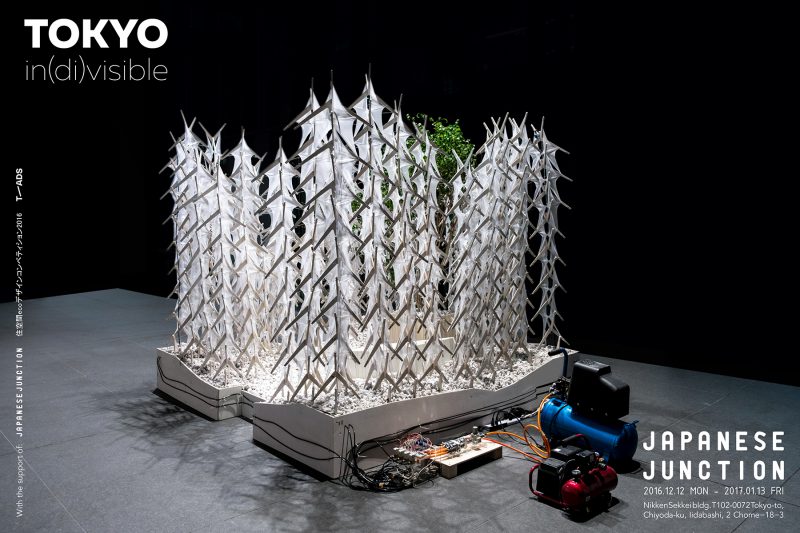
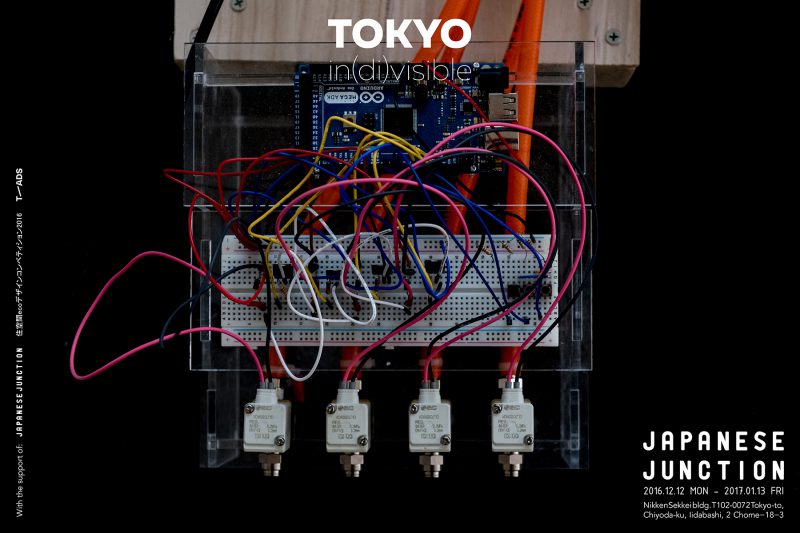
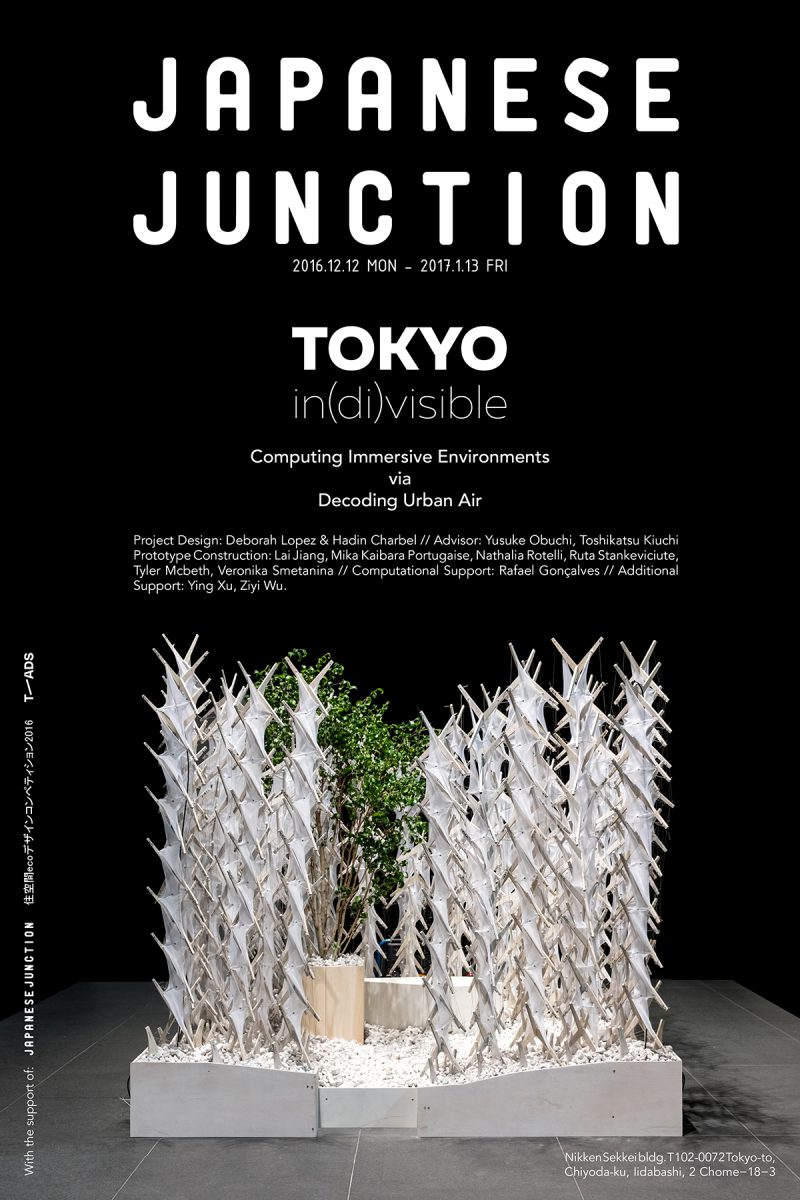

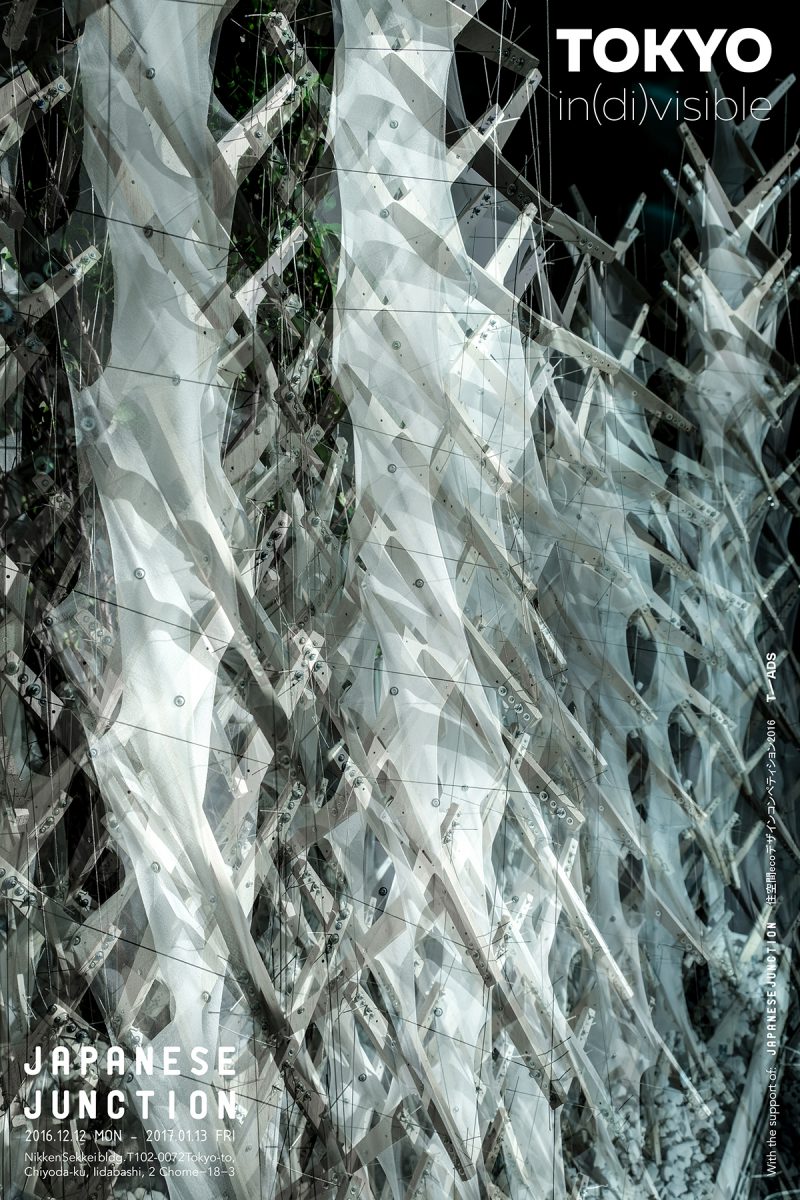
東京大学建築学専攻Digital Fabrication Lab(DFL)では、建築施工におけるデジタル技術の活用をテーマに、毎年実験的なパビリオンを制作しています。単に技術による自動化や高度化を目指すのではなく、そこに「人間が関わること」の可能性を探る実証の場として、これまで「人間と機械が融合した3Dプリンター」(2014年STIKパビリオン)や「巨大3Dペン」(2015年TOCAパビリオン)を建築スケールで再現してきました。
本年Computational Clayプロジェクトでは「人間が関わること」をより一層推し進め、個性としての身体パフォーマンスを建築表現に反映させるため、人の動きと素材と関係に着目したユニークなパネル加工システムを開発しました。
Every year in the University of Tokyo’s Digital Fabrication Lab (DFL), digital fabrication technologies are used to produce an experimental pavilion project. The aim, rather than being simply to achieve automation or precision through use of such technologies, is to explore the potentials for human and machine collaboration. Past projects have focused on fusions between humans and machines through the use of 3D printers: the 2014 STIK Pavilion explored this theme through guided aggregation, and the 2015 TOCA Pavilion by using humans as a parameter along with an oversized 3D pen.
This year, in the Computational Clay Pavilion, we advance the role of the human in construction one step further, examining how an individual’s capabilities and performance can be expressed in an architectural output. We have developed a unique panelized construction system wherein the movements of humans and their relationship to the material are explored.
Project Credits:
主催: 東京大学建築学専攻 Advanced Design Studies(T—ADS)
PRODUCED BY: Advanced Design Studies, Department of Architecture, The University of Tokyo
企画: 東京大学建築学専攻 Digital Fabrication Lab(DFL)
鹿島建設株式会社
東京大学大学院情報理工学系研究科コンピュータ科学専攻 五十嵐健夫研究室
東京大学大学院新領域創成科学研究科社会文化環境学専攻 佐藤淳研究室
素材協力: 株式会社エコグリーン、株式会社東邦アーステック(順不同)
PLANNING:
Digital Fabrication Lab (DFL), Department of Architecture, The University of Tokyo
IN COLLABORATION WITH:
Kajima Corporation
Graduate School of Information Science and Technology, Department of Computer Science, Takeo Igarashi Laboratory
Graduate School of Frontier Sciences, Department Socio-cultural Environmental Studies, Jun Sato Laboratory
MATERIALS PROVIDED BY:
Eco Green, Toho EarthTech (in random order)
UNIVERSITY OF TOKYO DIRECTING PROFESSORS
Yusuke Obuchi (Associate Professor), Department of Architecture
Jun Sato (Professor), Department of Frontier Sciences
Takeo Igarashi (Professor), Department of Computer Science
UNIVERSITY OF TOKYO PROJECT MANAGEMENT
Kensuke Hotta
Shohei Furuichi
Kosuke Nagata
Shuta Takagi
Shuntaro Nozawa
Iris Zhang
Déborah Lopez Lobato
Hadin Charbel
Haoran Xie
SECOND YEAR STUDENT TEAM
Alric Lee
Isaac Yoo
Ittidej Lirapirom
Luca Marulli
Moritz Münzenmaier
Pan Kalin
Victor Hugo Wido
FIRST YEAR STUDENT TEAM
Hirokazu Nakano Tei
Mika Kaibara Portugaise
Nathália Barros Abate Rotelli
Rūta Stankevičiūte
Tom Moss
Tyler Timothy McBeth
Veronika Smetanina
Xiaoke Chen
Yang Ao
Ziyi Wu
ADDITIONAL SUPPORT
Emi Shiraishi
Federico Cazzaniga
PHOTOGRAPHS
Toshihiko Kiuchi (Assistant Professor, University of Tokyo)
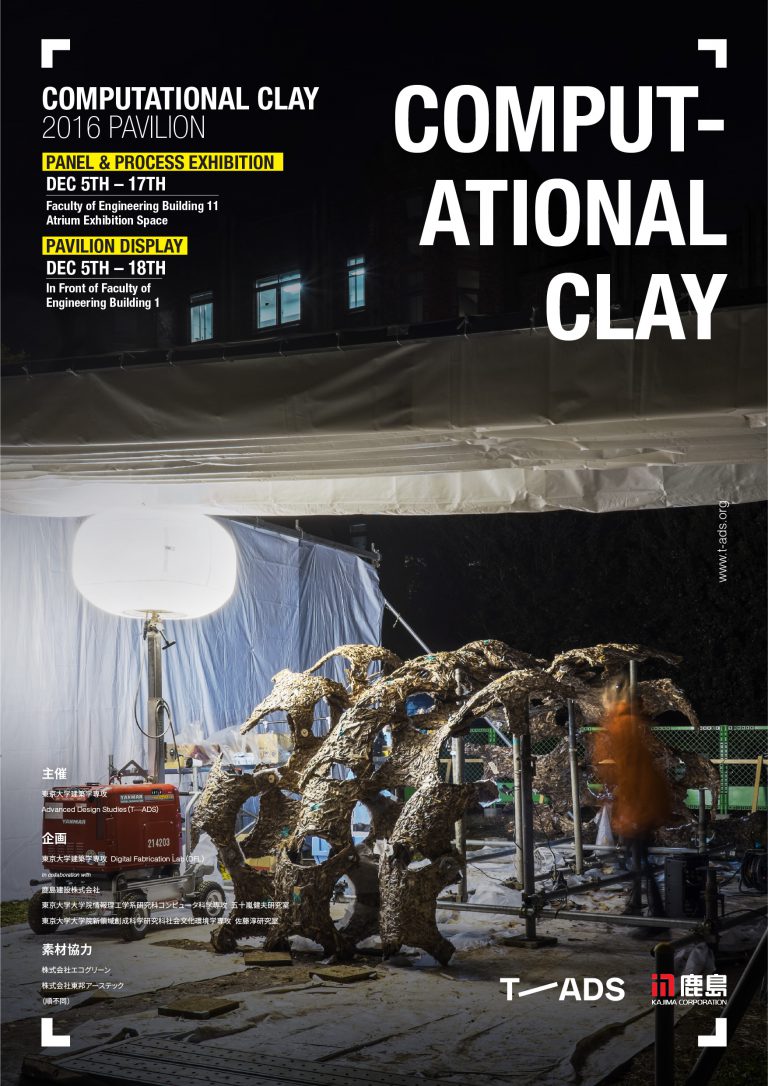
パビリオン公開 // PAVILION DISPLAY
12月5日(月)– 12月18日(日)// December 5 (Mon) – December 18 (Sun)
10:00 – 17:00
東京大学本郷キャンパス工学部1号館前広場
The University of Tokyo, Hongo Campus, Engineering Building #1 Plaza
パネル・模型展示 // PANEL AND PROCESS EXHIBITION
12月5日(月)– 12月17日(土)// December 5 (Mon) – December 17 (Sat)
平日と土曜日のみ // Weekdays and Saturdays only
07:00 – 18:00
(12月5日は13:00から) // (Open at 13:00 on December 5)
東京大学本郷キャンパス工学部 11 号館1階展示スペース(入場無料)
The University of Tokyo Hongo Campus, Engineering Building #11, 1F Exhibition Space (free entry)
主催: 東京大学建築学専攻 Advanced Design Studies(T—ADS)
PRODUCED BY: Advanced Design Studies, Department of Architecture, The University of Tokyo
企画: 東京大学建築学専攻 Digital Fabrication Lab(DFL)
鹿島建設株式会社
東京大学大学院情報理工学系研究科コンピュータ科学専攻 五十嵐健夫研究室
東京大学大学院新領域創成科学研究科社会文化環境学専攻 佐藤淳研究室
素材協力: 株式会社エコグリーン、株式会社東邦アーステック(順不同)
PLANNING:
Digital Fabrication Lab (DFL), Department of Architecture, The University of Tokyo
IN COLLABORATION WITH:
Kajima Corporation
Graduate School of Information Science and Technology, Department of Computer Science, Takeo Igarashi Laboratory
Graduate School of Frontier Sciences, Department Socio-cultural Environmental Studies, Jun Sato Laboratory
MATERIALS PROVIDED BY:
Eco Green, Toho EarthTech (in random order)
東京大学建築学専攻Digital Fabrication Lab(DFL)では、建築施工におけるデジタル技術の活用をテーマに、毎年実験的なパビリオンを制作しています。単に技術による自動化や高度化を目指すのではなく、そこに「人間が関わること」の可能性を探る実証の場として、これまで「人間と機械が融合した3Dプリンター」(2014年STIKパビリオン)や「巨大3Dペン」(2015年TOCAパビリオン)を建築スケールで再現してきました。
本年Computational Clayプロジェクトでは「人間が関わること」をより一層推し進め、個性としての身体パフォーマンスを建築表現に反映させるため、人の動きと素材と関係に着目したユニークなパネル加工システムを開発しました。
Every year in the University of Tokyo’s Digital Fabrication Lab (DFL), digital fabrication technologies are used to produce an experimental pavilion project. The aim, rather than being simply to achieve automation or precision through use of such technologies, is to explore the potentials for human and machine collaboration. Past projects have focused on fusions between humans and machines through the use of 3D printers: the 2014 STIK Pavilion explored this theme through guided aggregation, and the 2015 TOCA Pavilion by using humans as a parameter along with an oversized 3D pen.
This year, in the Computational Clay Pavilion, we advance the role of the human in construction one step further, examining how an individual’s capabilities and performance can be expressed in an architectural output. We have developed a unique panelized construction system wherein the movements of humans and their relationship to the material are explored.
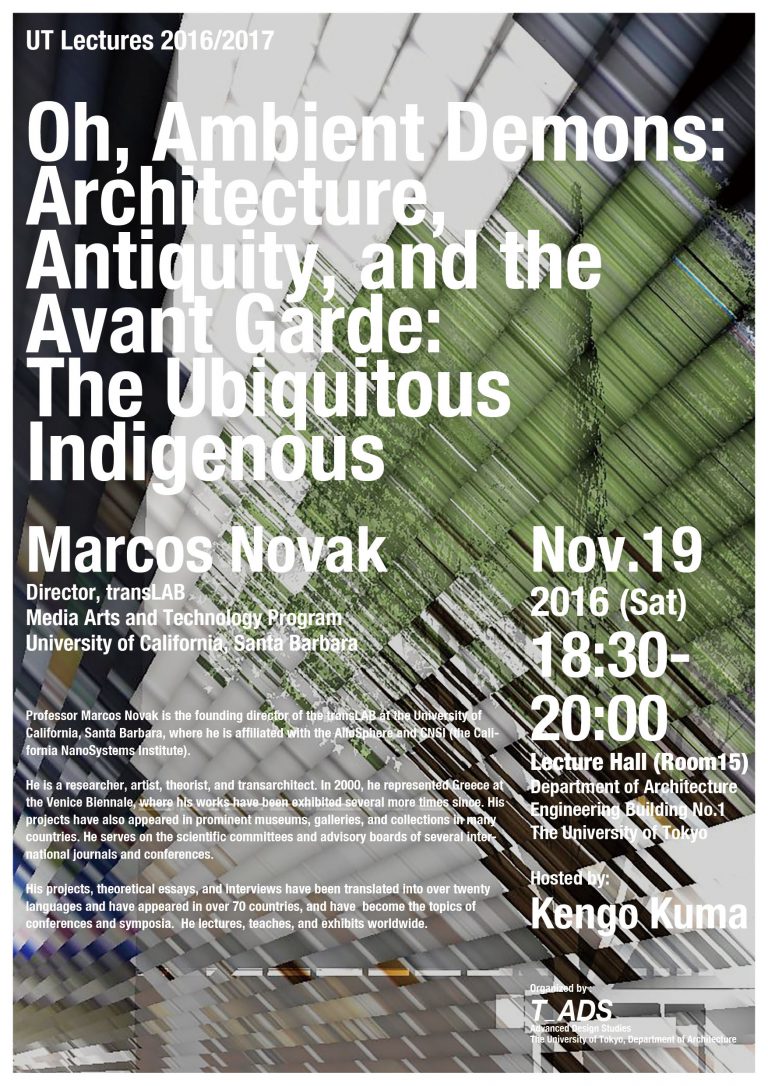
Lecture: Oh, Ambient Demons: Architecture, Antiquity, and the Avant Garde: The Ubiquitous Indigenous
Speaker: Marcos Novak, Director, TransLAB, Media Arts and Technology Program, University of California, Santa Barbara
November 19, 2016 (Saturday)
18:30-20:00
Professor Marcos Novak is the founding director of the transLAB at the University of California, Santa Barbara, where he is affiliated with the AlloSphere and CNSI (the California NanoSystems Institute).
He is a researcher, artist, theorist, and transarchitect. In 2000, he represented Greece at the Venice Biennale, where his works have been exhibited several more times since. His projects have also appeared in prominent museums, galleries, and collections in many countries. He serves on the scientific committees and advisory boards of several international journals and conferences.
His projects, theoretical essays, and interviews have been translated into over twenty languages, have appeared in over 70 countries, and have, and have become the topics of conferences and symposia. He lectures, teachers, and exhibits worldwide.
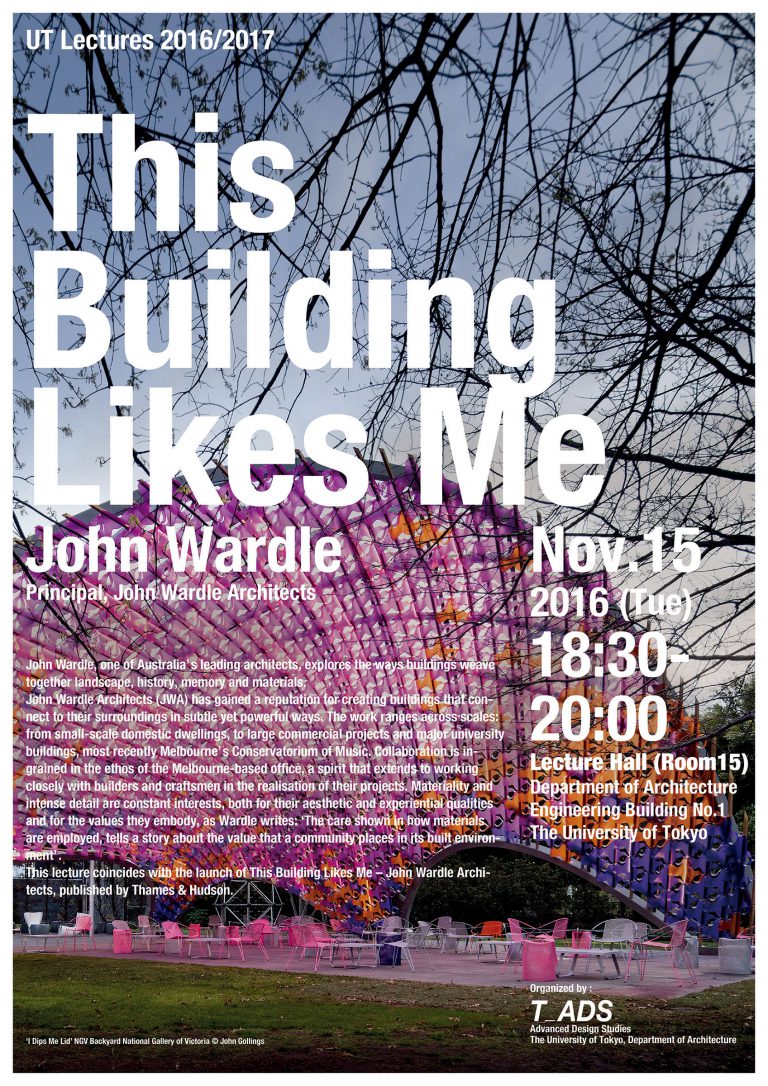
Lecture: This Building Likes Me
Speaker: John Wardle
November 15, 2016 (Tuesday)
18:30-20:00
John Wardle, one of Australia’s leading architects, explores the ways buildings weave together landscape, history, memory, and materials.
John Wardle Architects (JWA) has gained a reputation for creating buildings that connect to their surroundings in subtle yet powerful ways. The work ranges across scales: from small-scale domestic dwellings, to large commercial projects and major university buildings, most recently, Melbourne’s Conservatorium of Music. Collaboration is ingrained in the those of the Melbourne-based office, a spirit that extends to working closely with builders and craftsmen in the realization of their projects. Materiality and intense detail are constant interests, both for their aesthetic and experiential qualities and for the values they embody, as Wardle writes: “The care shown in how materials are employed, tells a story about the value that a community places in its built environment.”
This lecture coincides with the launch of This Building Likes Me – John Wardle Architects, published by Thames Hudson
Princeton University School of Architecture hosted a joint workshop in New York with visitors from the University of Tokyo between October 28 and November 6. The workshop is part of a strategic partnership program between Princeton and UTokyo, and was initiated by Princeton Professor Jesse Reiser and University of Tokyo Associate Professor Yusuke Obuchi. The aim of the workshop is to create opportunities to exchange architectural knowledge between cultures and universities.
The first workshop in this initiative was held in 2016 in Tokyo. Participants had the chance to meet and engage in discussions with master Japanese architects such as Fumihiko Maki, Arata Isozaki, and Hiroshi Hara. The October workshop represented the US-hosted portion of the partnership, and the content focused on Steven Holl, Bernard Tschumi, and Thom Mayne. Five students from the University of Tokyo participated (two PhD, one master, and two undergraduate). Each student received seminal essays written by each focus architect, and then had an opportunity to discuss them in a preparatory seminar before visiting the architects’ offices and conducting interviews. Students also visited buildings in New York and Princeton designed by the architects.
Admission for the 2017/2018 academic year is now open. Applicants must complete both online and postal submission of documents.
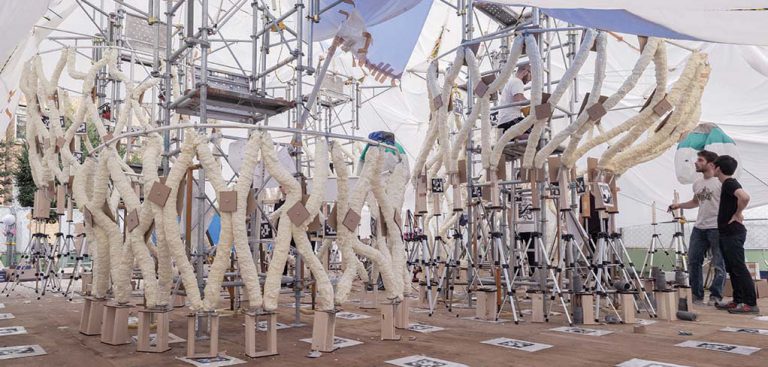
Admissions Information
Application Guide
Begin Your Application
| ONLINE APPLICATION |
Initial online registration period (Create your T-cens account during this period ) |
Between September 14th, 2016 and November 25th, 2016 |
| Deadline for data entry and document upload | November 25th, 2016 | |
| POSTAL SUBMISSION |
All documents must be postmarked | On or before November 30th, 2016 |
| All documents must reach the Global 30 Office | No later than December 5th, 2016 | |
| Final Result Notification | March, 2017 | |
For further information about the course and the University of Tokyo:
Free Online Course
FOUR FACETS OF CONTEMPORARY JAPANESE ARCHITECTURE — BETWEEN TWO OLYMPICS
First Facet: Theory
無料オンラインコース
現代日本建築の四相 — 二つのオリンピックの狭間で
第一相:理論
T_ADSの隈研吾教授と小渕祐介准教授が講師をつとめる無料オンラインコース「現代日本建築の四相 — 二つのオリンピックの狭間で」の第一相「理論」が、 2016年7月31日より順次公開されます。
Four Facets of Contemporary Japanese Architecture: Theory
本コースでは、「理論」「技術」「都市」「人間」の四相から戦後の日本建築の多様性を見直すことによって、現代につながる持続的な問題意識として建築を考えます。多様性を生み出した日本を代表する建築家自身による作品解説とインタビューを通じて、現代日本建築を再解釈するとともに、これからの建築が向かうべき方向性を探ります。
第一相「理論」配信予定と出演建築家
7月31日 イントロダクション(代々木国立競技場)
8月07日 磯崎新 香山壽夫
8月14日 藤森照信 大野秀敏
8月21日 隈研吾 妹島和世
8月28日 まとめ
本コースは、2012年にハーバード大学とMITにより設立されたMOOC(Massive Open Online Course)プロバイダーであるedX(エデックス)から提供され、無料登録により世界中の誰でも視聴することができます(希望により有料の修了証も取得できます)。なお本コースは、日本語音声+英語字幕で配信されます。
Course Page on edX: Four Facets of Contemporary Japanese Architecture: Theory
Course instructors Kengo Kuma and Yusuke Obuchi have invited other leading Japanese architects to participate. Materials are delivered in Japanese with English subtitles.
Framed between the two Tokyo Olympics of 1964 and 2020, this series will explore and reflect on the diversity of contemporary Japanese architecture by focusing on four facets: theory, technology, city, and humans. Through lectures by instructors and discussions with some of the most influential Japanese architects, the course will trace the development of contemporary Japanese architecture and will consider its future direction.
Course Contents
This course is the first in a series that will continue with “Second Facet: Technology,” “Third Facet: City,” and “Fourth Facet: Humans.”
Free online courses from The University of Tokyo: https://www.edx.org/school/utokyox
Introduction Page on the T—ADS Website: https://t-ads.org/mooc
東京大学プレスリリース:
Press release from the University of Tokyo:
http://www.u-tokyo.ac.jp/ja/news/notices/notices_z0801_00002.html

「クリエイションの未来展」第8回隈研吾監修
「Advanced Design Studies, The University of Tokyo」新しい建築教育の現場
2016年6月12日(日)〜8月22日(月)
休館日:水曜日、8月10日〜17日
開館時間:10:00〜18:00
観覧料:無料
協力:隈研吾建築都市設計事務所、LIXIL GALLERY
トークイベント2016年7月23日(土)
18:00−20:00
隈研吾(建築家)、小渕祐介(東京大学准教授)、ゲスト講師
*6月1日(水)より申込受付を開始、定員になり次第〆切
Future of Creation Exhibition #8: Supervised by Kengo Kuma
Advanced Design Studies, The University of Tokyo: The Scene of New Architectural Education
June 12, 2016 (Sunday) – August 22, 2016 (Monday)
Closed: Wednesdays, August 10-17
Open Hours: 10:00-18:00
Admission: Free
Cooperation: Kengo Kuma and Associates, LIXIL GALLERY
Talk Event July 23, 2016
18:00-20:00
Kengo Kuma (Architect), Yusuke Obuchi (Associate Professor, The University of Tokyo), Guest Lecturer
*Reservations accepted from June 1 (Wednesday); registration will close when capacity met.
東京大学の建築学科にT_ADSという新しい場所を作りました。縦割りに分割されてズタズタになった、二十世紀の建築界をつなぎ直したいという思いで、このT_ADSを作りました。
まず、デザインする人と、物を作る人とが分裂していました。デザイナーは、かっこよさばかりを考えていたし、作る人は作りやすさと、お金のことばかりを考えていました。作る人の中も、ズタズタに分割されていました。構造体を作る人、インテリアを作る人、それぞれが自分の都合、自分の利益だけを考えて、人間のことを忘れていました。
デザインする人達もバラバラでした。形をデザインする人、構造計算をする人、積算をする人、みんなが自分の領域の中だけでの最適化をめざしていて、全体のことは忘れたふりをしていました。建築の外側にある地域環境のことは、もっと忘れていました。
そんなバラバラにされた断片を、もう一度つなぎ直そうというのが、T_ADSの目標です。つなぐためのノリとして、コンピュータに活躍してもらいます。コンピュータという小さな武器を媒介にして、建築の世界が再びひとつになることが、T_ADSの目標です。建築の世界がひとつになるだけではなく、建築と庭の世界がひとつになり、建築と都市がひとつになり、建築と地球がひとつになることも、T_ADSは夢みています。
そうなれば、T_ADSは建築学科に属している必要もないし、東京にある必要もないかもしれません。実際のところ、すでにT_ADSには、世界中の、様々な人間が参加しはじめています。そういう新しい場所の空気感とリアリティを伝えるのが、この展覧会の目標です。 (隈研吾)
We’ve made a new place in the Department of Architecture at the University of Tokyo. It’s called T_ADS, and with it, we hope to help reconnect the architectural community, which split during the twentieth century.
First, we saw a split between people who design things and people who make things. Designers only thought about creating nice aesthetics; people who made things only thought about money and how to make things easily. Even among people making things, there were divisions; structural engineers, people making interior spaces, etc. Everyone was concerned with their own interests and their own profits. The human element was forgotten.
Designers were divided too. Form designers, structural designers, surveyors; everyone aimed to optimize within their own fields of knowledge, and turned a blind eye to the bigger picture. Outside of architecture, the community environment was even more forgotten.
Reconnecting these fragments is the aim of T_ADS. We use computers as the “glue” to achieve this. Our hope is not only to make the world of architecture unified, but to also make architecture and landscaping, architecture and cities, and architecture and the earth unified.
If we can do that, T_ADS will not even need to belong to the Department of Architecture, and perhaps may not even need to be located in Tokyo. In fact, a variety of people all around the world are already a part of T_ADS. The aim of this exhibition is to share the spirit and the reality of what this new kind of “place” feels like. – Kengo Kuma
Students
- Amy Saraya
- Xu Minjie
Professor
- Yusuke Obuchi
Course Assistants
- Toshikatsu Kiuchi
Used coffee grounds are collected from Tokyo’s coffee shops. The grounds are aggregated and solidified into components before being used as odor-absorbing architecture to transform alleyways.
使用済みのコーヒーかすを、東京のコーヒーショップから収集します。コーヒーかすは硬化してコンポーネントとし、匂いを吸収する建築として路地空間に使用します。
Used coffee grounds are the raw material for the proposal. There are many coffee shops in Tokyo, and these grounds could be aggregated on an urban scale to produce a new resource.
使用済みコーヒーかすを原料とします。東京には多くのコーヒーショップがあるため、これらのかすを都市スケールで集積し、新しい資源とします。
The coffee grounds, when collected, are solidified and created into a component. The components are organized together into box-like formations to create architecture.
コーヒーかすは集められた後、硬化させ、コンポーネントになります。コンポーネントは、建築を形成するために、箱状に積み上げられます。
The architecture creates a unique gathering space that intends to transform Tokyo’s alleyways.
この建築は、東京の路地を有効に活用するためのユニークな集いの空間を生み出します。
The architecture, in addition to being visually interesting, is also odor-absorbing due to the coffee content of the proposal. This aids in creating a more pleasant experience in alleys.
この建築は、視覚的に興味深いだけでなく、コーヒーかす素材によって匂いを吸収します。このことは、路地での経験をより気持が良いものにするのに役立ちます。
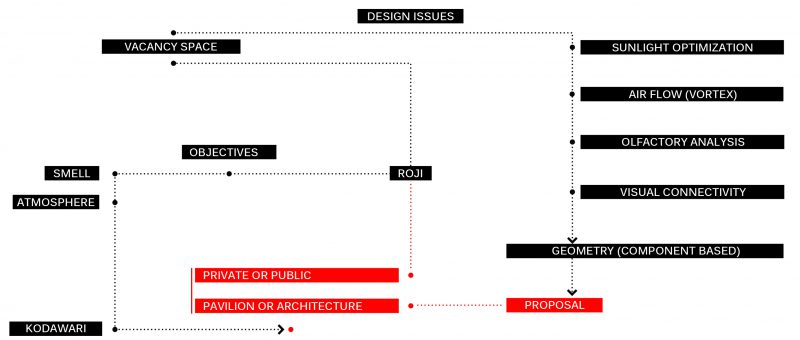
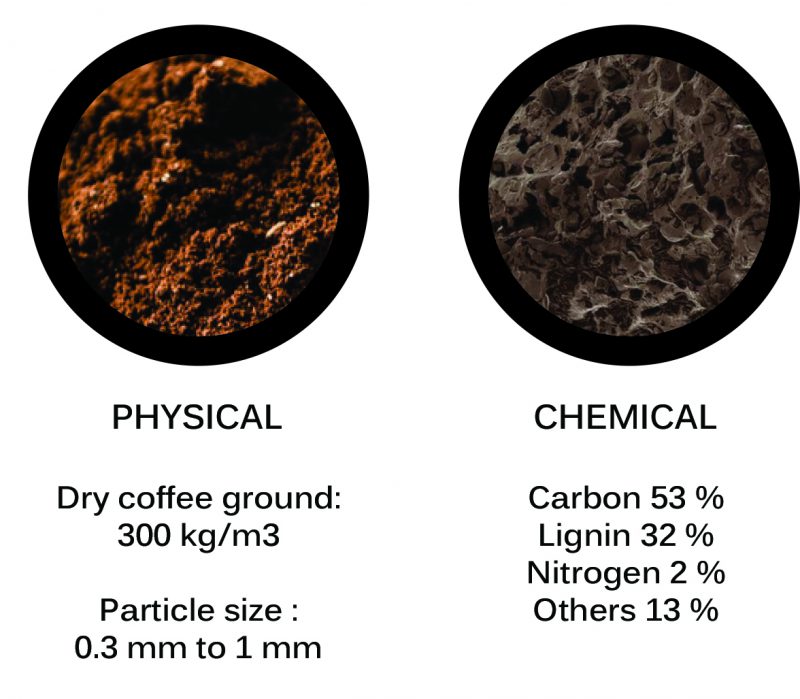
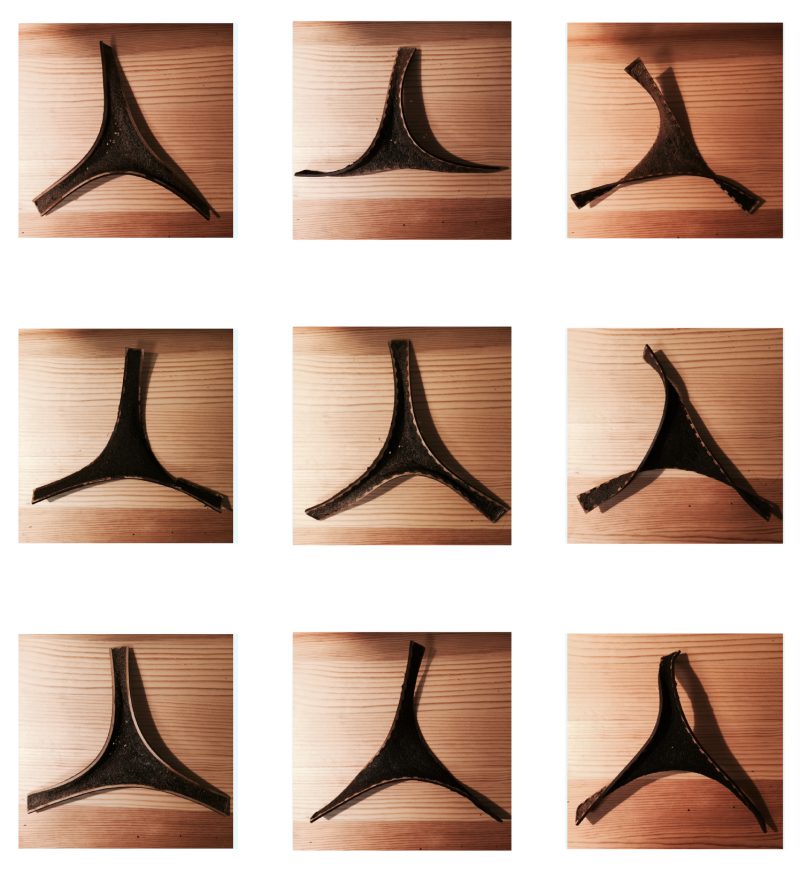
Students
- Kevin Clement
- Anders Rod
Professor
- Yusuke OBUCHI
Course Assistants
- Toshikatsu KIUCHI
Waste food at convenience stores is collected and transformed into a bioplastic material. This bioplastic can be used to create architecture.
コンビニエンスストアで廃棄食品を収集し、バイオ・プラスチック素材として再利用します。このバイオ・プラスチックを建築で使用します。
Waste food collected from convenience stores is collected. A large amount of food is wasted every day at Tokyo convenience stores and the waste has potential as a resource.
コンビニエンスストアから集めた廃棄食品を活用します。毎日、多量の食糧が東京のコンビニから廃棄されており、資源としての可能性があります。
The material is transformed into a bioplastic which hardens after a period of time.
材料は、一定の時間が経つと硬化するバイオ・プラスチックに変換されます。
The bioplastic is used with a 3D drawing pen and architecture can be “drawn” by a user.
バイオ・プラスチックは、 3 D描画ペンによって用いられ、ユーザーが建築を「描く」ことができます。
The project proposes a use for waste food and in creating the temporary architecture, produces a community gathering space.
このプロジェクトは、食品廃棄物の再利用した仮説建築によって、近隣コミュニティーの人々が集まることのできるスペースを提供します。
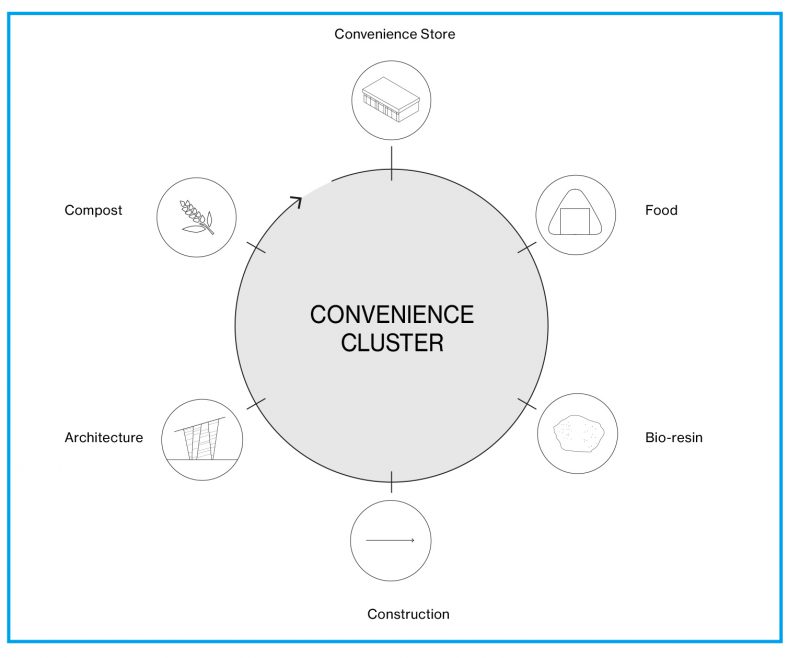
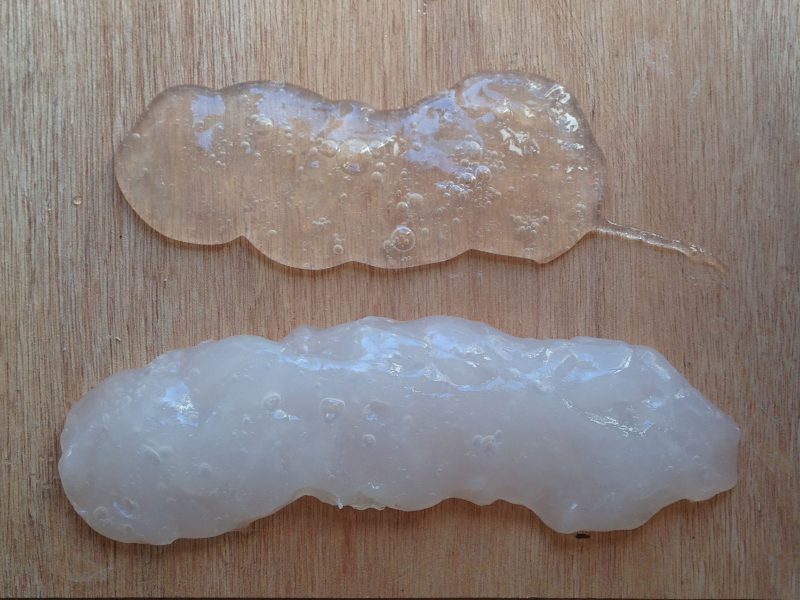
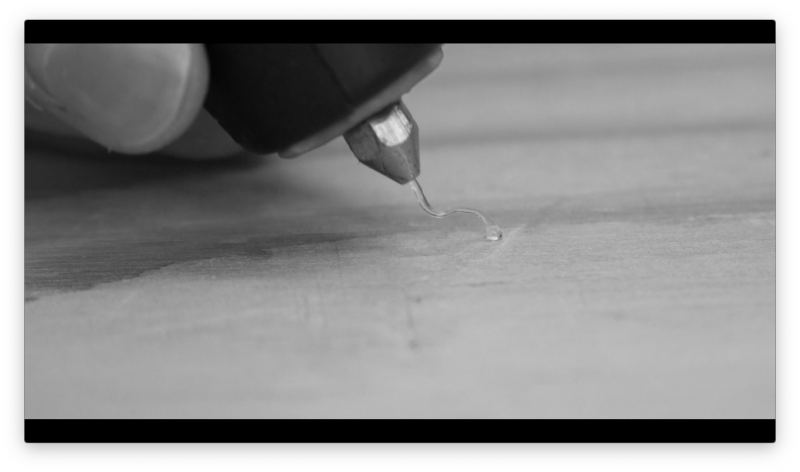
Students
- Benjamin Berwick
- Yanli Xiong
Professor
- Yusuke Obuchi
Course Assistants
- Toshikatsu Kiuchi
Hair is collected from Tokyo hair salons. The material is gathered and punched to produce components, and is then assembled to create an adaptive shade for apartments.
毛髪を東京の美容院から収集します。毛髪を圧縮してコンポーネントを形成し、集合住宅に適応する日除けをつくります。
The raw material for the project is hair collected from Tokyo hair salons. The clippings are usually thrown away, but on the urban scale and through aggregation, the hair is a potential resource.
プロジェクトの原料は、東京の美容院から収集した毛髪です。切り刻まれた毛髪は通常廃棄されますが、都市的な規模で集約することにより、資源となる可能性があります。
The hair is punched to create a fabric-like material after it is aggregated. Components can then be created from the material in a folding pattern.
毛髪は、生地のような素材に変換するため圧縮されます。出来上がったコンポーネントで、折り畳みパターンをつくります。
A series of folded components are fit together to produce a canopy which can be moved and repositioned as the user sees fit.
一連の折り畳みコンポーネントは、寄り集まって可動の日除けになります。ユーザーは、ふさわしい位置にそれを動かすことができます。
The canopy provides shade, but it also allows the owner of the canopy to personalize the façade of their balcony (upon which the canopy is placed).
日除けを動かすことによって、所有者は、集合住宅のファサードをカスタマイズすることができます。
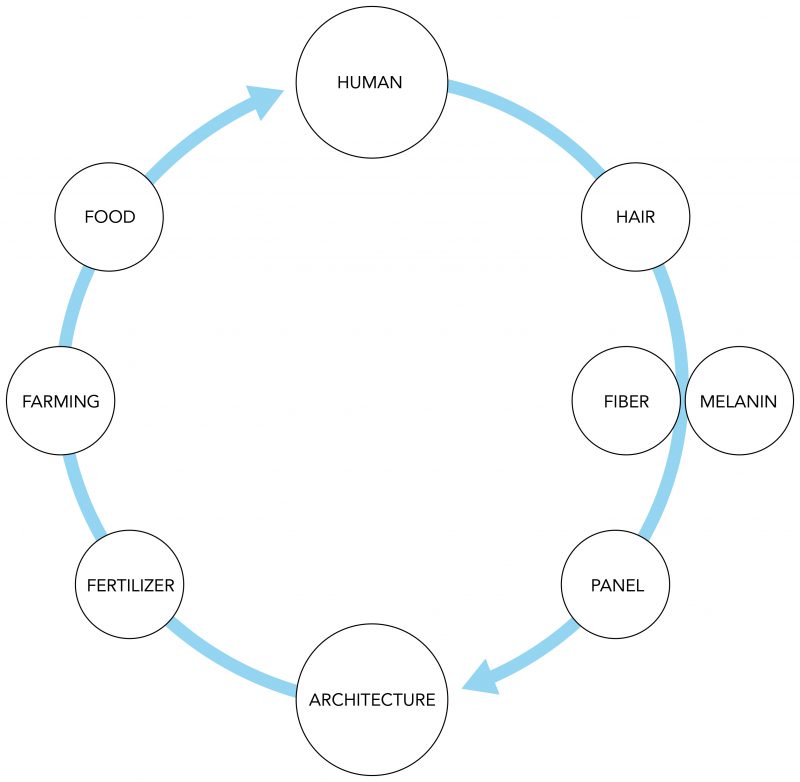
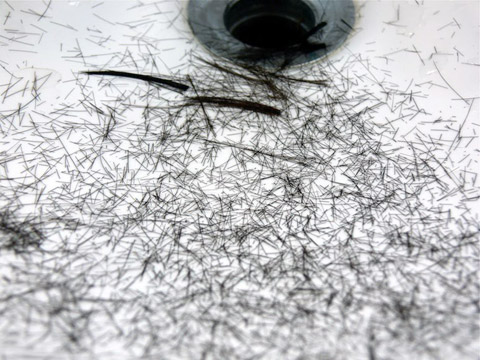
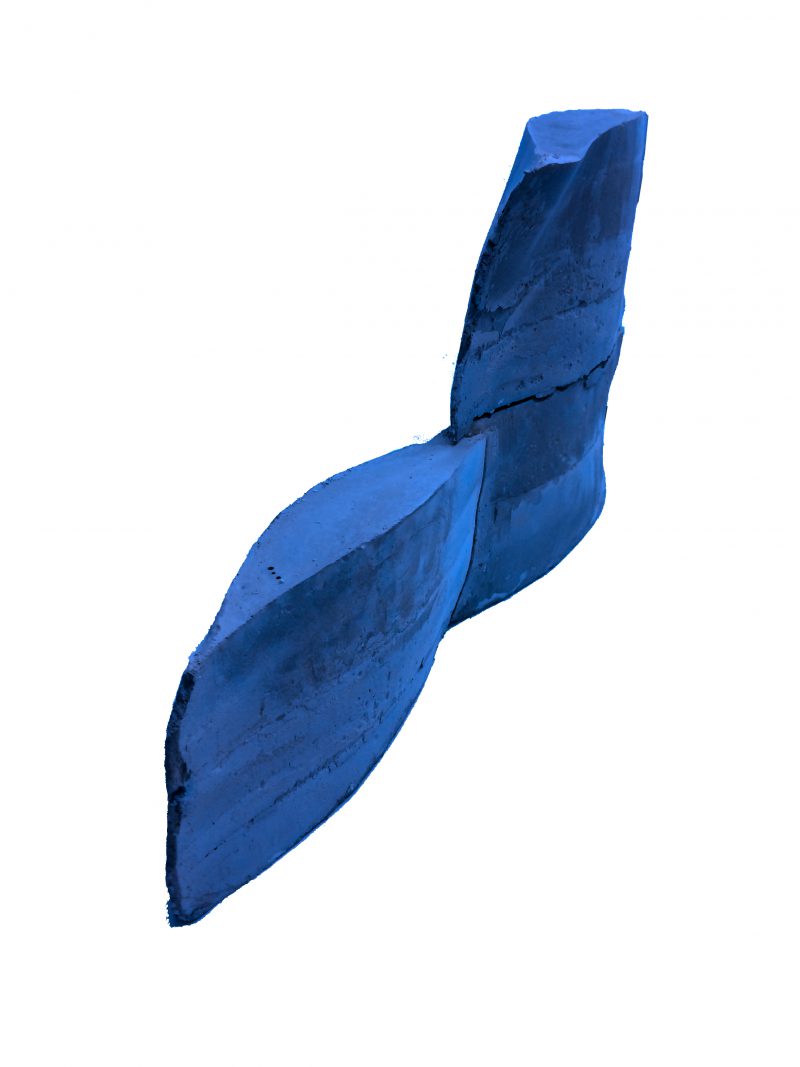
The University of Tokyo
Design Think Tank
INTERNET OF BEHAVIOR
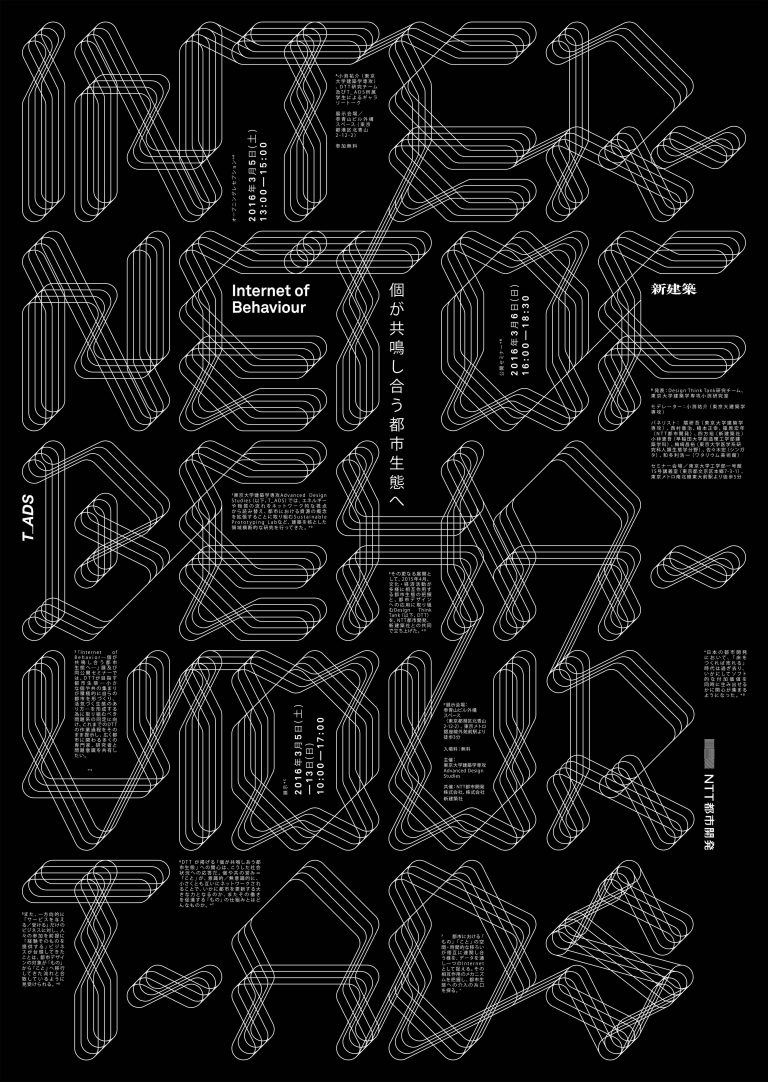
|展示|
日時:2016年3月5日(土)〜3月13日(日) 10:00 – 17:00
会場:参青山ビル外構スペース(東京都港区北青山 2-12-2)
東京メトロ銀座線外苑前駅より徒歩 3 分 入場無料
|オープニングレセプション|
日時:2016年3月5日(土) 13:00 – 15:00
会場:参青山ビル外構スペース(東京都港区北青山 2-12-2) 入場無料
※ 小渕祐介(東京大学建築学専攻)、DTT 研究チーム及び T_ADS 所属学生によるギャラリートーク
|公開セミナー|
日時:2016 年 3 月 6 日(日)16:00-18:30(開場 15:30)
場所:東京大学工学部1号館15号講義室(東京都文京区本郷 7-3-1) 定員100名先着順 入場無料
発表:Design Think Tank 研究チーム、東京大学建築学専攻小渕研究室
モデレータ:小渕祐介(東京大学建築学専攻)
パネリスト:隈研吾(東京大学建築学専攻)、 西村善治、楠本正幸、篠原宏年(NTT都市開発)、四方裕(新建築社)、小林恵吾(早稲田大学創造理工学部建築学科)、梅崎昌裕(東京大学医学系研究科人類生態学分野)、佐々木宏(シンガタ)、和多利浩一(ワタリウム美術館)
東京大学建築学専攻Advanced Design Studies(T_ADS)では、2015年4月、文化・経済活動が多様に相互作用する都市生態の把握と都市デザインへの応用に取り組む研究組織 Design Think Tank(DTT)を、NTT都市開発、新建築社との共同で立ち上げました。
「Internet of Behavior ―個が共鳴し合う都市生態へ―」展、及び公開セミナーでは、DTTが目指す都市生態——小さな個や共の集まりが積極的に自らの都市を形づくり、活気づく生態のあり方——を形成するために取り組むべき問題系の同定に向け、これまでのDTTの作業過程を提示し、広く都市に関わる専門家、研究者と問題意識を共有したいと考えています。
日本の都市開発において、「床をつくれば売れる」時代は過ぎ去り、いかにしてソフト的な付加価値を同時に生み出せるかに関心が集まるようになりました。また、一方向的に「サービスを与える/受ける」だけのビジネスに対し、人々の参加を前提に「経験そのものを提供する」ビジネスが台頭してきたことは、都市デザインの対象が「もの」から「こと」へ移行してきた流れと合致しているように見受けられます。DTT が考える「個が共鳴しあう都市生態」とは、こうした社会状況への応答を意図したものです。個や共の営み=「こと」が、小さくとも互いに意識的/無意識的にネットワークされることで、いかに都市を更新する大きな力となるのか、またその働きを促進する「もの」の仕組みとはどんなものか。都市における「もの」と「こと」の空間・時間的な移ろいが相互に連関し合う様を、データを通し一つのInternet として捉える。その相互作用のメカニズムを把握し、都市生態への介入の糸口を探ります。
主催
東京大学建築学専攻 Advanced Design Studies(T_ADS)
共催
NTT都市開発株式会社 株式会社新建築社
Exhibition
San-Aoyama Building (2-12-2, Kita-aoyama, Minato-ku, Tokyo)
2016/3/5 — 2016/3/13
10:00 – 17:00
Opening Reception
San-Aoyama Building (2-12-2, Kita-aoyama, Minato-ku, Tokyo)
2016/3/5
13:00 – 15:00
Open Seminar
Faculty of Engineering Building 1 Lecture Hall 15
2016/3/6
16:00 — 18:30 (Opens from 15:30)
moderator
– Yusuke Obuchi (The University of Tokyo)
panelist
– Kengo Kuma (The University of Tokyo)
– Yoshiharu Nishimura (NTT Urban Development)
– Masayuki Kusumoto (NTT Urban Development)
– Hirotoshi Shinohara (NTT Urban Development)
– Yutaka Shikata (Shinkenchiku-sha)
– Keigo Kobayashi (Waseda University)
– Masahiro Umezaki (The University of Tokyo)
– Hiroshi Sasaki (Shingata)
– Kouichi Watari (Watarium)
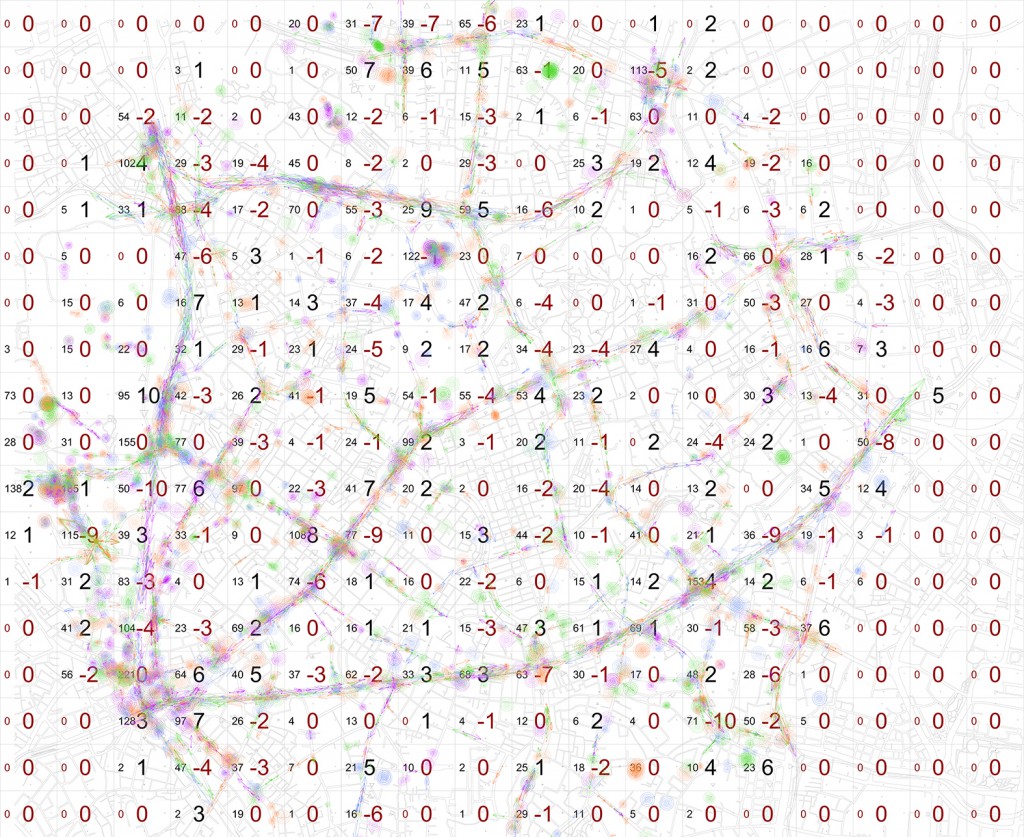
Students
- Fawad Osman
- Jin Qiaomu
Professor
- Yusuke Obuchi
Course Assistants
- Toshikatsu Kiuchi
An aggregate of chopsticks are arranged with the help of a guidance system to produce funicular cones.
大量の割り箸をガイド・システムを用いて配置することによって、逆円錐形状の建築をつくります。
Disposable chopsticks are the material chosen for this proposal. The chopsticks are gathered and used in aggregate.
使い捨て可能な割り箸が、この提案の素材です。集められた箸は、集積させて用います。
Used on a massive scale, the sticks are aggregated and held in place with glue.
大規模なスケールで使うため、集積した割り箸は接着剤で固定されます。
Stick aggregation is facilitated with a guidance system that essentially creates a large scale 3-D printing setup. The resulting cones produce a gathering space.
割り箸の集積は、巨大な3Dプリント機構によってガイドされます。結果として得られる逆円錐形は、人々が集う空間を演出します。
This architecture creates a use for waste chopsticks, an everyday material in Japan. It also creates a community center.
この建築は、日本で毎日大量に発生する割り箸を再利用することで、コミュニティの核となる場所をつくることを提案します。
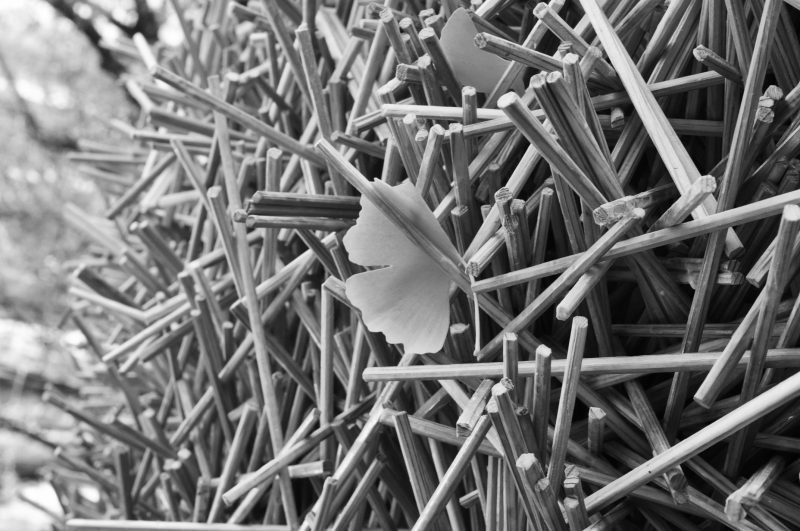
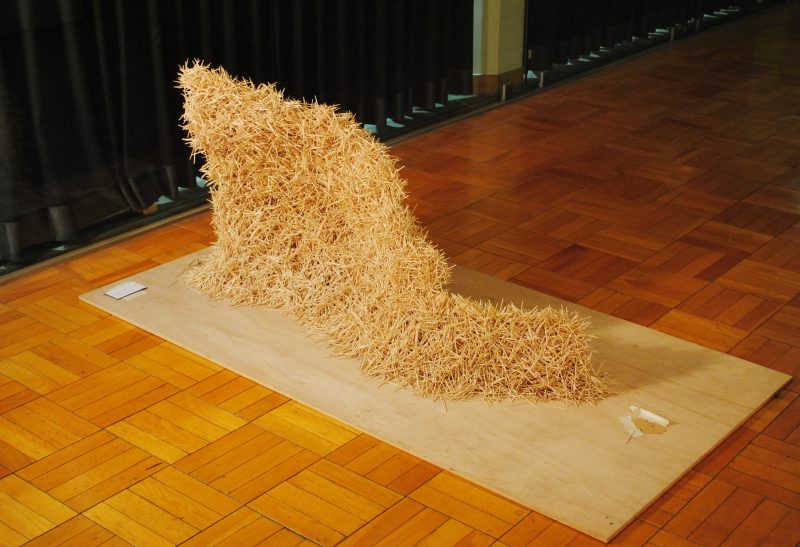
The 2015 Digital Fabrication Lab project, TOCA (Tool Operated Choreographed Architecture) explored the potentials of human-machine collaboration in a manner that expanded on the knowledge acquired in the 2014 STIK Pavilion project. The research and development of the TOCA project sought to utilize the adaptability and creativity of humans, and combine it with the precision and efficiency of machinery. The resulting pavilion utilized a scanning and guiding system to support human users on-site, a material used to extrude components (foam), a handheld “smart” tool to dispense the material, and a geometric form which iteratively optimized through use of a feedback system that integrated human error. The pavilion project, which began with a digitally-defined target model, was constructed on-site by teams of users, who sprayed components by hand. The results of the work were scanned and analyzed, and an updated digital model was defined and indicated to users for the next layer of the project. In this manner, any “errors” introduced throughout the spraying process were integrated into subsequent construction steps. The final pavilion represents the accumulation and integration of these errors. The project was made possible through cross-disciplinary collaboration; structural engineering, architecture, and computer science laboratories contributed to realizing the technologies and the final output.
Project Credits
University of Tokyo Staff
Yusuke Obuchi (Associate Professor), Department of Architecture
Jun Sato (Professor), Department of Frontier Sciences
Takeo Igarashi (Professor), Department of Computer Science
Kaz Yoneda (Research Assistant), Department of Architecture
Kosuke Nagata (Technical Advisor), Computer Science
Kensuke Hotta (Course Assistant), Department of Architecture
Mika Araki (Researcher), Department of Frontier Sciences
Yosuke Takami (Technical Assistant), Department of Computer Science
Students
Gilang Arenza
Hadin Charbel
Ann-Kristin Crusius
Jiang Lai
Samuel Eugene Lalo
Deborah Lopez Lobato
Yuanfang Lu
Ratnar Sam
Pitchawut Virutamawongse
Ying Xu
Jan Vranovsky
Akane Imai
Pan Kalin
Yi Dong Alric Lee
Ittidej Lirapirom
Kenneth Larssen Lonning
Luca Maruli
Moritz Munzenmaier
Masatoshi Nishizato
Victor Hugo Wido
Christopher Wilkens
Li Xu
Isaac Sekjoon Yoo
Yihan Zhang
Sponsor
Takenaka
Photographer
Jan Vranovsky
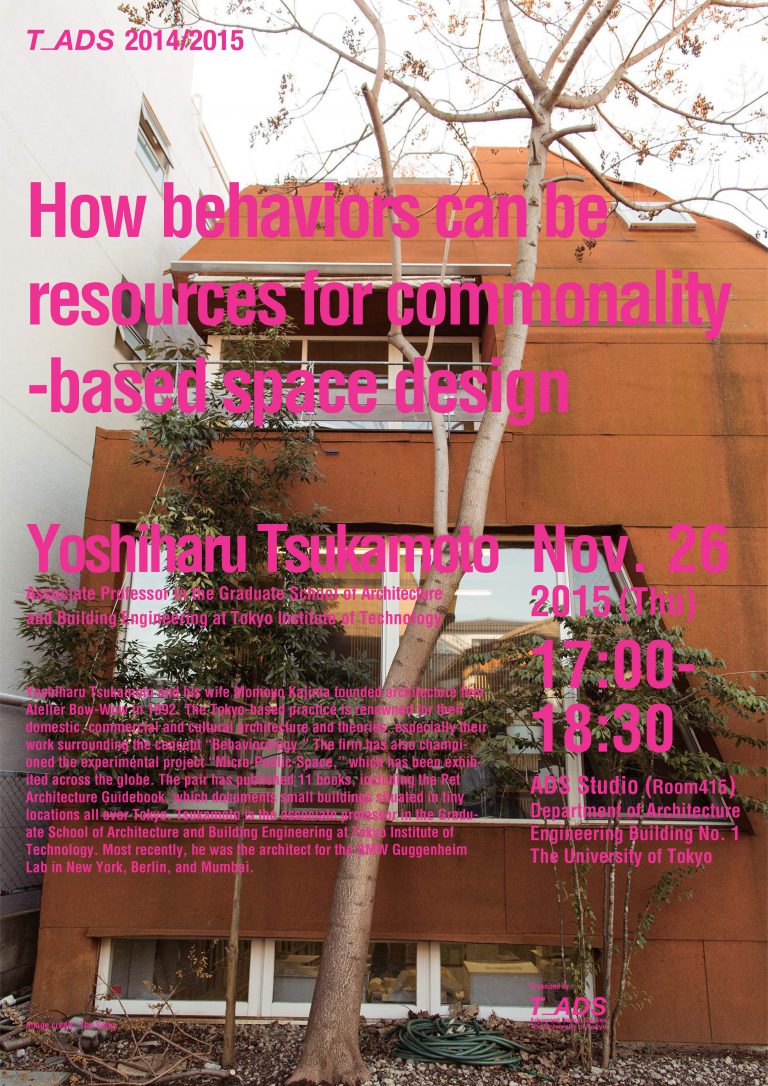
Lecture: How Behaviors can be Resources for Commonality-based Space Design
Speaker: Yoshiharu Tsukamoto, Associate Professor of the Graduate School of Architecture and Building at Tokyo Institute of Technology
November 26, 2015 (Thursday)
17:00-18:30
Yoshiharu Tsukamoto and his wife Momoyo Kajima founded architecture firm Atelier Bow-Wow in 1992. The Tokyo-based practice is renowned for their domestic, commercial and cultural architecture and theories, especially their work surrounding the concept “Behaviorology.” The firm has also championed the experimental project “Micro-Public-Space,” which has been exhibited across the globe. The pair has published 11 books, including the Pet Architecture Guidebook, which documents small buildings situated in tiny locations all over Tokyo. Tsukamoto is the associate professor in the Graduate School of Architecture and Building Engineering at Tokyo Institute of Technology. Most recently, he was the architect for the BMW Guggenheim Lab in New York, Berlin, and Mumbai.
The University of Tokyo
Digital Fabrication Lab Pavilion 2015
TOCA (Tool Operated Choreographed Architecture)
|パビリオン展示|
日時:12月1日(火)〜12月14日(月) 10:00 – 17:00
場所:東京大学本郷キャンパス工学部1号館前広場
|パネル・模型展示|
日時:11月24日(火)〜12月14日(月) 7:00 – 18:00(平日のみ)
場所:東京大学本郷キャンパス工学部11号館1階展示スペース
|シンポジウム|
機械・人間・建築 Ⅱ Architecture in the Age of Cyborgs Ⅱ
日時:12月5日(土)13:00 – 18:00(開場12:30)
場所:東京大学工学部1号館15号講義室(定員100名先着順 入場無料)
趣旨:3Dプリンタやレーザーカッターなどのデジタル・ファブリケーション機器は、建築の生産と私たちの生活をどう変えるのか—— DFL(Digital Fabrication Lab)は毎年、建設会社と共同で、デジタル・ファブリケーションを応用した実験的パビリオンの建設を行っています。本年、竹中工務店と共同で行っているTOCA(Tool Operated Choreographed Architecture)プロジェクト(進行中)は、昨年に引き続き「人と機械の恊働」をテーマとし、「人が地面から建築を描き上げる3Dペン」による建築に挑みます。
昨年取り組んだ STIK(Smart Tool Integrated Konstruction)プロジェクトでは、あらかじめ決めた目標形状に向けて、デジタルの施工情報をプロジェクション・マッピングで作業者に伝えるシステムと、割り箸のような棒材を接着剤とともに送り出す手持ち工具を組み合わせ、「人と機械が融合した3Dプリンタ」による新しい建築表現を実現しました。今年のTOCAプロジェクトでは、目標形状を作業者に伝えることに加えて、人の作業による誤差をデジタル化して構造最適化をくり返すことで、目標形状自体を徐々に変化させることを試みます。これは、人と機械が恊働することにより、あらかじめ形状がデザインされていながら、人間的なゆらぎを柔軟に取り込み、実際の施工によってはじめてユニークに形状が確定する建設システムです。
シンポジウムでは、第一部で、DFLと共同研究した構造の佐藤淳研究室、コンピューター・サイエンスの五十嵐健夫研究室、そして竹中工務店とともにパビリオンTOCAの成果を報告します。第二部では、デジタル機械の建築への応用研究を推進しているスイス連邦工科大学チューリッヒ校(ETH-Z)教授のマティアス・コーラー氏を招き、国内で先進的な研究を行っている研究者の方々とともに、私たちがこれから考えるべき機械・人間・建築について議論を行います。
第一部(13:00 -): 小渕祐介(東京大学准教授)、米田カズ(東京大学小渕研究室)、五十嵐健夫(東京大学教授・コンピュータ科学専攻)、荒木美香(東京大学佐藤淳研究室・構造担当)、竹中工務店プロジェクトチーム
第二部(15:30 -): マティアス・コーラー(スイス連邦工科大学チューリッヒ校教授)、金田充弘(東京藝術大学准教授)、池田靖史(慶應義塾大学大学教授)、小林博人(慶應義塾大学教授)
オープニングレセプション(18:00 – 19:00)参加無料
主催
東京大学建築学専攻 Advanced Design Studies(T_ADS)
企画
東京大学建築学専攻 Digital Fabrication Lab(DFL)
共同研究
株式会社竹中工務店
東京大学大学院情報理工学系研究科コンピュータ科学専攻 五十嵐健夫研究室
東京大学工学系研究科建築学専攻 佐藤淳研究室
研究協力
株式会社エービーシー商会
太陽金網株式会社
マーキュリー・サプライ・システムス株式会社
デミレックジャパン株式会社
圓井繊維機械株式会社
サンエム工業株式会社
(順不同)
Display of the Pavilion
In Front of Faculty of Engineering Building 1, Hongo Campus
2015/12/1 — 2015/12/14
10:00 – 17:00
Panel and Process Exhibition
Faculty of Engineering Building 11 Atrium Exhibition Space
2015/11/24 — 2015/12/14
7:00 – 19:00 (Weekdays)
Symposium : Architecture in the Age of Cyborgs Ⅱ
Faculty of Engineering Building 1 Lecture Hall 15
2015/12/5
13:00 — 18:00 (Opens from 12:30)
Session 1 (13:00 – )
– Yusuke Obuchi (The University of Tokyo)
– Kaz Yoneda (The University of Tokyo)
– Takeo Igarashi (The University of Tokyo, Computer Science)
– Mika Araki (The University of Tokyo, Structure Engineering)
– TAKENAKA Project Team
Session 2 (15:30 – )
– Matthias Kohler (ETH-Z)
– Mitsuhiro Kanada (Tokyo University of the Arts)
– Yasushi Ikeda (Keio University)
– Hiroto Kobayashi (Keio University)
Opening Reception 18:00 – 19:00
Students
- Ma SUSHANG
- Zhang YE
Professor
- Yusuke OBUCHI
Course Assistants
- Toshikatsu KIUCHI
- So SUGITA
Students
- Christopher SJOBERG
- Yeonsang SHIN
Professor
- Yusuke OBUCHI
Course Assistants
- Toshikatsu KIUCHI
- So SUGITA
T_ADS + Shinkenchiku Lecture Series #02
Kenri Kodaka |
Body-image reconstruction based on the principle of the body ownership illusion.
Date
August 28 (FRI) 18:00-20:00 (Opens from 17:30, Free admission)
Location
U-Tokyo Faculty of Engineering Bldg.1 LectureRoom 15
Lecturer
Kenri Kodaka
Born in 1979. Received Ph.D. in Engineering from WABOT-HOUSE Laboratory, Waseda University, after graduating from the Faculty of Integrated Humanities at Kyoto University and IAMAS (Institute of Advanced Media Arts and Sciences). In 2012, became an associate professor at the Nagoya City University School of Design and Architecture, Graduate School of Design and Architecture. Research focuses on physical misperceptions. Received many awards, such as the Best Paper Award at IPSJ2005, selected for Ask? Film Festival 2007, Best Paper Award in Robotics at IEEE/SICE SII2011, and Interactive Presentation Award at Interaction 2015.
Language
English
Sponser
U-Tokyo Advanced Design Studies (T_ADS)
Shinkenchiku
—
T_ADS + 新建築社 レクチャーシリーズ第二回
小鷹研理 |
錯覚原理を足場に構想する、<からだ>のリコンストラクション
日時
2015年8月28日(金) 18:00 – 20:00(開場17:30)
場所
東京大学本郷キャンパス工学部一号館 15号教室
講師
小鷹 研理
1979年生まれ。京都大学総合人間学部卒業後、京都大学情報学研究科・IAMASを経て、早稲田大学WABOT-HOUSE研究所で博士(工学)を取得。2012年より現職(名古屋市立大学芸術工学研究科・准教授)。主にからだの錯覚に関する研究に従事。大会論文賞(IPSJ2005)、入選(Ask?映像祭2007)、BEST PAPER AWARD ROBOTICS(IEEE/SICE SII2011)、インタラクティブ発表賞(インタラクション2015)等受賞。
言語
英語
主催
東京大学建築学専攻 Advanced Design Studies (T_ADS)
新建築社
T_ADS + Shinkenchiku Lecture Series #01
Keita Watanabe |
Interface design in the Post-Internet Age
Date
August 26th (Wed) 18:00-20:00 (Opens from 17:30, Free admission)
Location
U-Tokyo Faculty of Engineering Bldg.1 #415
Lecturer
Keita Watanabe
Born in 1981. A lecturer at the Meiji University’s Department of Frontier Media Science, School of Interdisciplinary Mathematical Sciences. The President and CEO of Cidre Interaction Design. Received Ph.D. in Media and Governance from Keio University, Graduate School of Media and Governance. Researches interactive methods for interface and internet designs based on perception and corporeality. Recently published “融けるデザイン ハードxソフトxネットの時代の新たな設計論” (BNN, Inc., 2015).
Language
Japanese / English(Realtime translation)
Sponser
U-Tokyo Advanced Design Studies (T_ADS)
Shinkenchiku
—
T_ADS + 新建築社 レクチャーシリーズ第一回
渡邊恵太 |
インターネット前提時代のインターフェースデザイン
日時
2015年8月26日(水) 18:00 – 20:00(開場17:30)
場所
東京大学本郷キャンパス工学部一号館 415号教室
講師
渡邊 恵太
1981年生まれ。明治大学総合数理学部 先端メデイアサイエンス学科専任講師。
シードルインタラクションデザイン株式会社代表取締役社長。 2009年慶應義塾
大学政策メディア研究科博士課程修了。博士(政策・メディア)。知覚や身体性
を活かしたインターフェイスデザインやネットを前提としたインタラクション
手法を研究。近著に『融けるデザイン ハードxソフトxネットの時代の新たな
設計論』(BNN新社、2015)。
言語
日本語 / 英語(同時通訳)
主催
東京大学建築学専攻 Advanced Design Studies (T_ADS)
新建築社
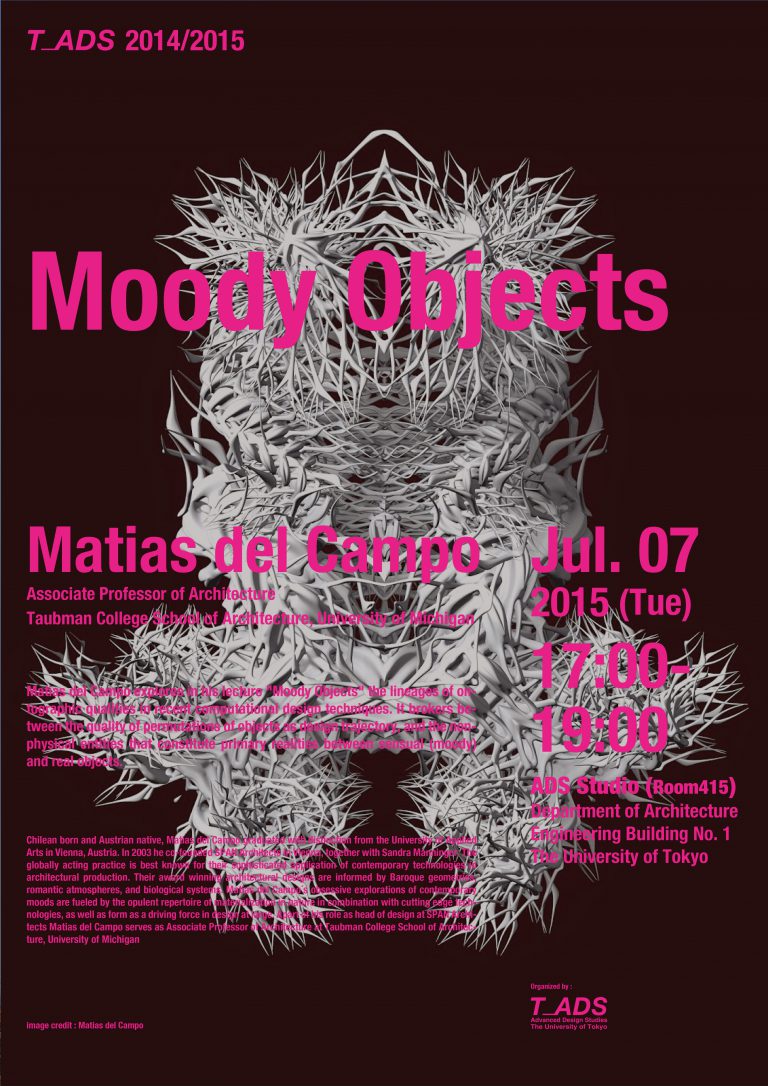
Lecture: Moody Objects
Speaker: Matias del Campo, Associate Professor of Architecture, Taubman College of Architecture, University of Michigan
July 7, 2015 (Tuesday)
17:00-19:00
Matias del Campo explores in his lecture “Moody Objects” the lineages of ontographic qualities in recent computational design techniques. It brokers between the quality of permutations of objects as design trajectory, and the non- physical entities that constitute primary realities between sensual (moody) and real objects.
Chilean born and Austrian native, Matias del Campo graduated with distinction from the University of Applied Arts in Vienna, Austria. In 2003 he co-founded SPAN Architects in Vienna, together with Sandra Manninger. The globally acting practice is best known for their sophisticated application of contemporary technologies in architectural production. Their award winning architectural designs are informed by Baroque geometries, romantic atmospheres, and biological systems. Matias del Campo ́s obsessive explorations of contemporary moods are fueled by the opulent repertoire of materialization in nature in combination with cutting edge technologies, as well as form as a driving force in design at large. Apart of his role as head of design at SPAN Architects Matias del Campo serves as Associate Professor of Architecture at Taubman College School of Architecture, University of Michigan
日時: 2015年6月5日(金)18:00 – 20:00(開場17:30)
場所:清水建設本社 シミズホール(東京都中央区京橋2-16-1)
定員: 300名(要予約 入場無料)
予約方法:氏名、所属、連絡先を明記の上、6月3日までに以下の連絡先にメールを送付ください。sekkeikikaku@shimz.co.jp
出演:アレハンドロ・ザエラ・ポロ(プリンストン大学)/大橋成基(清水建設)/池田靖史(慶応義塾大学)/小渕祐介(東京大学)
プリンストン大学教授で、横浜大さん橋を設計した建築家のアレハンドロ・ザエラ・ポロ氏の特別レクチャーをおこないます。6月6日(土)、7日(日)のイベントでは、Continuous Architectureという建築のアイディアを中心に議論がおこなわれるのに対し、本レクチャーは、横浜大さん橋という時代を象徴する建築自体にフォーカスを当てる予定です。予約制となりますが、ぜひご参加ください。
主催:慶応義塾大学大学院 政策・メディア研究科 EDGEプログラム グローバルイノベーション人材育成連携プログラム/東京大学建築学専攻 Advanced Design Studies (T_ADS)
協賛:清水建設株式会社
June 5 (FRI) 18:00-20:00
Shimizu Hall (2-16-1 Kyobashi, Chuo-ku, Tokyo)
(Opens from 17:30, 300 seats maximum, Free admission)
Prior booking essential: Please send an E-mail with your name, position, and contact to the following address by June 3. sekkeikikaku@shimz.co.jp
– Alejandro Zaera-Polo (Princeton University, AZPML)
– Naruki Ohashi (Shimizu Corporation)
– Yasushi Ikeda (Keio University)
– Yusuke Obuchi (The University of Tokyo)
横浜港大さん橋国際客船ターミナル国際コンペ20周年 建築シンポジウム
2015年6月6日(土)
磯崎新 基調講演 「わ」空間の制度と構造
時間: 17:00 – 20:00(開場16:30)
場所:東京大学 工学部1号館15号講義室(定員 100名先着順 入場無料)
出演:磯崎新/エリック・オーウェン・モス/ジェフリー・キプニス/隈研吾/小渕祐介
2015年6月7日(日)
シンポジウム THE SAGA OF CONTINUOUS ARCHITECTURE 連続的建築は、これからも連続するか?
時間: 10:00 – 16:30(開場 9:30)
場所:横浜港大さん橋国際客船ターミナル 大さん橋ホール(定員 800名先着順 入場無料)
[第一部]“Agile Topologies: bringing the ground to life”
アレハンドロ・ザエラ・ポロ/渡辺邦夫/ジェシー・ライザー/梅本奈々子/隈研吾/ジェフリー・キプニス
[第二部]“The generalized calculated surface: The incredible, Lightness and Being”
妹島和世/佐々木睦朗/ヘルナン・ディアス・アロンソ/リーアム・ヤング/小渕祐介
[総括]磯崎新
1995年におこなわれた横浜港大さん橋国際客船ターミナル国際コンペで実施案となったForeign Office Architects (FOA)案の基本コンセプトContinuous Architectureは、その後の20年間に世界でどのように展開したのか? それを実現させた日本では、どのような独自の発展があったのか? 幅広い視点から議論をおこない、これからの建築の可能性について考える。 Continuous Architectureとは、連続する一枚の面(サーフェス)などによって構成される連続的建築で、1990年代初頭にロンドンのAAスクールを中心に理論化がはじまり、デジタル技術の建築設計への応用が活発化するのに並行してアメリカ東海岸を中心にプロジェクトに用いられ、世界的に大きな影響を及ぼした。横浜港大さん橋国際客船ターミナルはContinuous Architectureが大規模な建築として実現された世界初の事例であると言われる。
後援:
YKK AP株式会社 窓研究所
公益財団法人ユニオン造形文化財団
小松精練株式会社
主催:
東京大学建築学専攻 Advanced Design Studies (T_ADS)
Princeton University School of Architecture
Southern California Institute of Architecture (SCI-Arc)
Yokohama International Port Terminal Competition 20th Anniversary
THE SAGA OF CONTINUOUS ARCHITECTURE
June 6 (Sat) 17:00-20:00
Arata Isozaki Keynote Lecture: System and Structure of “Wa” Spaces
The University of Tokyo Engineer Bldg.1 Lecture room 15
(Opens from 16:30, 100 seats maximum, Free admission)
– Arata Isozaki (Arata Isozaki & Associates)
– Eric Owen Moss (SCI-Arc, Eric Owen Moss Architects)
– Jeffrey Kipnis (The Ohio State University)
– Kengo Kuma (The University of Tokyo, Kengo Kuma & Associates)
– Yusuke Obuchi (The University of Tokyo)
June 7 (Sun) 10:00-16:30
Symposium: The Saga of Continuous Architecture
Yokohama International Port Terminal Osanbashi Hall
(Opens from 09:30, 800 seats maximum, Free admission)
Session 1: “Agile Topologies: bringing the ground to life”
– Alejandro Zaera-Polo (Princeton University, AZPML)
– Kunio Watanabe (Structural Design Group)
– Jesse Reiser (Princeton University, Reiser+Umemoto RUR Architecture)
– Nanako Umemoto (Columbia University, Reiser+Umemoto RUR Architecture)
– Kengo Kuma (The University of Tokyo, Kengo Kuma & Associates)
– Jeffrey Kipnis (The Ohio State University)
Session 2: “The generalized calculated surface: The incredible, Lightness and Being”
– Kazuyo Sejima (SANAA)
– Mutsuro Sasaki (Hosei University, Sasaki and Partners)
– Hernan Diaz Alonso (SCI-Arc, XEFIROTARCH)
– Liam Young (Princeton University, Tomorrow’s Thoughts Today)
– Yusuke Obuchi (The University of Tokyo)
Conclusion
– Arata Isozaki (Arata Isozaki & Associates)
The occasion of the Yokohama International Port Terminal competition in 1995 was a watershed moment for the discipline of architecture in many respects. A new generation of architects and theorists across the globe seized it as a platform to explore emerging modalities in design, design technology, and delivery which would become the mediums through which and against which much of contemporary practice would play out. To understand this shift is to recognize that the Port Terminal project elicited changes not simply in one architectural register but across almost all of the disciplinary and sub-disciplinary categories that involve the conception and practice of design.
This symposium will reengage the Yokohama Terminal with neither nostalgia nor negativity. The symposium is designed to trace the birth and development of continuous architecture, a concept which became a basis for the design of the Yokohama Terminal. The symposium will also include a discussion of the influence of the project on current architectural practices and beyond.
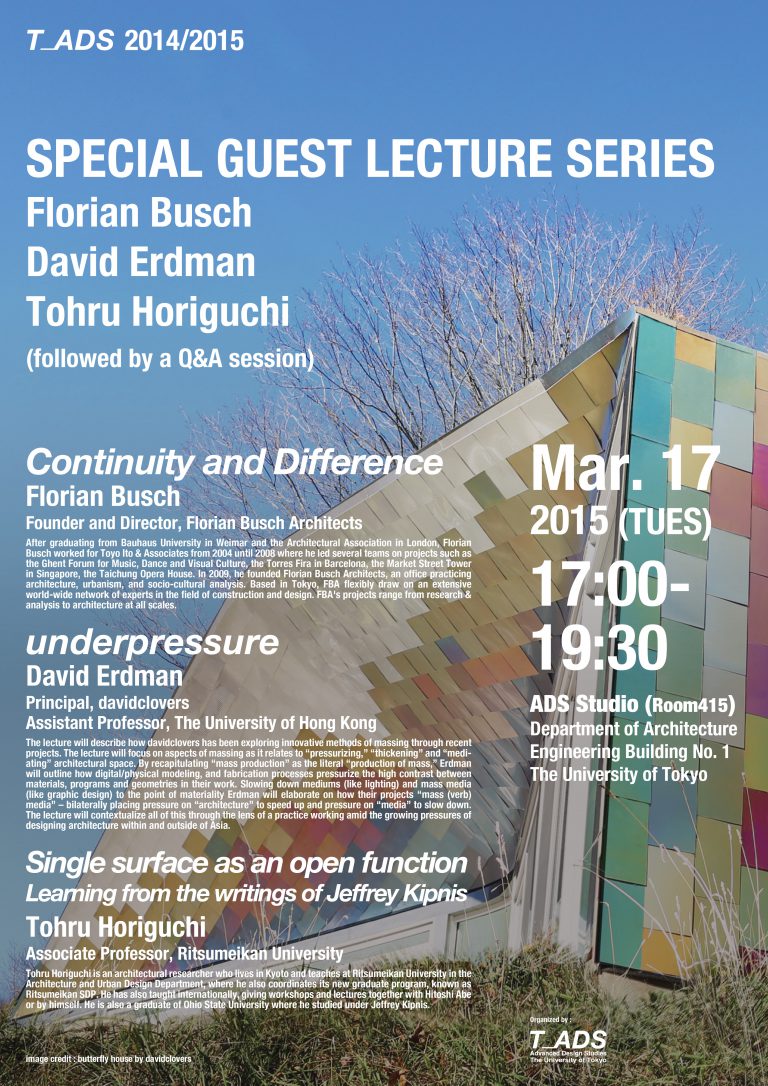
March 17, 2015 (Tuesday)
17:00-19:30
Special Guest Lecture Series
Florian Busch
David Erdman
Tohru Horiguchi
Continuity and Difference
Florian Busch
After graduating from Bauhaus University in Weimar and the Architectural Association in London, Florian Busch worked for Toyo Ito & Associates from 2004 until 2008 where he led several teams on projects such as the Ghent Forum for Music, Dance and Visual Culture, the Torres Fira in Barcelona, the Market Street Tower in Singapore, the Taichung Opera House. In 2009, he founded Florian Busch Architects, an office practicing architecture, urbanism, and socio-cultural analysis. Based in Tokyo, FBA flexibly draw on an extensive world-wide network of experts in the field of construction and design. FBA’s projects range from research & analysis to architecture at all scales.
underpressure
David Erdman
The lecture will describe how davidclovers has been exploring innovative methods of massing through recent projects. The lecture will focus on aspects of massing as it relates to “pressurizing,” “thickening” and “mediating” architectural space. By recapitulating “mass production” as the literal “production of mass,” Erdman will outline how digital/physical modeling, and fabrication processes pressurize the high contrast between materials, programs and geometries in their work. Slowing down mediums (like lighting) and mass media (like graphic design) to the point of materiality Erdman will elaborate on how their projects “mass (verb) media” – bilaterally placing pressure on “architecture” to speed up and pressure on “media” to slow down. The lecture will contextualize all of this through the lens of a practice working amid the growing pressures of designing architecture within and outside of Asia.
Single surface as an open function Learning from the writings of Jeffrey Kipnis
Tohru Horiguchi
Tohru Horiguchi is an architectural researcher who lives in Kyoto and teaches at Ritsumeikan University in the Architecture and Urban Design Department, where he also coordinates its new graduate program, known as Ritsumeikan SDP. He has also taught internationally, giving workshops and lectures together with Hitoshi Abe or by himself. He is also a graduate of Ohio State University where he studied under Jeffrey Kipnis.
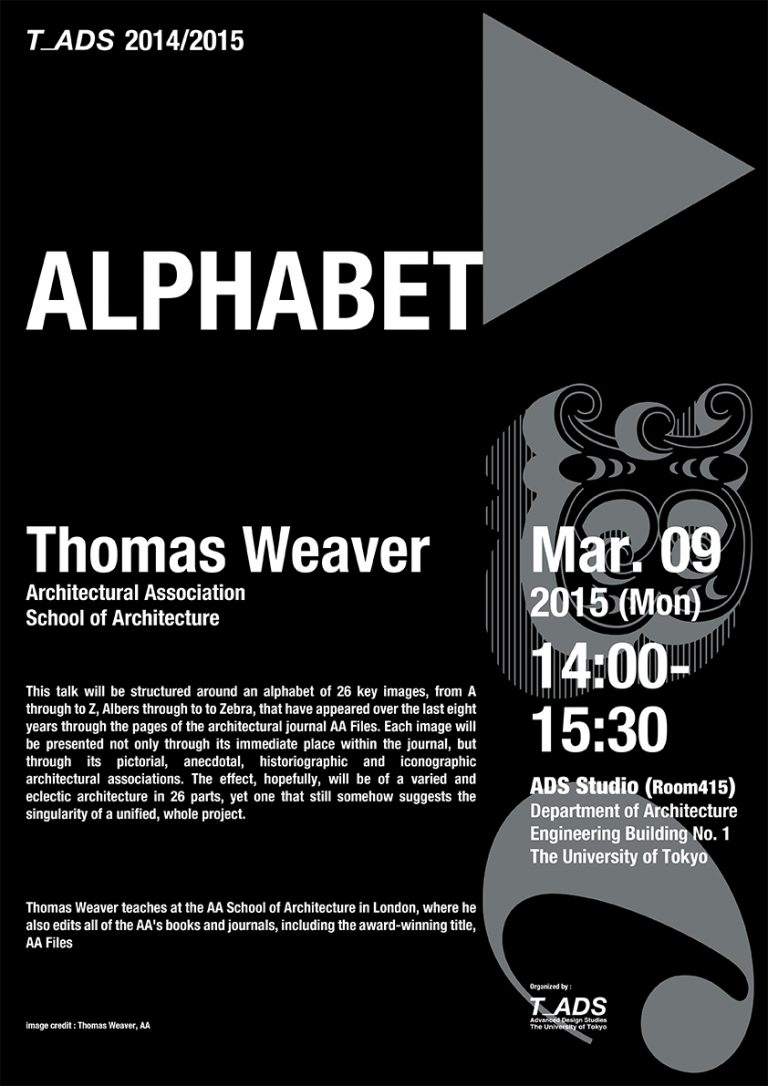
Lecture: Alphabet
Speaker: Thomas Weaver
Architectural Association, School of Architecture
March 9, 2015 (Monday)
14:00-15:30
This talk will be structured around an alphabet of 26 key images, from A through to Z, Albers through to to Zebra, that have appeared over the last eight years through the pages of the architectural journal AA Files. Each image will be presented not only through its immediate place within the journal, but through its pictorial, anecdotal, historiographic and iconographic architectural associations. The effect, hopefully, will be of a varied and eclectic architecture in 26 parts, yet one that still somehow suggests the singularity of a unified, whole project.
Thomas Weaver teaches at the AA School of Architecture in London, where he also edits all of the AA’s books and journals, including the award-winning title, AA Files
Design Team:
The University of Tokyo teaching staff: Yusuke Obuchi, Toshikatsu Kiuchi, So Sugita, Hironori Yoshida, Kosuke Nagata, Kaz Yoneda
The University of Tokyo students: Kevin Clement, Minjie Xu, Fawad Osman, Qiaomu Jin, Ornchuma Saraya, Benjamin Berwick, Anders Rod, Yanli Xiong, Gilang Arenza Judinaputra, Pitchawut Virutamawongse, Samuel Aaron Eugene Lalo, Rossina Shatarova, Ratnar Sam, Ying Xu, Deborah Lopez, Hadin Habib Charbel, Ann-Kristin Crusius, Jiang Lai, Yuanfang Lu, Alexandra Karlsson, Jan Vranovsky, Mariko Mori
Completion date: November 2014
Digital Fabrication Lab Pavilion, 2014
Design Team:
The University of Tokyo teaching staff: Yusuke Obuchi, Toshikatsu Kiuchi, So Sugita, Hironori Yoshida, Kosuke Nagata, Kaz Yoneda
The University of Tokyo students: Kevin Clement, Minjie Xu, Fawad Osman, Qiaomu Jin, Ornchuma Saraya, Benjamin Berwick, Anders Rod, Yanli Xiong, Gilang Arenza Judinaputra, Pitchawut Virutamawongse, Samuel Aaron Eugene Lalo, Rossina Shatarova, Ratnar Sam, Ying Xu, Deborah Lopez, Hadin Habib Charbel, Ann-Kristin Crusius, Jiang Lai, Yuanfang Lu, Alexandra Karlsson, Jan Vranovsky, Mariko Mori
Shimizu Corporation: Kazuhide Sakai, Takeya Sato, Hiroyuki Ogura, Hideki Umeyama, Kiichiro Tanno, Zaita Hironori, Syunsuke Igarashi, Masahiro Indo, Keigo Takeuchi, and Shimiz Kiba Wood Workshop
Structural engineer: Jun Sato, Mika Araki, Masaaki Miki
Department of Socio-Cultural Environmental Studies / Graduate School of Frontier Sciences
Guidance System: Prof. Takeo Igarashi, Yosuke Takami
Department of Computer Science / Graduate School of Information Science and Technology
Design Phase: October 2013 – March 2014
Design development, fabrication & construction: April – November 2014
Completion date: November 2014
“Projection and Reception”
Date : March 17th 2013
Guest Panel : Jesse Reiser, Nanako Umemoto, Sylvia Lavin, Brett Steele, Jeff Kipnis, Kengo Kuma, Yusuke Obuchi
The University of Tokyo
2014 Digital Fabrication Lab Research Pavilion
STIK (Smart Tool Integrated Konstruction)
|パビリオン展示|
日時:12月2日(火)〜12月16日(火) 10:00 – 17:00
場所:東京大学本郷キャンパス工学部1号館前広場
|制作プロセス展示|
日時:11月17日(月)〜12月16日(火) 7:00 – 19:00(平日のみ)
場所:東京大学本郷キャンパス工学部11号館1階展示スペース
|シンポジウム|
機械・人間・建築 Architecture in the Age of Cyborgs
日時:12月7日(日)13:00 – 18:00
場所:東京大学工学部1号館15号講義室
趣旨:3Dプリンタやレーザーカッターなどのデジタル・
第一部(13:00-)登壇者: 小渕祐介(東京大学特任准教授・モデレーター)、吉田博則(東京大学DFL担当)、佐藤淳(東京大学准教授・構造設計)、五十嵐健夫(東京大学教授・システム設計協力)、清水建設プロジェクトチーム、印藤正裕(清水建設生産技術本部本部長)
第二部(16:00-)講演者+登壇者: マティアス・コーラー(スイス連邦工科大学チューリッヒ校教授)、五十嵐健夫(東京大学教授)、隈研吾(東京大学教授・モデレーター)、小渕祐介(東京大学特任准教授・モデレーター)
オープニングレセプション(18:00-19:00)参加無料
ARCHINEERING DESIGN EXHIBITION, 2013
Project Team : Christopher Sjoberg, Yeonsang Shin, Miguel Puig, Zhang Ye, Ana Luisa Soares, Ma Sushuang, Tong Shan, Andrea Trajkovska, Quangtuan Ta, Wei Wang, Anders Rod, Benjamin Berwick, Qiaomu Jin, Fawad Osman, Yanli Xiong, Andrea Bagniewski, Kevin Clement, Ornchuma Saraya, Minjie Xu
Yusuke Obuchi, Associate Professor
Jun Sato, Associate Professor
Toshikatsu Kiuchi, Course Assistant
So Sugita, Course Assistant
Hiroaki Yoshida, Course Assistant
Stair-Scape Library
Student : Ana Ilic, Maria Larsson, Yasemin Sahiner, Oclin Wang
Yusuke Obuchi, Associate Professor
Toshikatsu Kiuchi, Course Assistant
STACK
Student : Guillaume Dumont, Mickey Htoo, Dasom Lee, Lauren Li, Colin Lin ,Chong Wang, Risa Tagami
Yusuke Obuchi, Associate Professor
Toshikatsu Kiuchi, Course Assistant
Different Brick
Project Team : Yasemin Sahiner, Ana Ilic, Kyaw Htoo
Fabrication Team : Kevin Clement, Ornchuma Saraya, Minjie Xu
Yusuke Obuchi, Associate Professor
Jun Sato, Associate Professor
Masaaki Miki, Postdoctoral Researcher
Toshikatsu Kiuchi, Course Assistant
So Sugita, Course Assistant
Hiroaki Yoshida, Course Assistant
Hydrotechtonic Proto-structure, 2012
Project Team : Ana Ilic, Risa Kagami, Maria Larsson, Yasemin Sahiner
Yusuke Obuchi, Associate Professor
Jun Sato, Associate Professor
Toshikatsu Kiuchi, Course Assistant
Taiwan Children’s Art Museum, 2011
Students : Deli Zhao, Olesia Biloborodko, Jeep Prinya Narongthanarath, Colin Xuhao Lin, Trudy Ko
Yusuke Obuchi, Associate Professor
Koishikawa Fence Competition, 2010
Students :
Yuta Ito, Seungjun Lee
Yusuke Obuchi, Associate Professor
Jun Sato, Associate Professor
Real Size Thinking Competition, 2013
Students :
Guillaume Dumont, Maria Larsson, Dejan Mojic
Ana Ilic, Mickey Htoo, Yasemin Sahiner
Lauren Li, Colin Lin, Dasom Lee
Chong Wang, Oclin Wang
Christopher Sjoberg, Yeonsang Shin, Quangtuan Ta
Miguel Puig, Wei Wang
Zhang Ye, Ma Sushuang, Tong Shan
Yusuke Obuchi, Associate Professor
Toshikatsu Kiuchi, Course Assistant
So Sugita, Course Assistant
The lecture will describe three projects from Balestra’s interdisciplinary platform Urban Nouveau:
1. Incremental Housing Strategy in India: a method to legalize a natural construction process made by the urban poor, keeping the urban fabric of the village intact and transforming old shacks into safe living structures while bringing water, waste water removal and electricity into every home. Each house prototype is the result of a participatory design with the residents and every home is customizable by the user. The pilot project comprises 1200 houses.
2. Connecting Stockholm: a long term regional strategy for the region of Stockholm in Sweden. The tactic aims at framing the urban growth of the city and the suburbs in what Urban Nouveau calls bridge villages. These urban bridges are communities that stand in between the currently segregated pieces of the city.
3. TISA / The Informal School of Architecture: the launching of a vehicle to bring students out of the school or university building and connect them with underprivileged communities and people with hardcore problems. By interacting with locals and understanding their challenges, the students can get together to design and build incremental solutions for immediate positive change. The pilot project took place in Cova do Vapor, Trafaria, Portugal.
Filipe Balestra works in the fields of architecture and urbanism in both formal and informal workscapes through participatory design experiences. Balestra understands the human being has not yet learned to live on planet Earth, so he dedicates his work to drawing the path in the direction of our collective evolution.
10月1日、16:00より東京大学工学部1号館416号教室にて、Urban Nouveau*を主催する建築家フィリップ・バレストラ氏によるレクチャーを行います。Urban Nouveau*でのプロジェクトを中心に紹介します。
フィリップ・バレストラ
1981年ブラジル生まれ、建築家。ストックホルム王立工科大学終了後、リオデジャネイロのスラムにて小学校を建設するプロジェクトや、インドのスラム街を現地NGO、住民とともにプラン策定、改修するプロジェクト”incremental housing”を運営する。主な業績に、TED イェーテボリ出演、ストックホルム建築博物館にて展覧会”connecting stockholm”開催など。掲載誌多数。
Digital Fabrication Lab Pavilion, 2013
Design Team:
The University of Tokyo teaching staff: Yusuke Obuchi, Toshikatsu Kiuchi, So Sugita, Hironori Yoshida
The University of Tokyo students: Christopher Sjoberg, Yeonsang Shin, Miguel Puig, Zhang Ye, Ana Luisa Soares, Ma Sushuang, Tong Shan, Andrea Trajkovska, Quangtuan Ta, Wei Wang, Anders Rod, Benjamin Berwick, Qiaomu Jin, Fawad Osman, Yanli Xiong, Andrea Bagniewski, Kevin Clement, Ornchuma Saraya, Minjie Xu
Obayashi Corporation: Tomoo Yamamoto, Kenichi Misu, Gendai Ono, Yasuo Ichii, Keisuke Fujiwara, Shunsuke Niwa, Tatsuji Kimura, Masaru Emura, Taiki Byakuno, Takahide Okamoto
Structural engineer: Jun Sato
Fabrication of components: Tsukasa Takenaka (AnS Studio)
Construction: Multibuilder
Fabrication: Togari Kogyo
Structure: Freeform Surface Tensegrity Structure
Specifications:
Compressive components: stainless steel plates with 0.5 mm / 0.8 mm / 1.2 mm / 1.5 mm thickness
Tension cables: stainless steel cables in 3 mm diameter
Base ring: stainless steel pipe in 48mm diameter
Foundation: precast concrete blocks
Furniture: painted plywood
Weight: 1.5 t (upper structure in stainless steel), 1 t (concrete foundation)
Design Phase: October 2012 – March 2013
Design development, fabrication & construction: April – November 2013
Completion date: 24 November 2013
Students
- Kyaw HTOO
- Ana ILIC
- Yasemin SAHINER
Professor
- Yusuke OBUCHI
Collaborate Professors
- Jun SATO
- Futoshi KURISU
Course Assistants
- Toshikatsu KIUCHI
- So SUGITA
Computational Support
- Masaaki MIKI
Students
- Wang LIN
- Wang CHONG
Professor
- Yusuke OBUCHI
Collaborate Professors
- Jun SATO
- Takafumi NOGUCHI
- Ryoma KITAGAKI
Course Assistants
- Toshikatsu KIUCHI
- So SUGITA
Computational Support
- Masaaki MIKI
Students
- Xuhao LIN
- Dasom LEE
- Shuang LI
Professor
- Yusuke OBUCHI
Collaborate Professors
- Jun SATO
Course Assistants
- Toshikatsu KIUCHI
- So SUGITA
Computational Support
- Masaaki MIKI
Students
- Guillaume DUMONT
- Maria LARSSON
- Dejan MOJIC
Professor
- Yusuke OBUCHI
Collaborate Professors
- Jun SATO
- Masayuki Mae
Course Assistants
- Toshikatsu KIUCHI
- So SUGITA
Computational Support
- Masaaki MIKI
Symposium: Architectural Theory Now
これからの建築理論
槇文彦、磯崎新、原広司
Fumihiko Maki, Isozaki Arata, Hiroshi Hara
司会:隈研吾
Moderator: Kengo Kuma
日時:2013年12月1日「日」17:00-19:30
会場:東京大学工学部1号館15号教室
主催:東京大学建築学専攻Advanced Design Studies (ADS)
企画:東京大学建築学専攻Media Initiative Lab (MIL)
開催趣旨
主に1990年代以降、グローバリズムやコンピューター技術発展の波に乗り、さまざまな建築をつくる「実験」が世界中で行われてきました。しかし、その波も一段落したと考えられる昨今、これからの建築はどのようにあるべきでしょうか。本シンポジウムは、建築の実践と理論の両面で活躍しつづける三名の建築家――槇文彦氏・磯崎新氏・原広司氏――を招き、建築の可能性を考える「建築理論」について問い直しながら、これからの建築、そして教育について考えます。
東京大学建築学専攻Advanced Design Studies(ADS)、Media Initiative Lab(MIL)とは
東京大学建築学専攻Advanced Design Studies(ADS)は、国際的で最先端のデザイン教育と建築文化の発展をめざし、研究室の枠をこえて活動する研究組織です(主要メンバー:隈研吾・千葉学・小渕祐介).ADSの一部であるMedia Initiative Lab(MIL)は、シンポジウム・展示・出版といったメディアを通じて、建築を議論するプラットフォームを提供することを目的としています。
Date and Time: December 1st, Sunday, 17:00 – 19:30
Location: Engineering Building No.1, Lecture Hall (Room 15), The University of Tokyo Hongo Campus
Speakers: Fumihiko Maki, Arata Isozaki, Hiroshi Hara
Moderator: Kengo Kuma (Professor, The University of Tokyo)
Organized by: Advanced Design Studies, Department of Architecture, The University of Tokyo
Curated by: Media Initiative Lab, Department of Architecture, The University of Tokyo
After the 1990s, a number of architectural experiments around the world were driven by both globalism and advancements in computing technology. This trend seems to have slowed in recent years, and we now find ourselves at a point where we must once again question contemporary architectural discourse.
We have invited the three most prominent figures in both the practice and theory of contemporary Japanese architecture – Fumihiko Maki, Arata Isozaki, and Hiroshi Hara – to explore possibilities of architecture and architectural education through “Architectural Theory”.
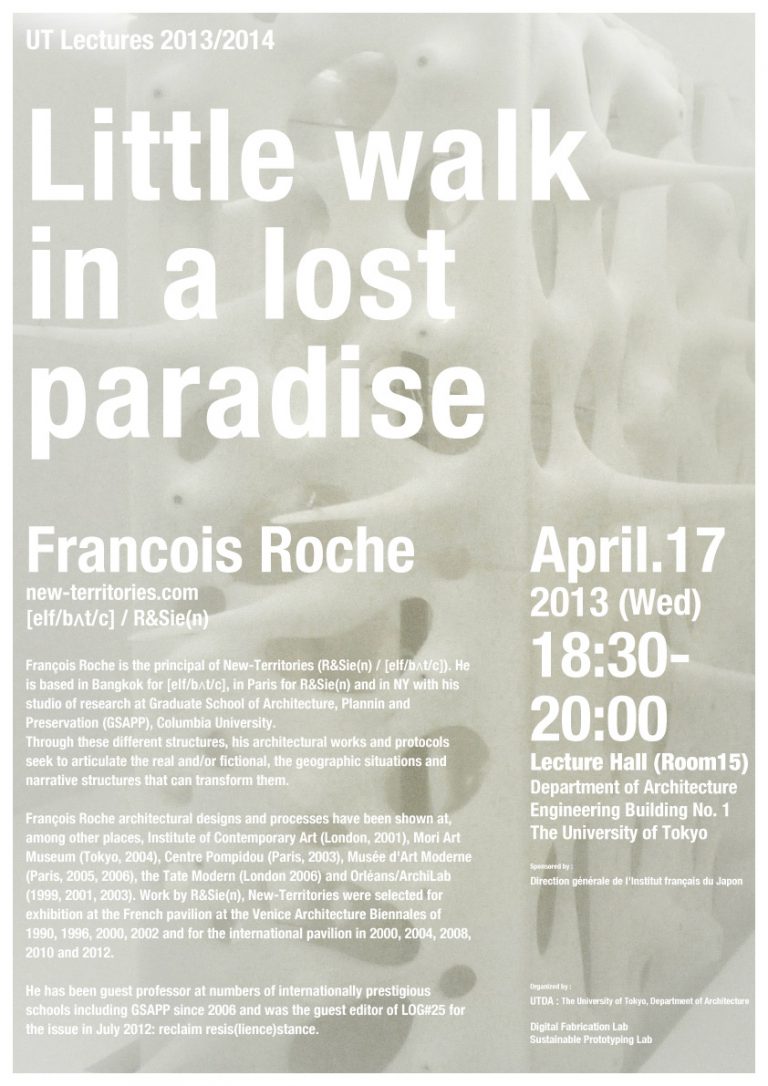
Lecture: Little Walk in a Lost Paradise
Speaker: Francois Roche
April 17, 2013
18:30-20:00
François Roche is the principal of New-Territories (R&Sie(n) / [eIf/bʌt/c]). He is based in Bangkok for [eIf/bʌt/c], in Paris for R&Sie(n) and in NY with his studio of research at Graduate School of Architecture, Plannin and Preservation (GSAPP), Columbia University.
Through these different structures, his architectural works and protocols seek to articulate the real and/or fictional, the geographic situations and narrative structures that can transform them.
François Roche architectural designs and processes have been shown at, among other places, Institute of Contemporary Art (London, 2001), Mori Art Museum (Tokyo, 2004), Centre Pompidou (Paris, 2003), Musée d’Art Moderne (Paris, 2005, 2006), the Tate Modern (London 2006) and Orléans/ArchiLab (1999, 2001, 2003). Work by R&Sie(n), New-Territories were selected for exhibition at the French pavilion at the Venice Architecture Biennales of 1990, 1996, 2000, 2002 and for the international pavilion in 2000, 2004, 2008, 2010 and 2012.
He has been guest professor at numbers of internationally prestigious schools including GSAPP since 2006 and was the guest editor of LOG#25 for the issue in July 2012: reclaim resi(lience)stance.
Michael Hansmeyer joined us for his lecture “Digital Groteseque” in April.
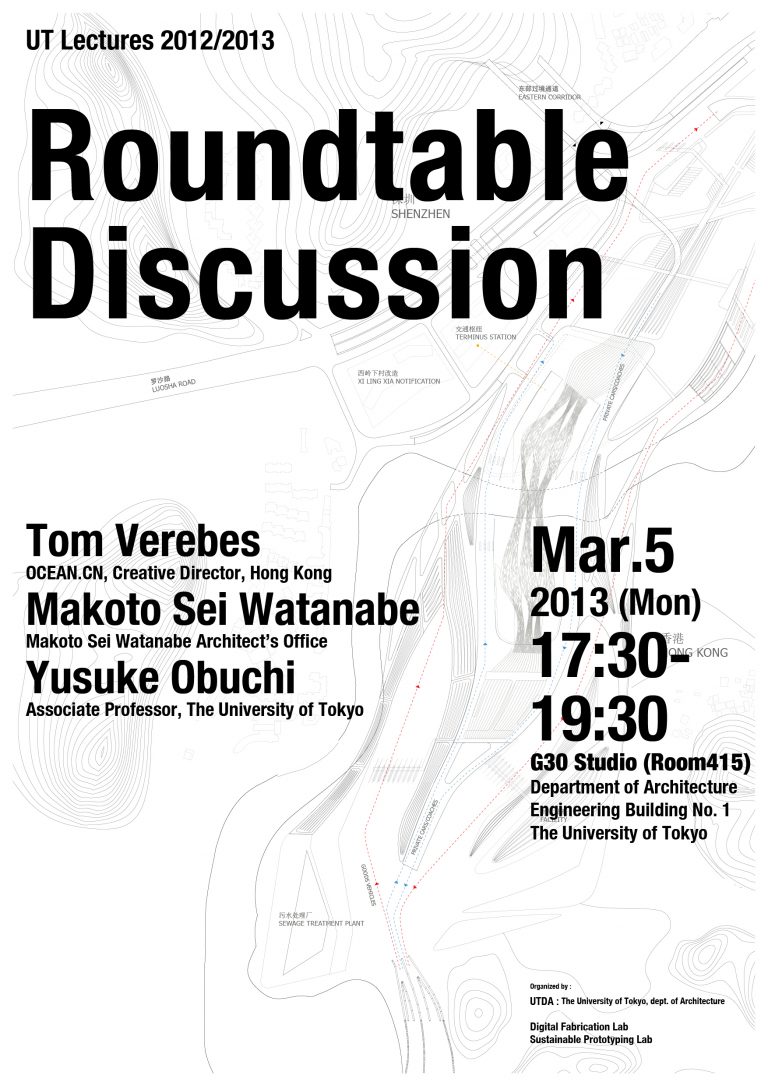
Roundtable Discussion Session
Participants: Tom Verebes (OCEAN.CN, Creative Director, Hong Kong), Makoto Sei Watanabe (Makoto Sei Watanabe Architect’s Office), Yusuke Obuchi (Associate Professor, The University of Tokyo)
March 5, 2013 (Monday)
17:30-19:30
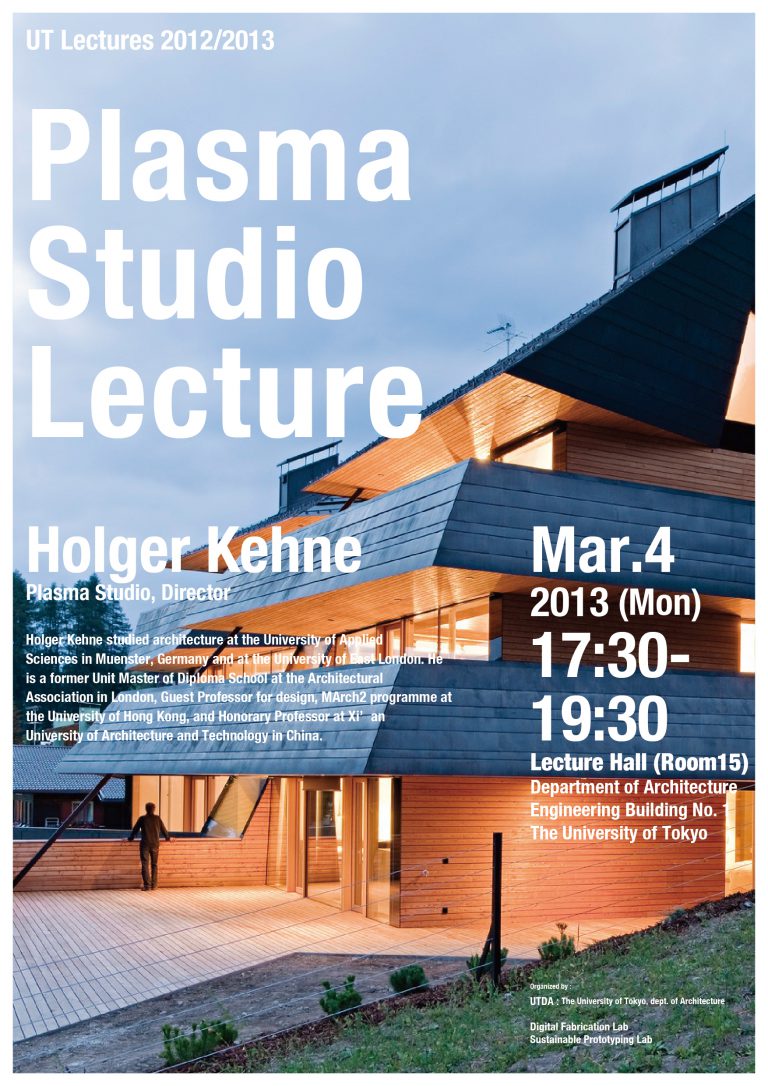
Lecture: Plasma Studio
Speaker: Holger Kehne, Director, Plasma Studio
March 4, 2013 (Monday)
17:30-19:30
Holger Kehne studied architecture at the University of Applied Sciences in Muenster, Germany and at the University of East London. He is a former Unit Master of Diploma School at the Architectural Association in London, Guest Professor for design, MArch2 programme at the University of Hong Kong, and Honorary Professor at Xi’ an University of Architecture and Technology in China.
Lecture: Performative Morphology in Architecture
Speaker: Achim Menges, Architect, Professor at University of Stuttgart, Director of Institute on Computational Design
February 15, 2013 (Friday)
18:00-20:00
Achim Menges’ work focuses on the development of integral design processes at the intersection of morphogenetic design computation, biomimetic engineering and computer aided manufacturing that enables a highly articulated, performative built environment. His work is based on an interdisciplinary approach in collaboration with structural engineers, computer scientists, material scientists and biologists.
Achim Menges has been Visiting Professor in Architecture at Harvard University’ s Graduate School of Design (2009-10), at the AA School of Architecture in London (2009-current) and at Rice University in Houston (2004).
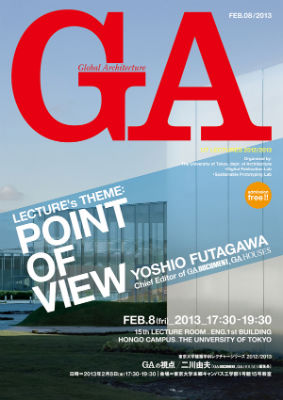
Lecture: Point of View
Speaker: Yoshio Futagawa
February 8, 2013 (Friday)
17:30-19:30
Lecture: Collaborations – Ebb & Flux
Speakers: Guy Nordenson, Structural Engineer, Professor at Princeton University
Mutsuro Sasaki, Structural Engineer, Professor at Hosei University
January 24, 2013 (Thursday)
18:30-20:30
Circle Pack Pavilion
Project Team : Taichi Kuma, Colin Xuhao Lin, Mickey Kyaw Htoo, Wang Chong, Guillaume Dumont, Wang Lin
with Olesia Biloborodko, Yuta Ito, Ana Ilic, Yasemin Sahiner, Maria Larsson, Dejan Zoran Mojic, Shuang Li, Dasom Lee, Ana Luisa Soares, Zhang Ye, Tong Shan, Shin Yeonsang, Miguel Puig, Christopher Sjoberg, Ma Sushuang, Laura Miguelanez, Andrea Trajkovska
Yusuke Obuchi, Associate Professor
Jun Sato, Associate Professor
Toshikatsu Kiuchi, Course Assistant
So Sugita, Course Assistant
Students
- Colin Lin
- Jeep Narongthanarath
- Haruka Tomoeda
Professor
- Yusuke OBUCHI
Course Assistants
- Toshikatsu KIUCHI
- So SUGITA
Human hair is collected and it is woven into a fabric-like material. These hair components are then used to retrieve oil from oil spills in the ocean. Following retrieval, soft rubber tubes form a geometry around the oil-soaked hair. The resulting architecture thus stores the energy of the oil and also makes a public space.
髪の毛が収集され、生地のような素材に織り込まれています。毛髪のコンポーネントは、海洋における油流出から油を回収するために使用されます。回収された後、油を吸収した髪の周りに柔らかいゴム製の管でジオメトリを形成します。結果、作成されるアーキテクチャはこうして油のエネルギーを格納し、パブリック スペースになります。
Hair is collected as a key material. It is under-utilized, has highly absorbent properties, and exhibits potential as a phase-changing material. The oil from oil spills is hazardous and is detrimental to both the local and global environment. It is damaging to wildlife, plants, and oceans. It also indicates economic loss. It affects water supplies in communities.
髪がキー マテリアルとして収集されます。髪は活用されていない資源です。高い吸収性があり、相変化材料として使用できる可能性を有しています。オイルスピルからの油は危険で、ローカルとグローバル両方の環境に有害です。野生動物、植物や海に有害のみならず経済的損失を示します。また、コミュニティの水供給に影響します。
Hair is collected (from donations) and is then punched into a fabric-like material and used to create hair booms. It is covered in a solidifying agent such that when it absorbs oil in the intended application, it hardens after a period of approximately two weeks. The hardened components can then be stored and shaped. In this way, oil can be safely stored and the hair finds a new application.
寄付から収集された毛は、生地のような素材に圧縮され、髪ブーム(浮き)を作成するために使用します。さらに、特殊な凝固剤で覆われており、目的としていた油を吸収して約 2 週間経った後に固まります。硬化した部品は、保存および形成することができます。したがって、油を安全に保存することができる髪の毛は、新しい利用法を得ることができました。
The hardened hair/oil components are covered in a soft rubber and are formed into catenary arches. These function as public gathering spaces.
硬化した髪・石油コンポーネントは柔らかいゴムで覆われ、カテナリー・アーチを形成しています。これらは公共のスペースとして機能します。
The catenary arch structures act as energy storage facilities. In times of emergency, the structure can be disassembled for use as fuel and the oil soaked booms can be shipped to locations in need of energy. Additionally, the scheme would have the benefit of cleaning up the environment in the local area. More land in the area could be public use, facilitated by the addition of new community gathering spaces.
カテナリー・アーチの構造体は、エネルギーを温存する設備として機能します。緊急事態時、構造を分解することでエネルギーを必要としている場所に燃料として使用するために石油を吸収したブームを出荷することができます。さらに、この一連の流れは、周辺環境のクリーンアップの利点があります。より多くの場が地域の公共の場として使用でき、新しいコミュニティが集まるスペースの増加が見込まれます。
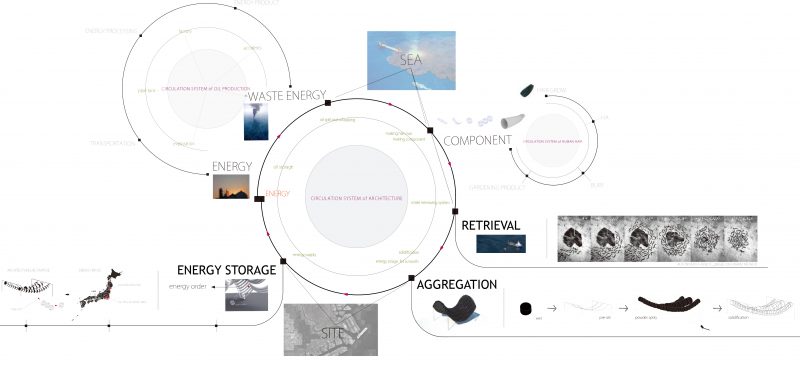
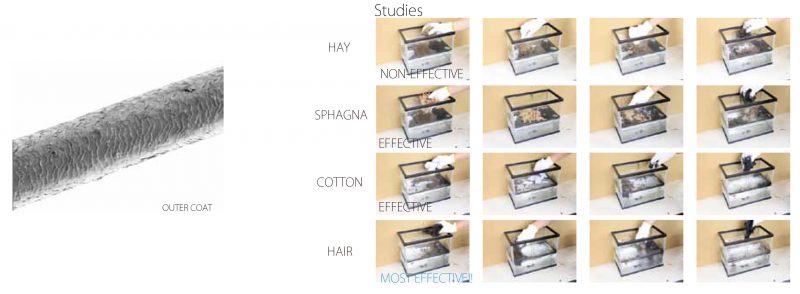

Students
• Olesia Biloborodko
• Trudy Ko
• Deli Zhao
Professor
• Yusuke OBUCHI
Course Assistants
• Toshikatsu KIUCHI
• So SUGITA
Mussels are used to produce architecture. There are three phases to the architecture. Phase 1 is the mussel growing phase, during which water is purified. Phase 2 is the mussel solidifying phase, where the mussels become a structural system and their architectural characters can be shaped. Phase 3 is the mussel decomposition phase, where energy is produced.
ムール貝を建築的に使用しています。この建築には、 3 つのフェーズがあります。フェーズ 1 は、ムール貝の成長段階で水が浄化されます。フェーズ 2 は、ムール貝の硬化段階による構造システムの形成と建築的要素が形作られる段階です。フェーズ 3 は、ムール貝が分解しエネルギーを生成するものです。
Mussels are shallow water organisms that live at a maximum depth of 10 meters. They are most abundant at or near low tide level, where their food supplies are most concentrated. One mussel can clean four liters of water per hour. In aggregate, there is potential for mussels to address issues such as industrial discharge, soil erosion, and domestic sewage. Polluted fresh water, which makes up just 0.1% of earth’s water could be cleansed with mussels. A waste water purification plant can clean 80,000 liters of water per day, the equivalent to 1000 mussels.
ムール貝。最大10 メートルの深さに生息する浅海生物。食糧が最も豊富な干潮もしくはそれ以下の深さで集中して生息している。1つムール貝で4リットルの水を1時間で浄化できます。ムール貝の群集体は、産業廃棄物、土壌浸食、生活排水などの問題を解決する可能性があります。地球上の水の0.1%を占めている汚染された淡水は、ムール貝で浄化することが可能です。従来の浄水場は、1日80,000リットルの水を浄化でき、ムール貝1000匹に相当します。
Mussels must be gathered together on a series of ropes to form catenary curves. The mussels self-assemble on lines and harden in place, during which phase the water is purified. Through this process, the mussel element (in aggregate) gains the ability to act as an architecture.
ムール貝を縄に収集することでカテナリー曲線の構造を形成する必要があります。ムール貝は一列に自己形成し、その場で硬化するうちに水を精製する段階に入ります。このプロセスで群集したムール貝の要素は、建築として機能する能力を得ます。
Once hardened into the catenary curve position underwater, the mussel lines gain the ability to perform as architecture. What was once a water purification system becomes a canopy structure. The catenary curves are removed from the water and are turned upside down to produce a canopy structure. In this phase of the project life cycle, the mussels’ primary function is to fulfill a role as architecture.
一度カテナリー曲線に固まったムール貝のラインは、建築的要素として機能できる可能性を得ます。かつて水浄化のためだったシステムは日陰/キャノピー構造になります。水中でカテナリー曲線に固定された硬化後のムール貝は、水揚げされた後に逆さまにすることでキャノピー構造になります。本プロジェクトのライフ・サイクルで、この段階でのムール貝の主な役割は、建築として機能することです。
In the third and final stage of the project life cycle, where the mussels decompose, the material becomes a resource for farming and agriculture by acting as a nutrition source. It is food supply for birds and fertilizer for farms. The project thus provides fresh water, a community gathering space, and a food/fertilization resource at different stages of the project life cycle.
このプロジェクトのライフ・サイクルの3番目で最後の段階でムール貝は分解し、肥料や栄養源として農作物と農業のリソースとして使用できます。鳥のための食糧、植物のための栄養分、農場の肥料などとして利用できます。したがって、このプロジェクトは、ライフ・サイクルの各段階を通して新鮮な水、食料や肥料のリソース、コミュニティの集会スペースなど提供できます。
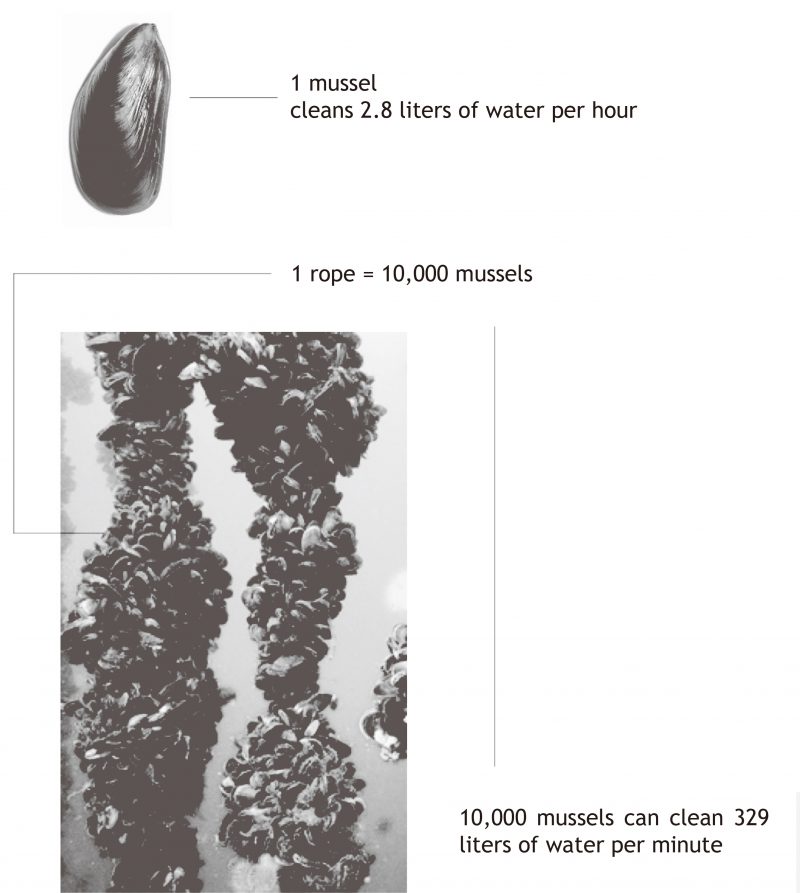
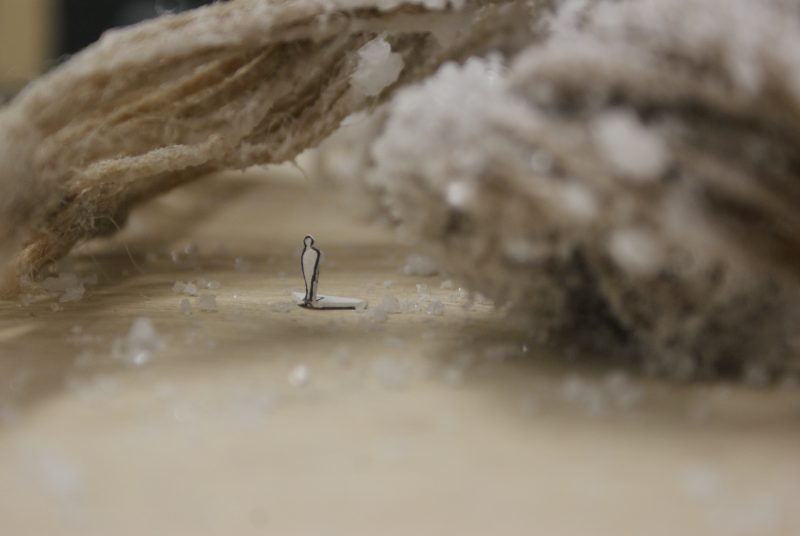
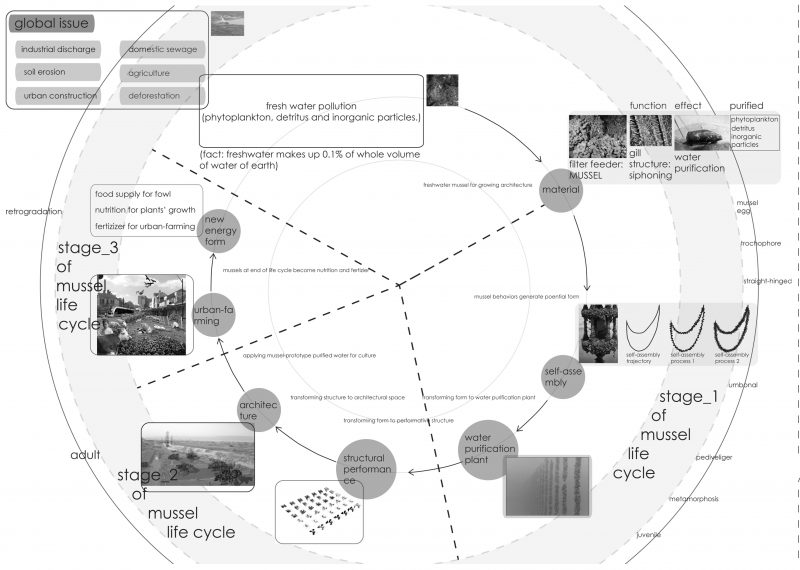
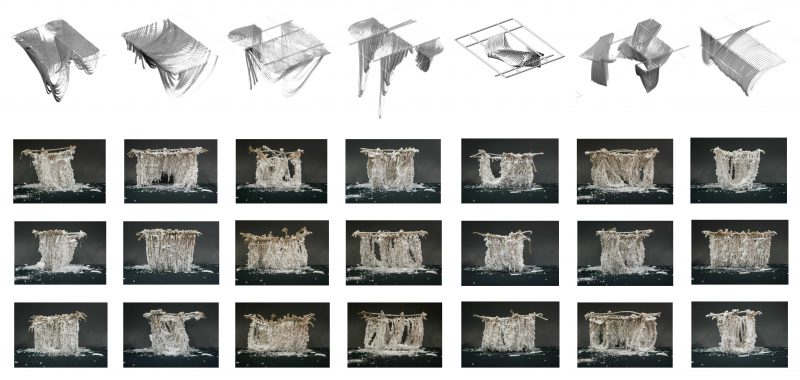
Students
- Akinori Hamada
- Taichi Kuma
- Shuhei Tanaka
Professor
- Yusuke OBUCHI
Course Assistants
- Toshikatsu KIUCHI
- So SUGITA
Intro: An electricity plant that generates power through a chemical reaction. Electricity is generated at the point where salt water and factory runoff water meet. The power plant is established as a park and is capable of connecting residential and industrial areas.
イントロ: 化学反応で発電する電力プラント。塩水と工場流出水の合流地点で電気が生成されます。発電所は公園として確立されて、住宅および工業地域と接続することが可能です。
Raw Material: Brackish water at a site where river water and sea water meet. Electricity is produced at this point due to the mixing of salt water and fresh water. Purified water results as a by-product. The existing power plant in the area divides the river and the sea, thus impacting the flow of water and the local environment.
原料:淡水と海水が混ざることで発生する汽水性の水。電気は、この汽水域で淡水と海水の混合で発生します。浄化された水が副産物として精製されます。従前の発電所は川と海を分断してしまうため、汽水を変換・応用することで新しいエネルギー資源となり、従って水の流れおよび周辺環境に良いインパクトを与えます。
Transformed Material: Sea and river water (mixed) pass through a membrane which removes impurities and ions. Purified water is produced through the process.
材質変換:海水や淡水の混合水は、不純物やイオンを除去する膜を通過します。精製水は、このプロセスを経て作られます。
Architectural Prototype: Capsules float on the salty sea water, but beneath the river water. The architecture thus floats on the boundary surface between the two layers. Its level (and thus, the habitable area of the zone) changes with the tides. This creates an adaptive floating bridge which changes position. The membranes required to produce the purified water and the energy are placed inside the floating capsules, which are connected together.
建築的プロトタイプ:カプセルは、海水の上、淡水の下に浮かびます。こ の建築はこうして 2 つの層の境界面に浮かんでいます。カプセルの浮遊深度や居住できるゾーンが潮に応じて変わります。1 日を通して位置が変更する適応型浮体橋が結果としてできます。精製水とエネルギーを生成するために必要な膜は、浮動カプセルに内蔵され、全カプセルは接続されている。
Urban Prototype: The power plant generates energy, provides purified water, and creates an adaptive bridge space. It can connect residential and industrial areas and provide a community center around which shopping and educational facilities can be situated. Because of the shifting tide levels, the area can provide an interesting user experience. It can boost the local economy with shopping and sightseeing, in addition to generating power.
都市的プロトタイプ:この発電所は、エネルギーを生成し、精製水を提供し、適応型浮体橋の空間を作成します。それを周辺の住宅や工業地域に接続することで、ショッピング、教育や利便性の高いプログラムに囲まれたコミュニティ センターができます。潮の満ち干きで変化する高低差によって、興味深いユーザー エクスペリエンスを提供できます。それは、発電に加え、ショッピングと観光といった地域経済を高める要素に寄与できます。
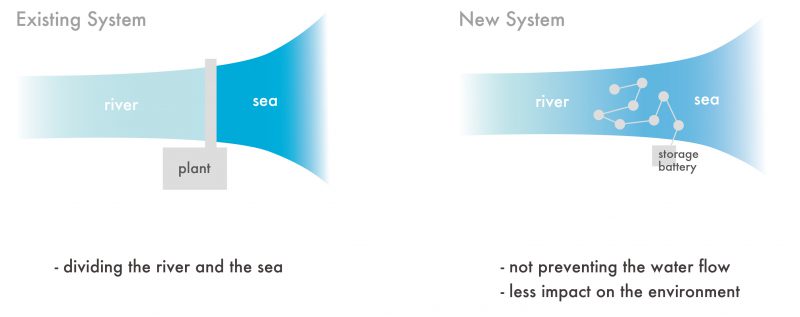
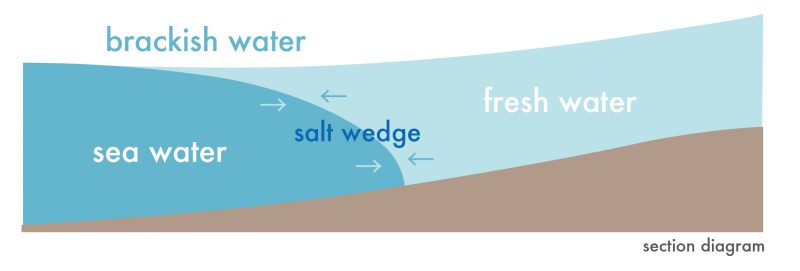
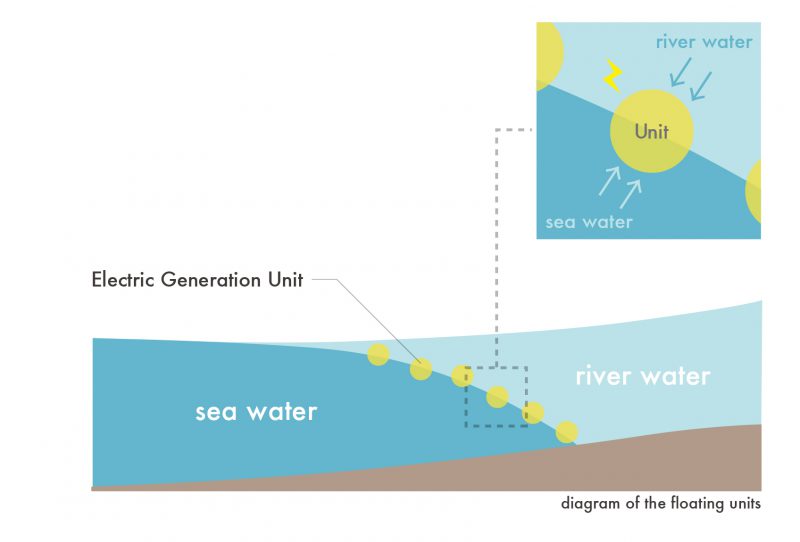
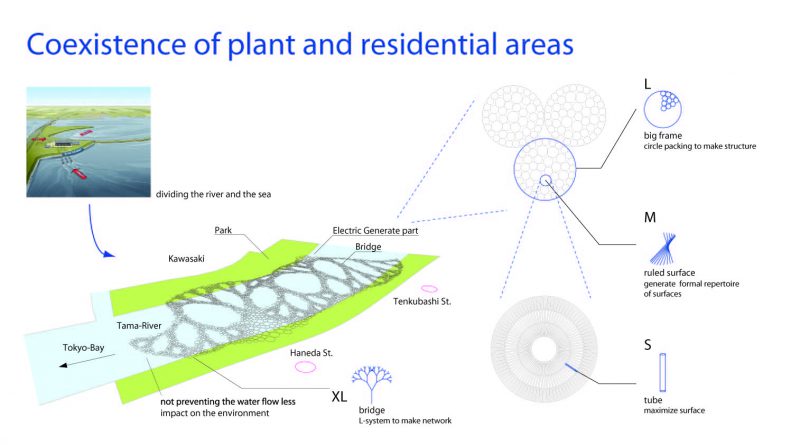

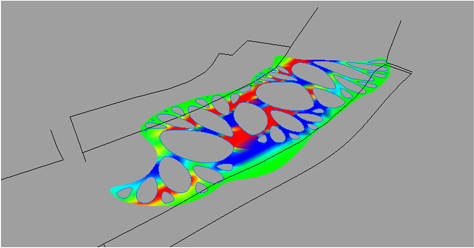
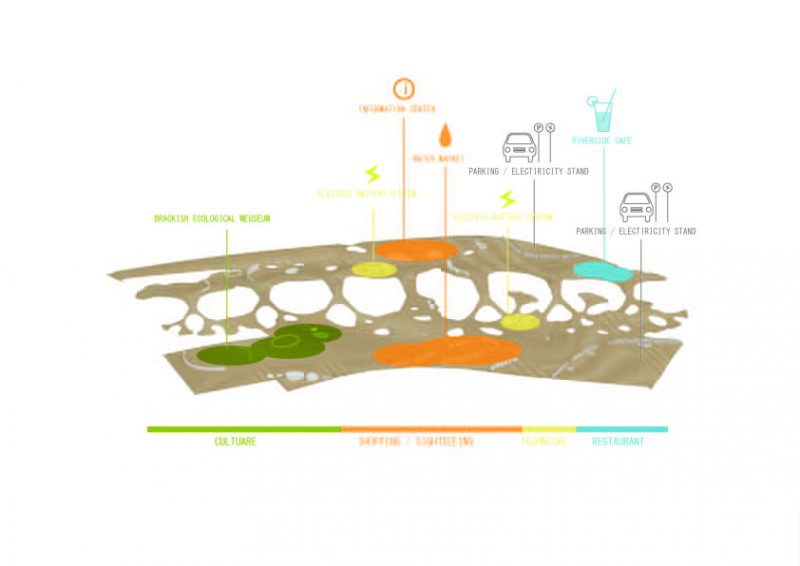
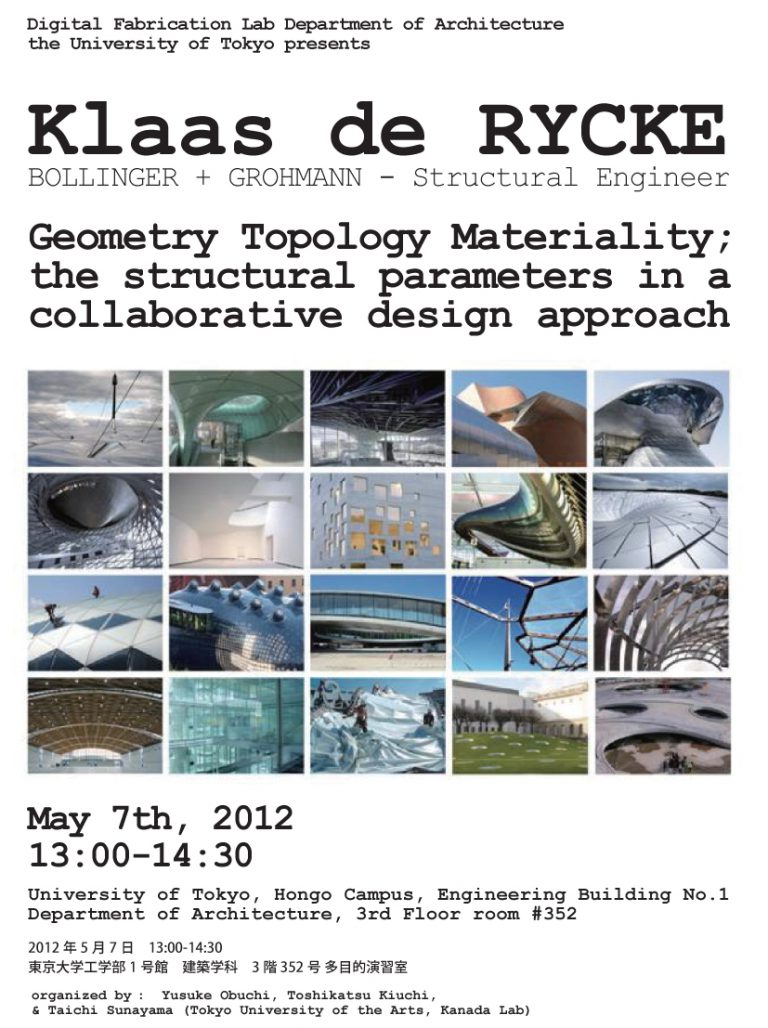
Lecture: Geometry Topology Materiality; the structural parameters in a collaborative design approach
Speaker: Klaas de Rycke, Structural Engineering, BOLLINGER + GROHMAN
May 7, 2012
13:00-14:30
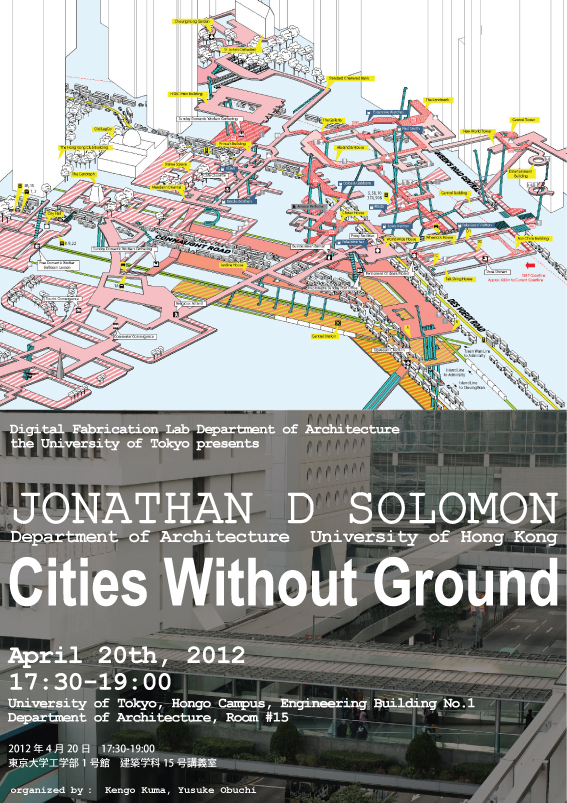
Lecture: Cities Without Ground
Speaker: Jonathan D Solomon, Department of Architecture, University of Hong Kong
April 20, 2012
17:30-19:00
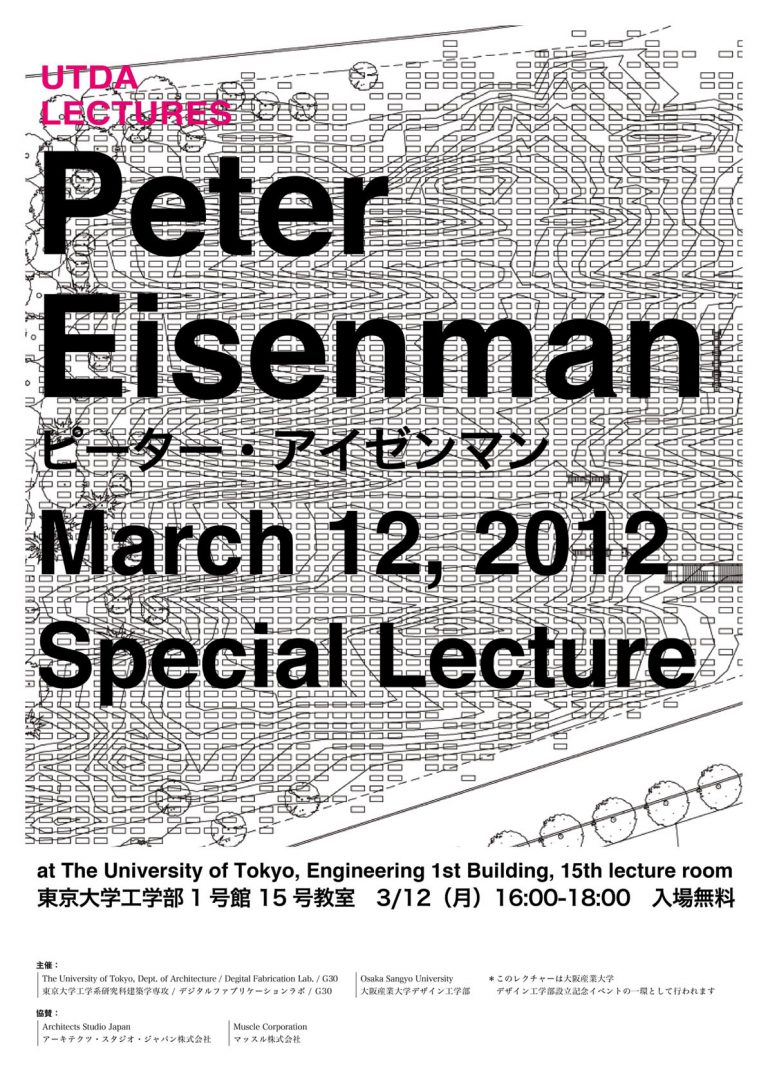
Special Lecture by Peter Eisenman
March 12, 2012
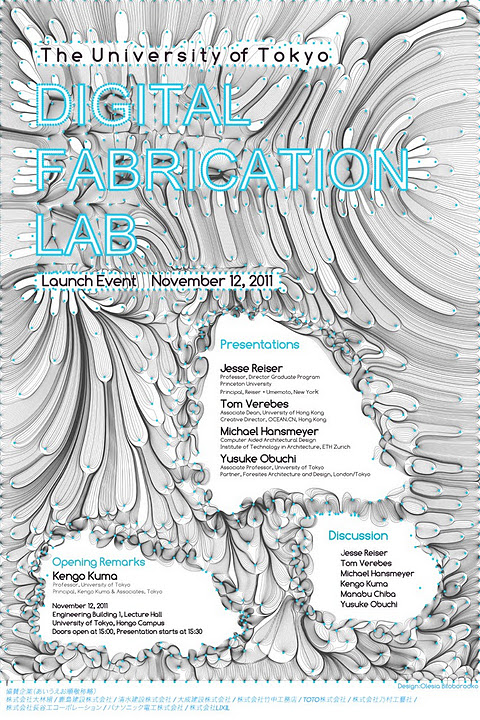
The University of Tokyo Digital Fabrication Lab Launch Event
March 15, 2011 (Tuesday)
16:00
Presenters:
Jesse Reiser
Tom Verebes
Michael Hansmeyer
Yusuke Obuchi
Opening Remarks by:
Kengo Kuma
Discussion:
Jesse Reiser
Tom Verebes
Michael Hansmeyer
Kengo Kuma
Manabu Chiba
Yusuke Obuchi
Minimal Surface Pavilion
Project Team : Jeep Prinya Narongthanarath, Taichi Kuma, Akinori Hamada, Deli Zhao, Olesia Biloborodko, Colin Lin Xuhao, Chong Wang, Mickey Htoo, Yasemin Sahiner, Shuang Li, Maria Larsson, Ana Ilic, Guillaume Dumont, Dasom Lee, Yuta Ito, Ryo Saito, Risa Kagami, Lin Wang, Dana Milea
Yusuke Obuchi, Associate Professor
Kengo Kuma, Professor
Jun Sato, Associate Professor
Toshikatsu Kiuchi, Course Assistant
Featured at 2011 Tokyo Designers’ Week.
(As Featured in Shinkenchiku 2010:10)
Produced as part of a summer workshop with Columbia’s GSAPP (Graduate School of Architecture, Planning, and Preservation), the Digital Teahouse project was displayed on the plaza in front of Engineering Building #1 on the University of Tokyo’s Hongo Campus. The workshop aimed to integrate computational design and CNC fabrication methods to create a pavilion with real-world applicability.

